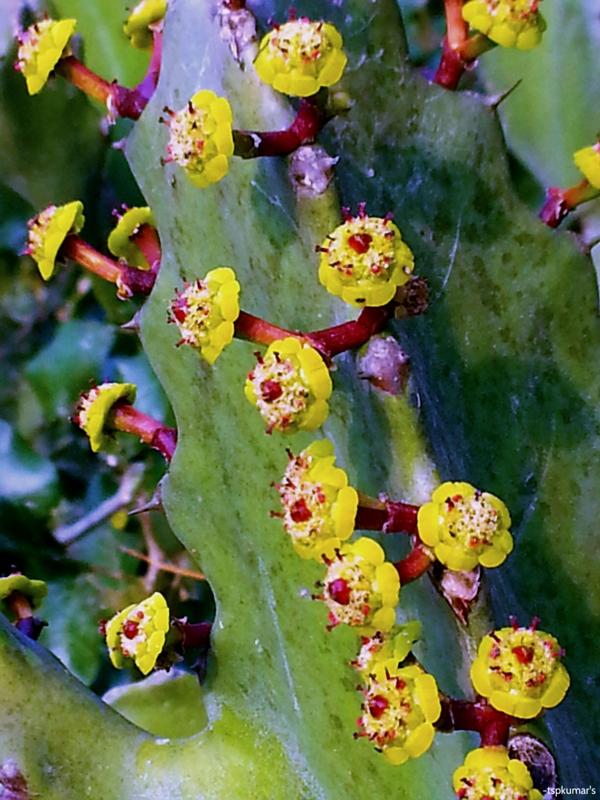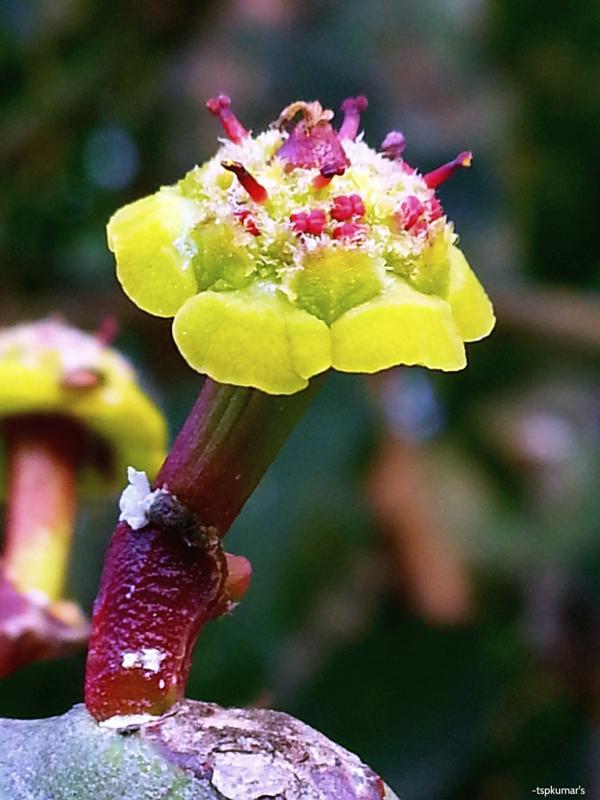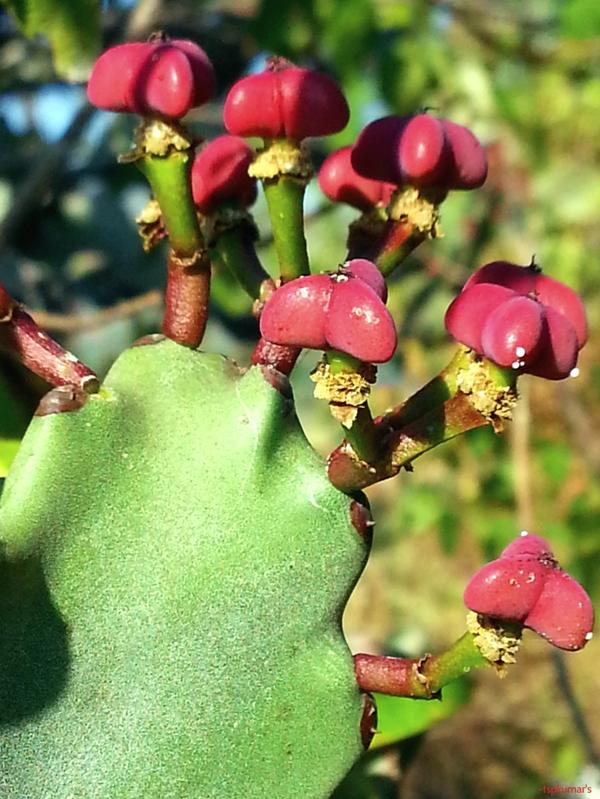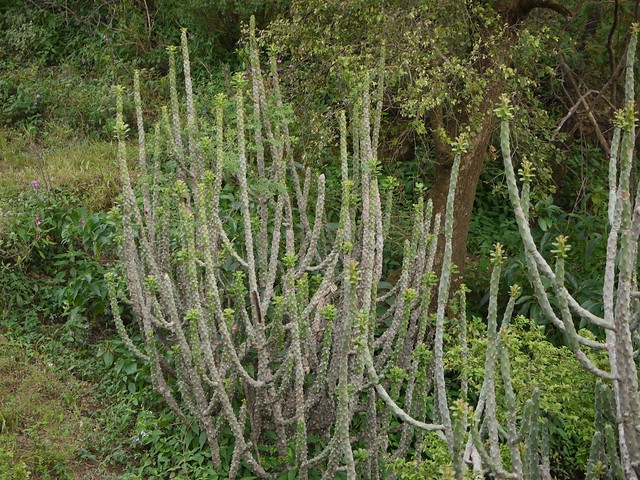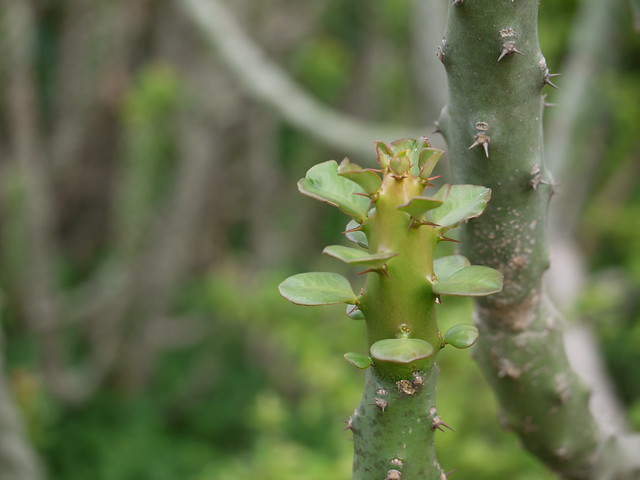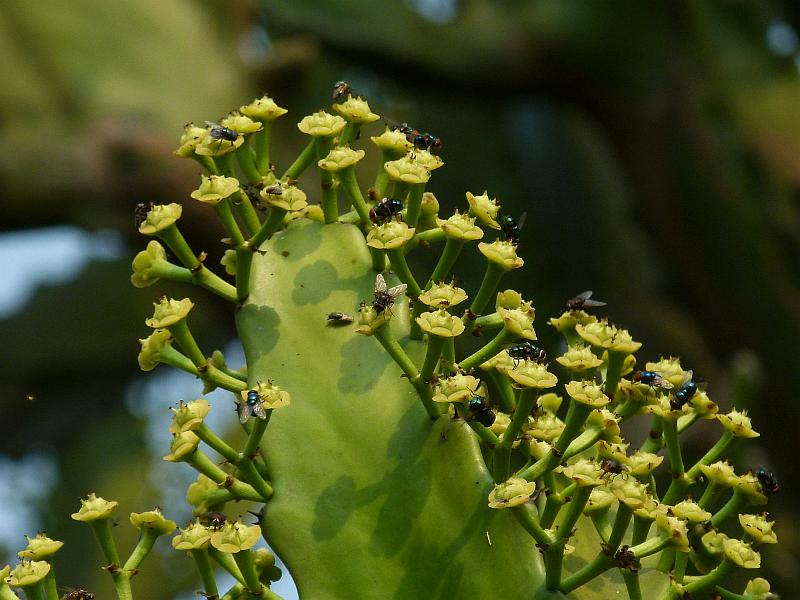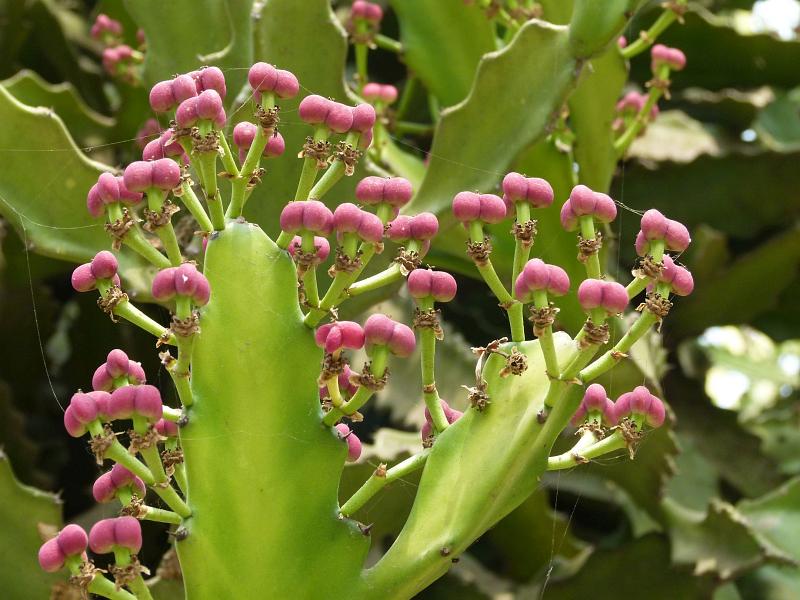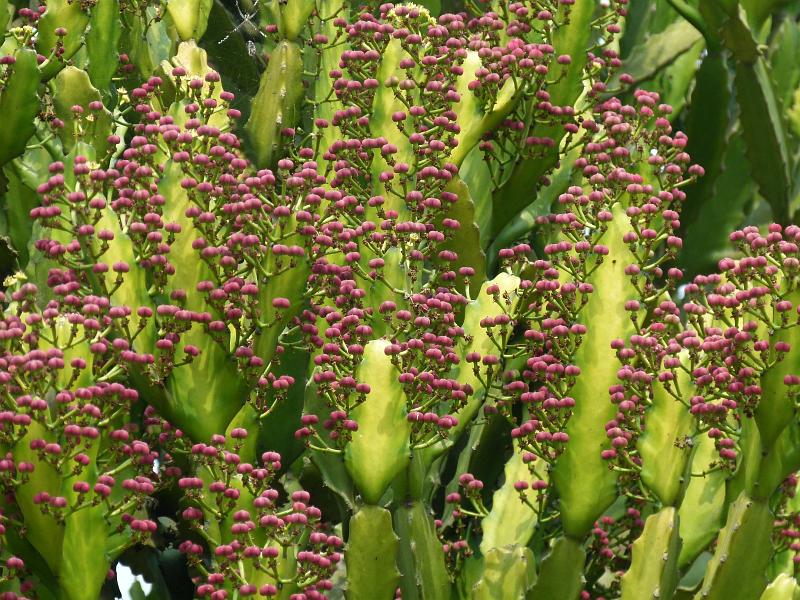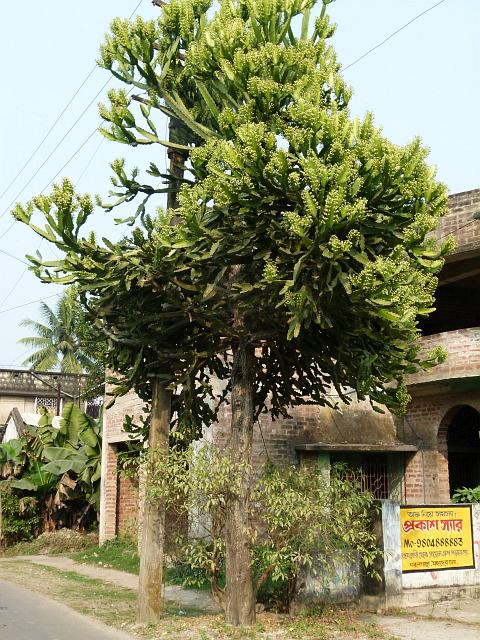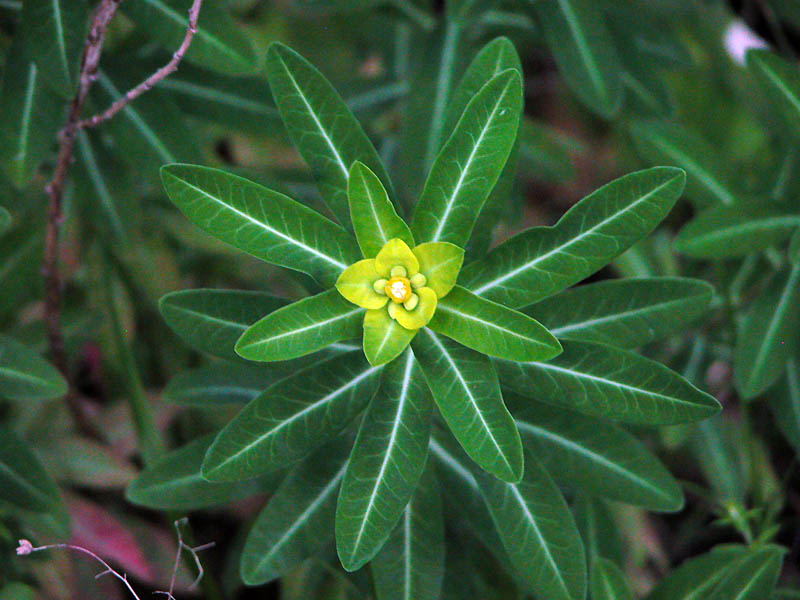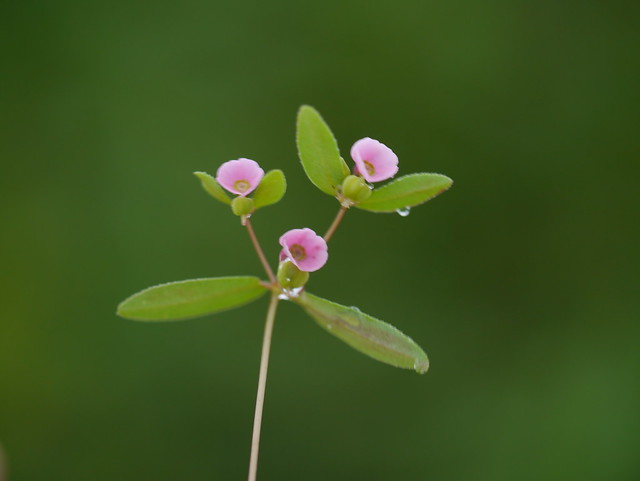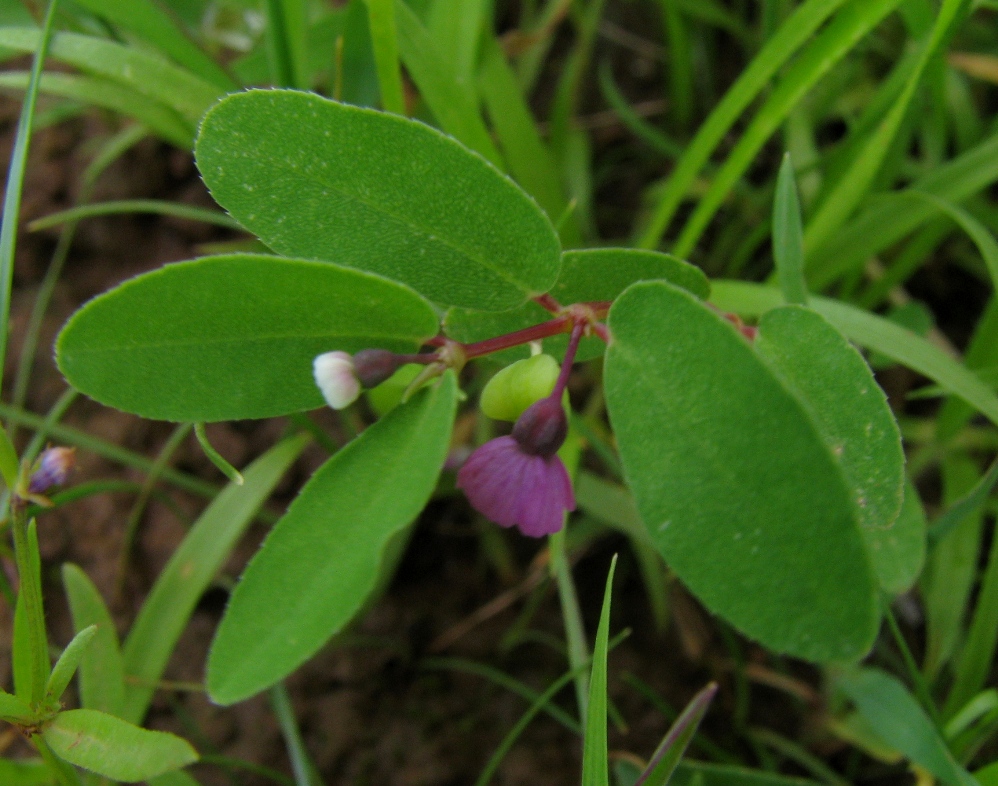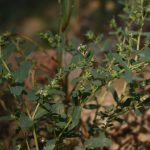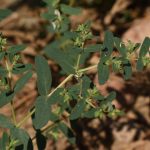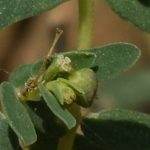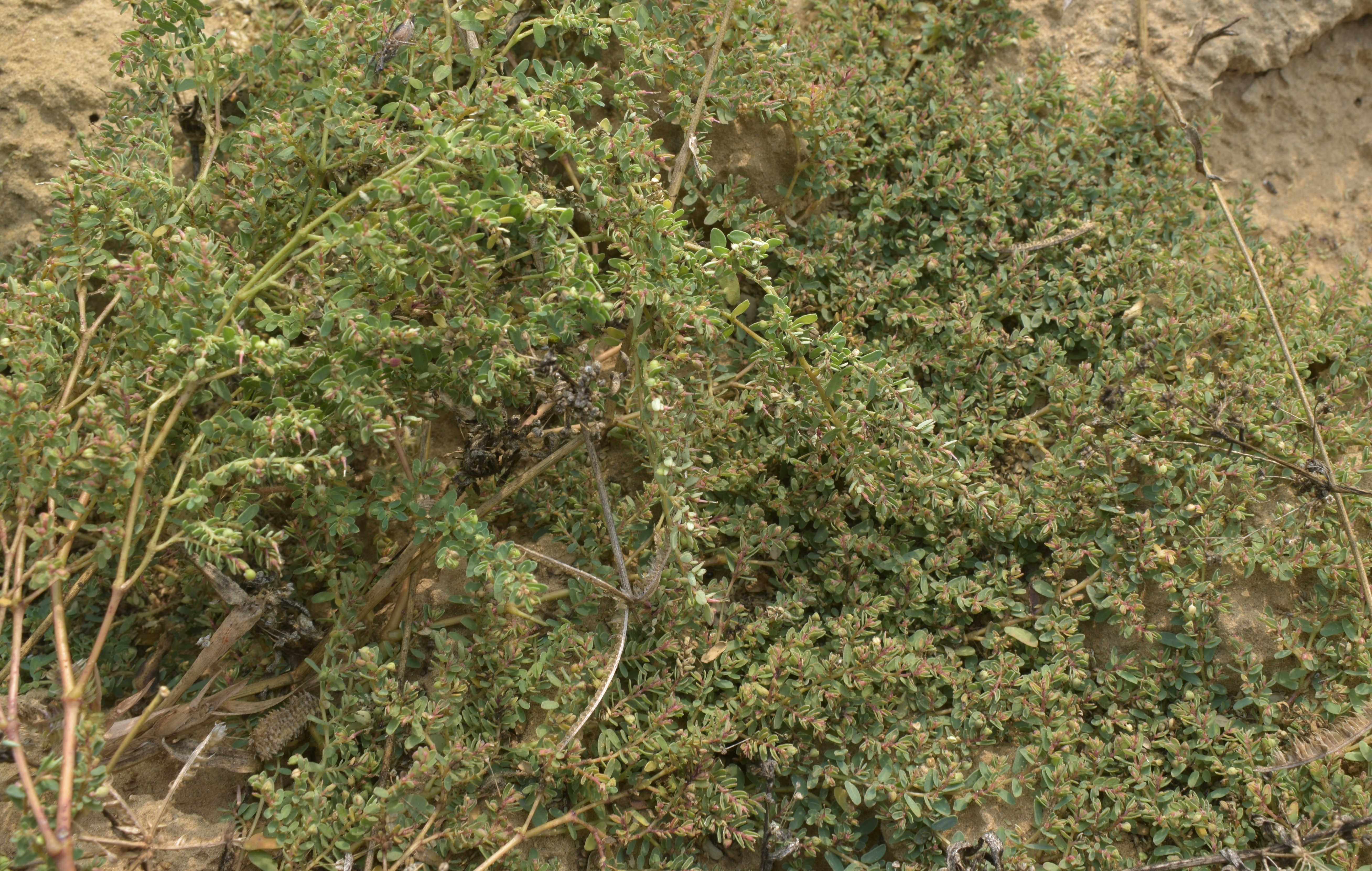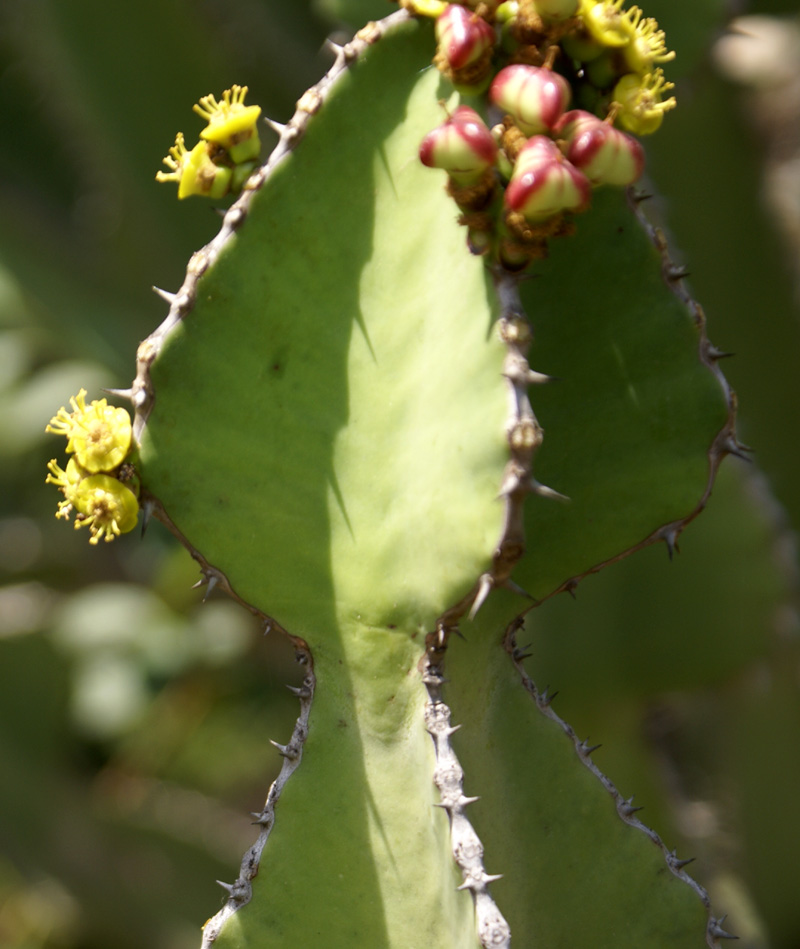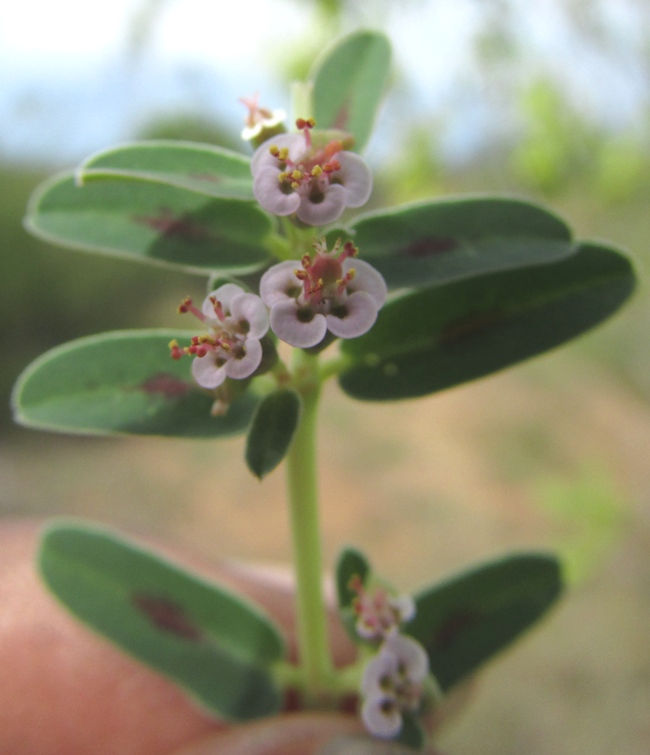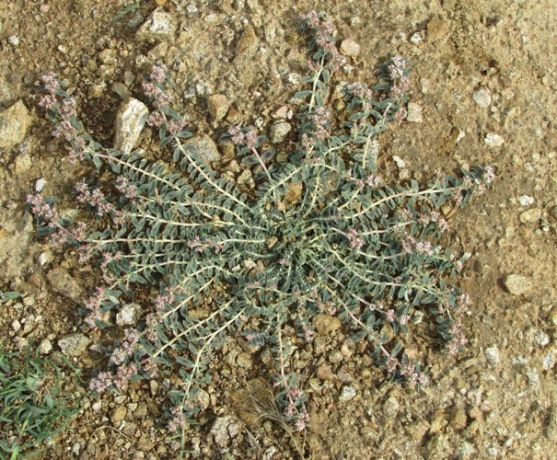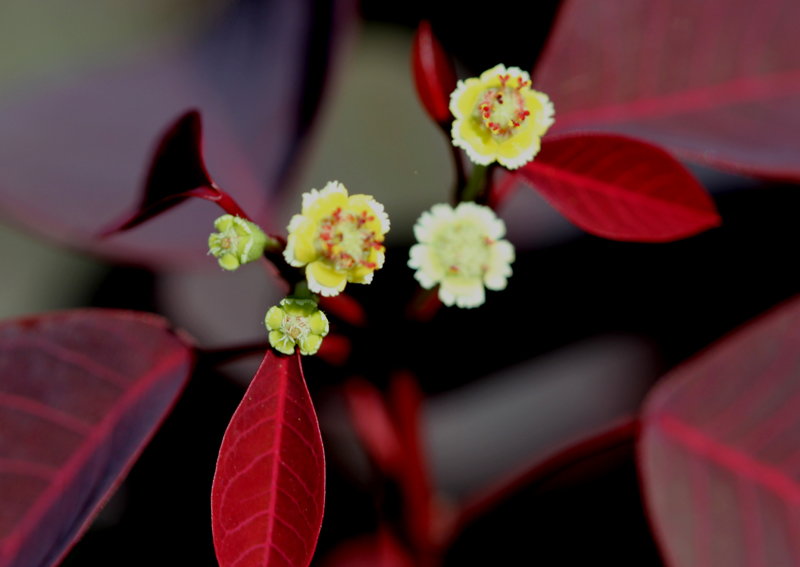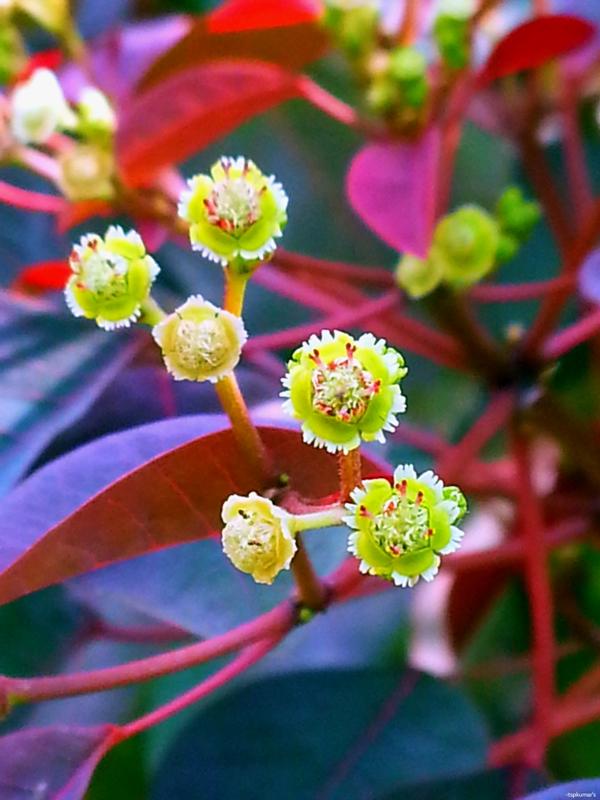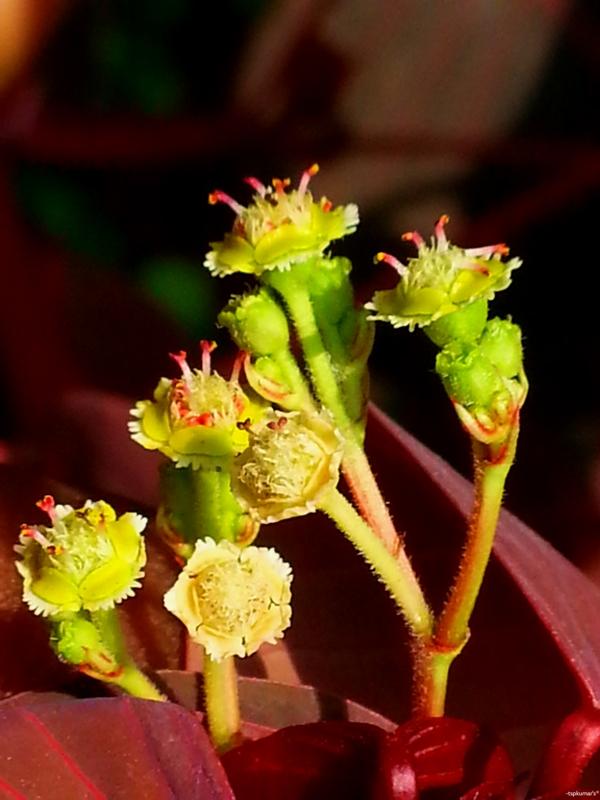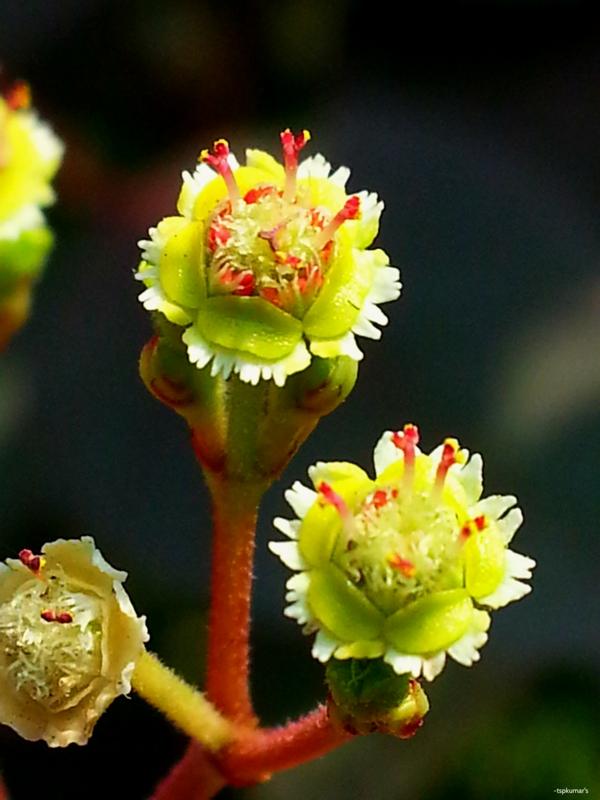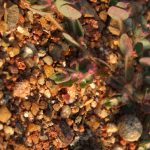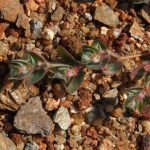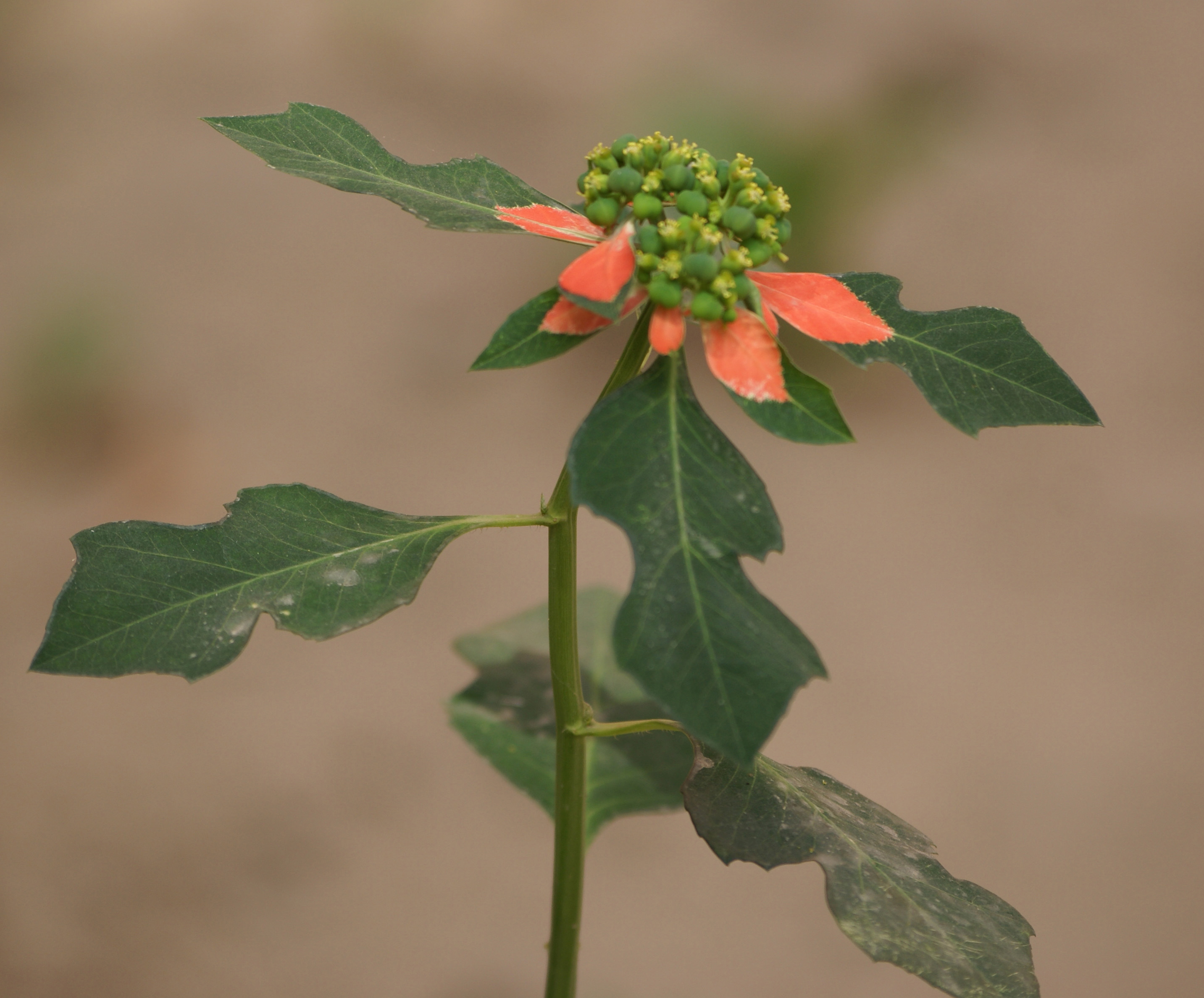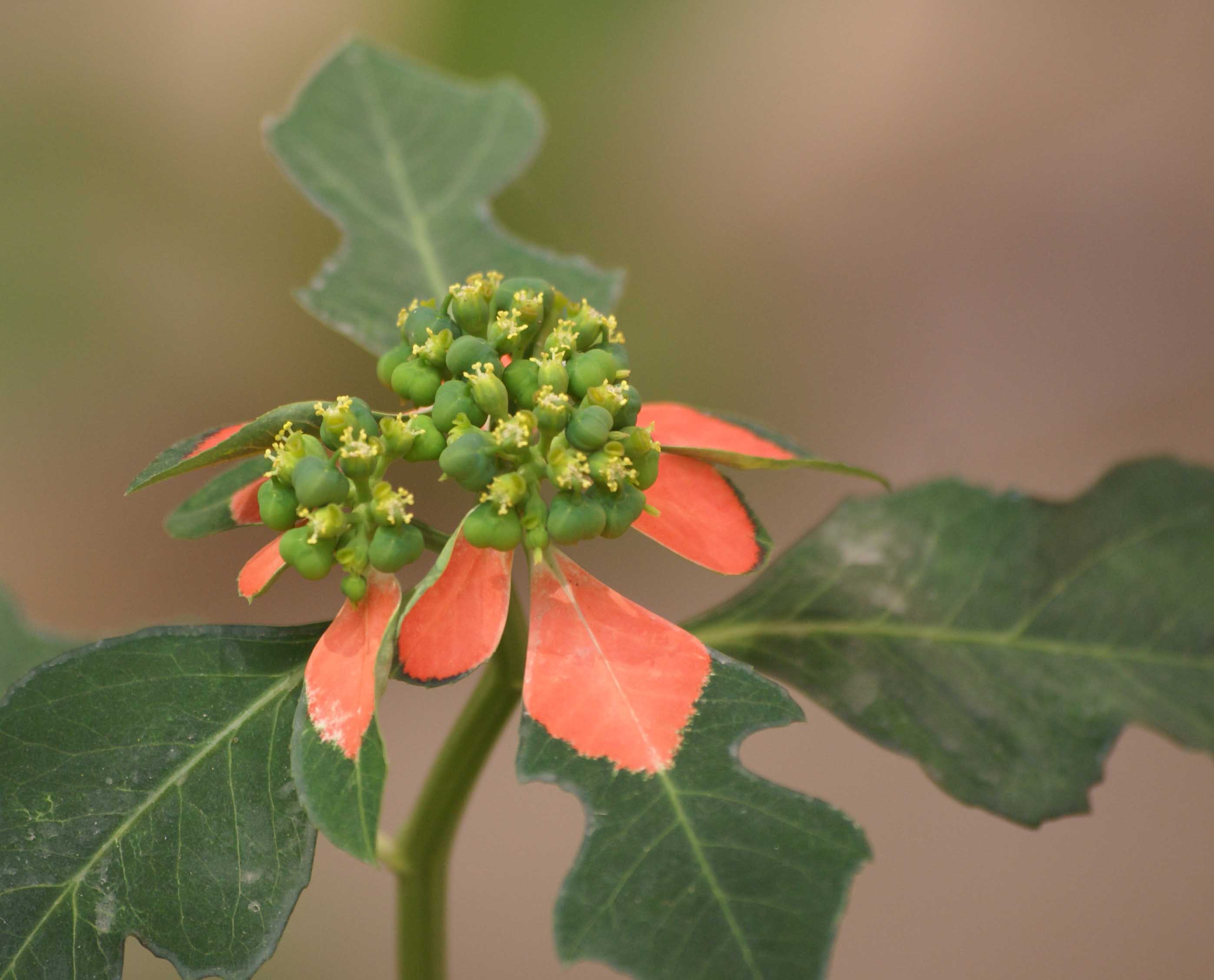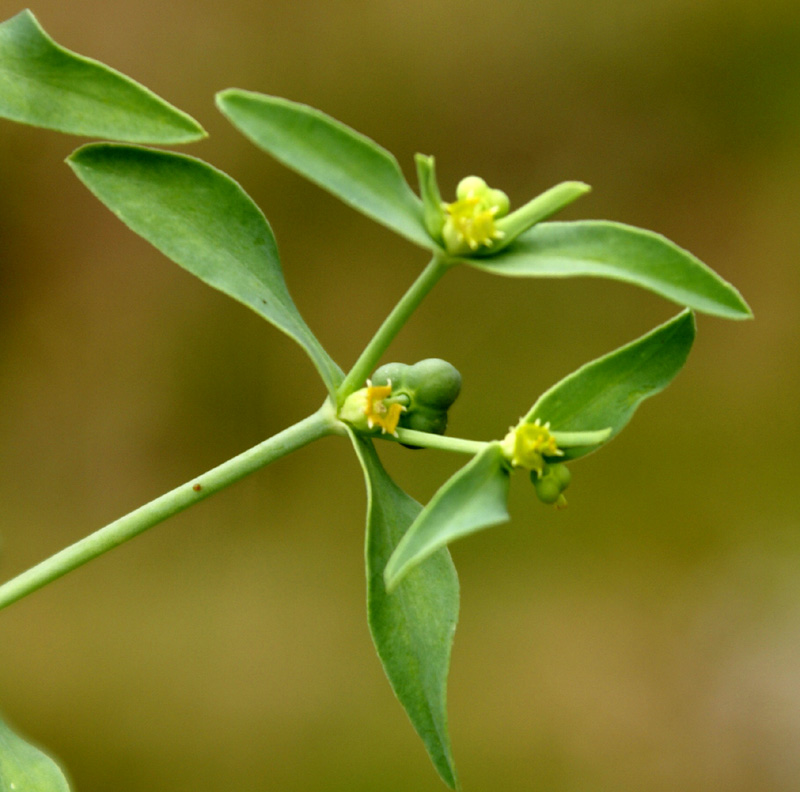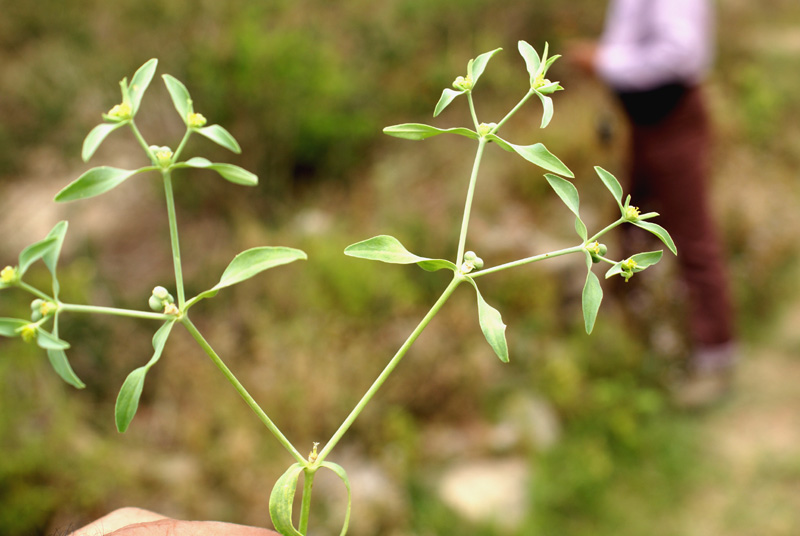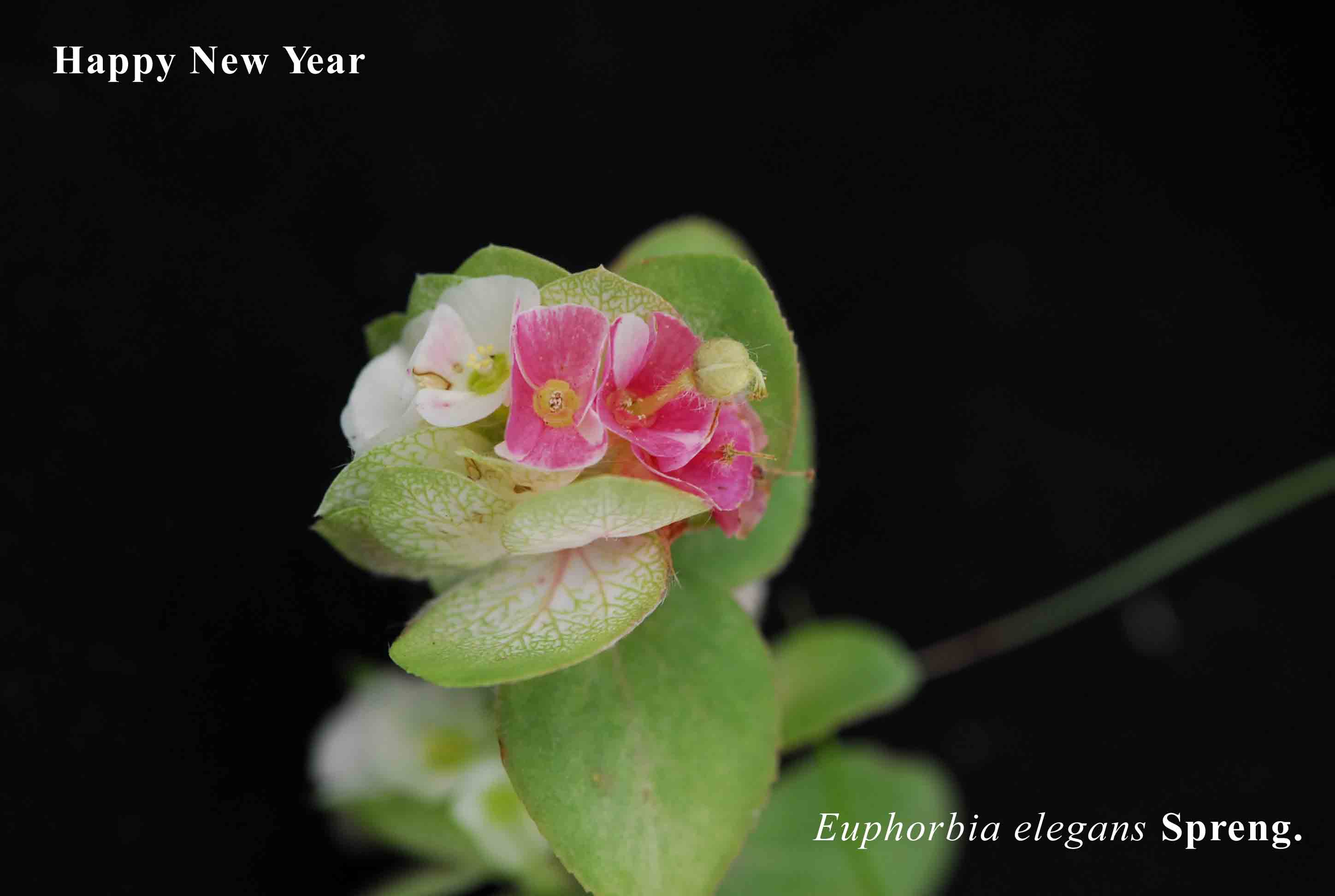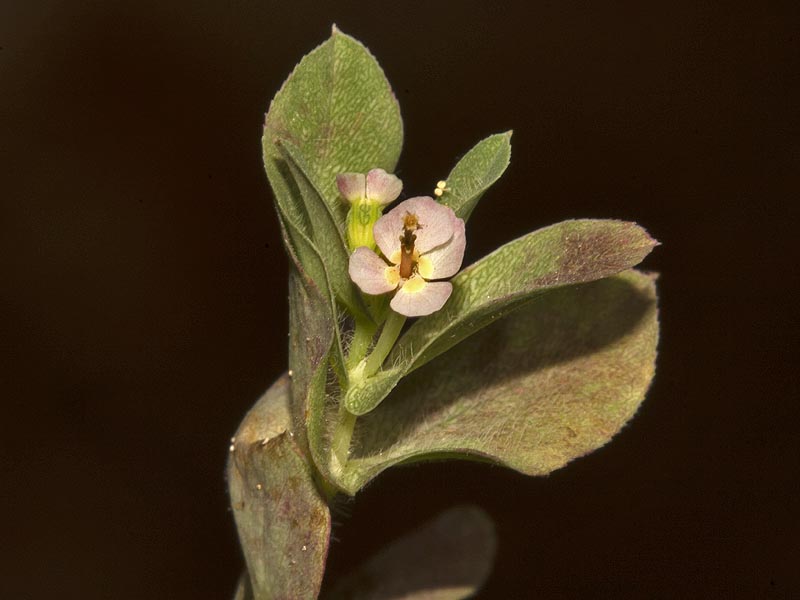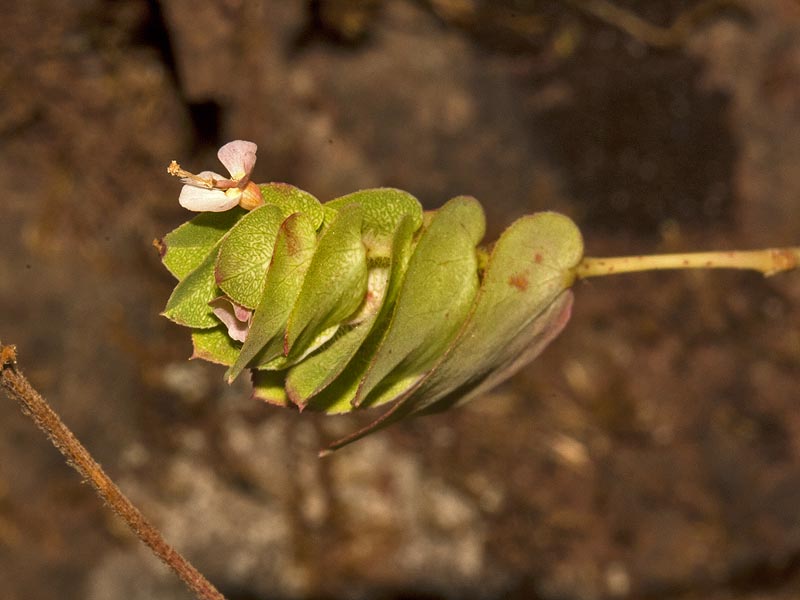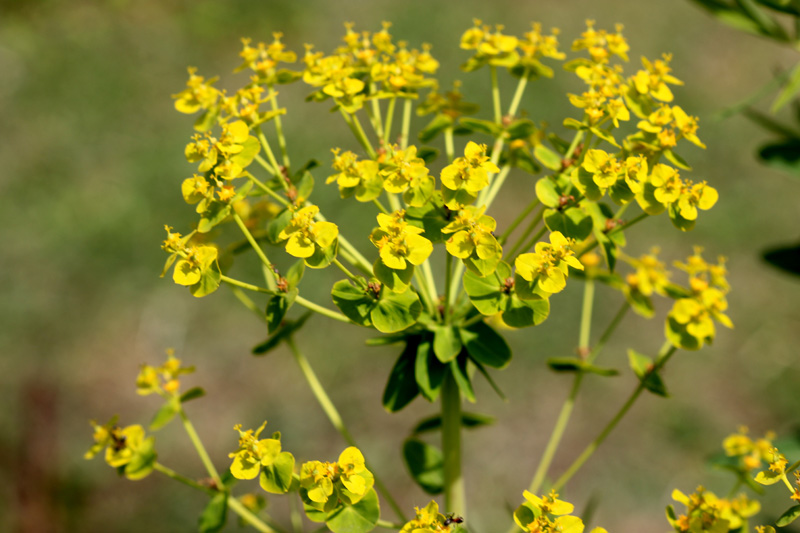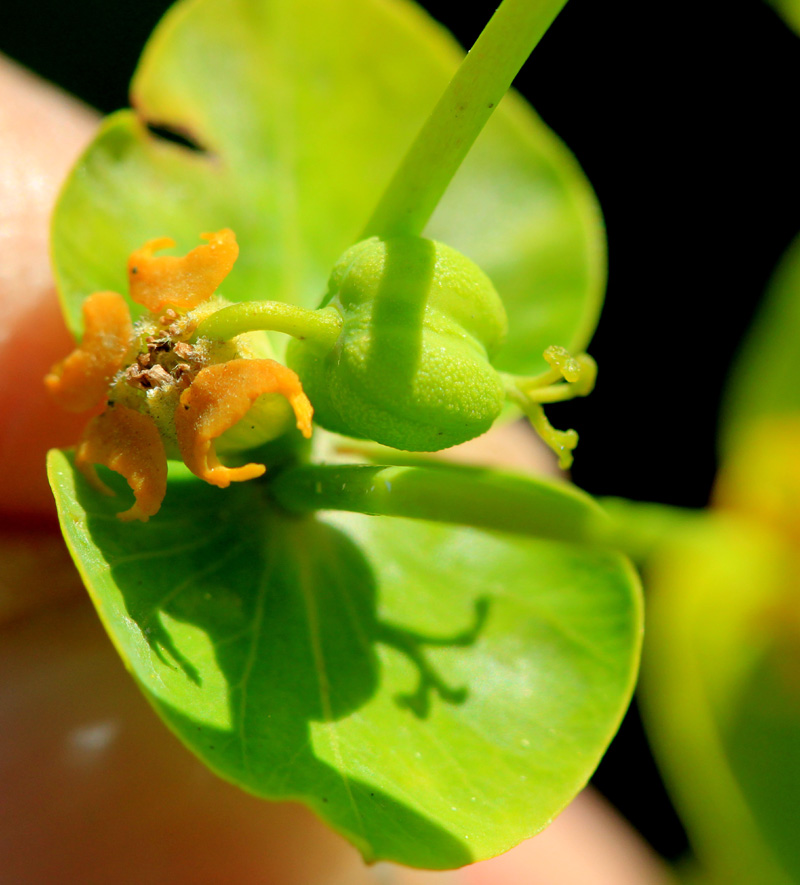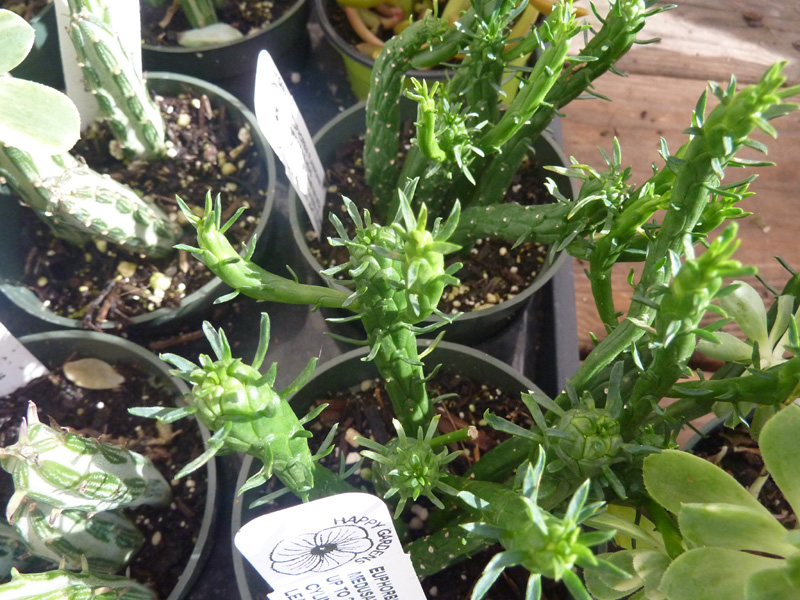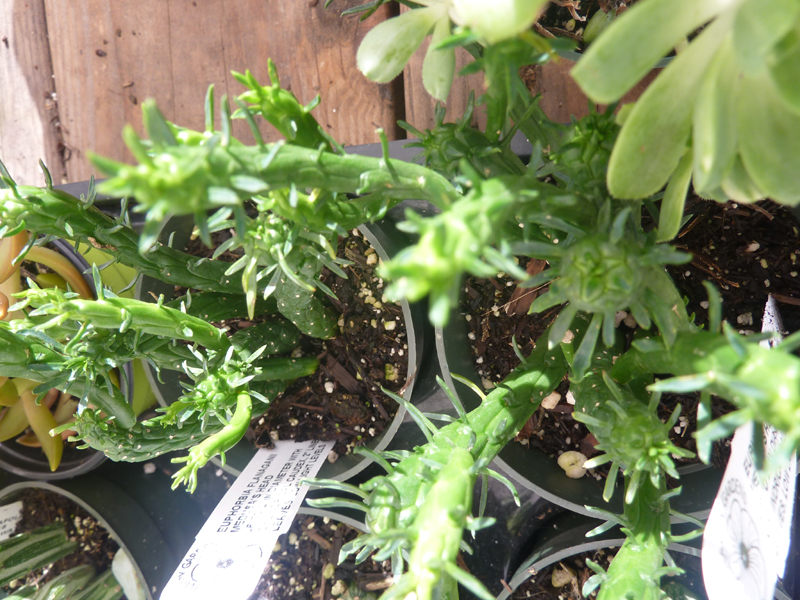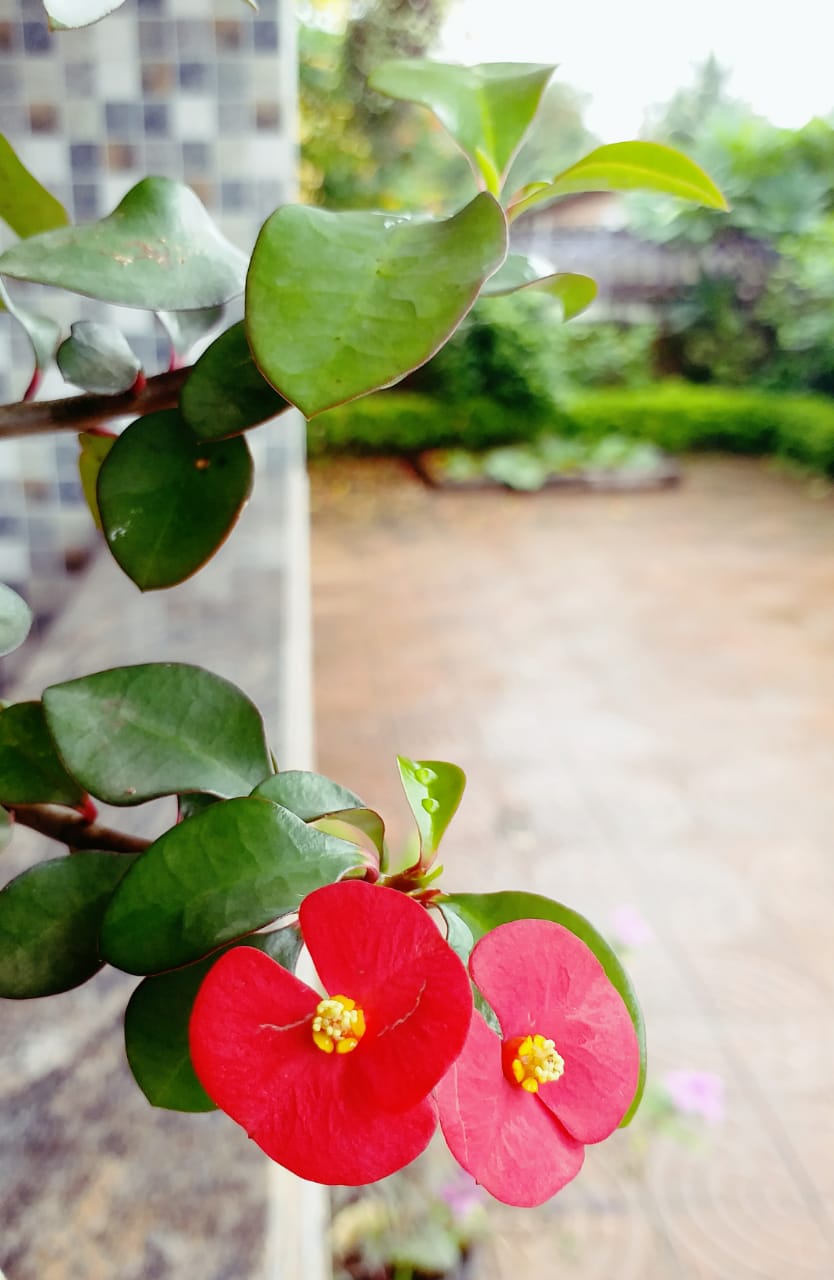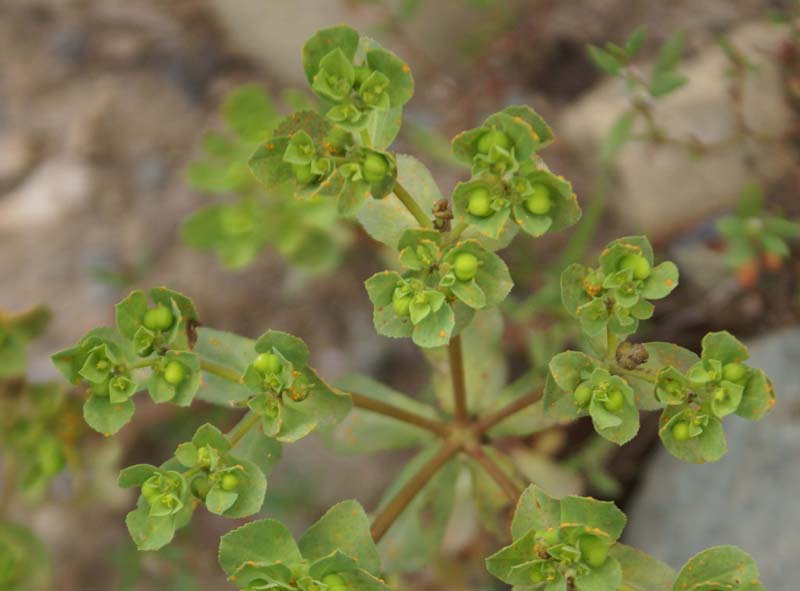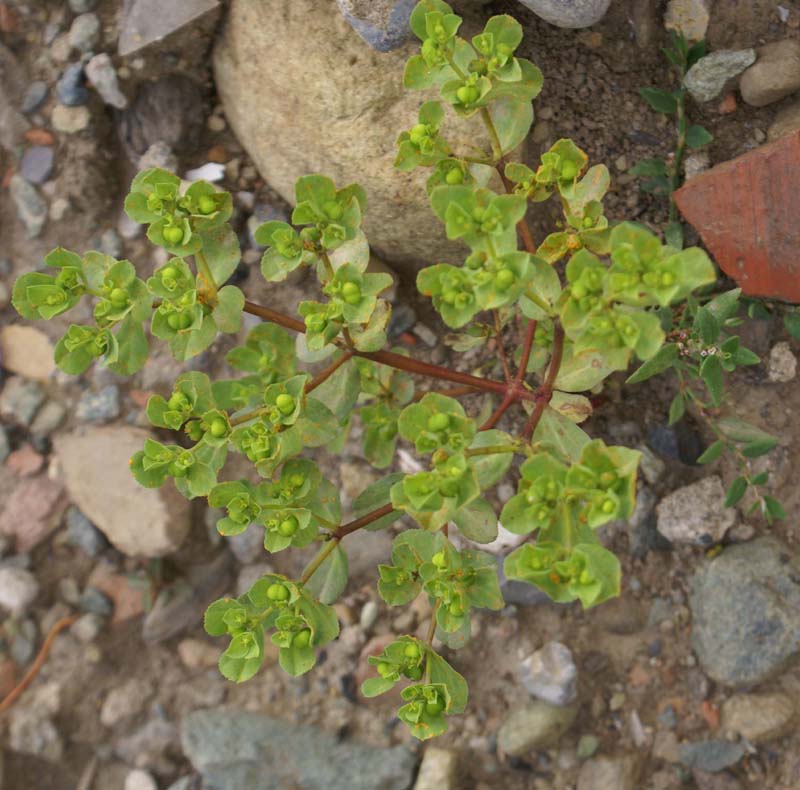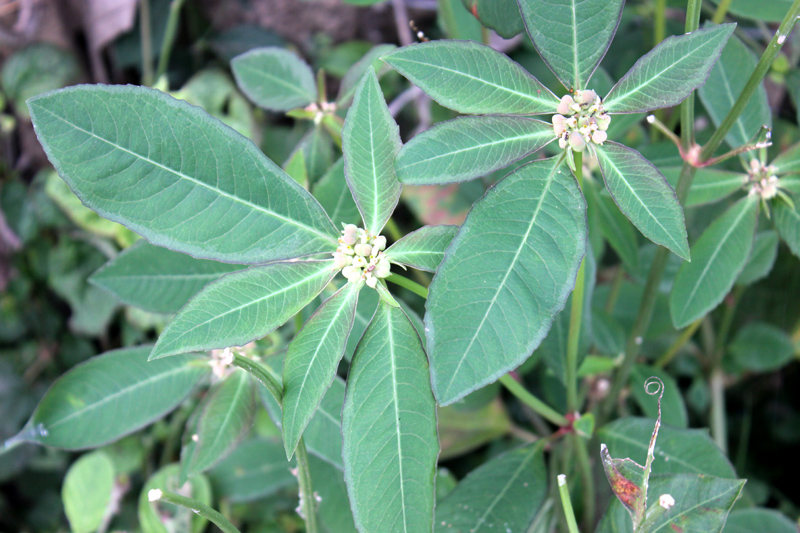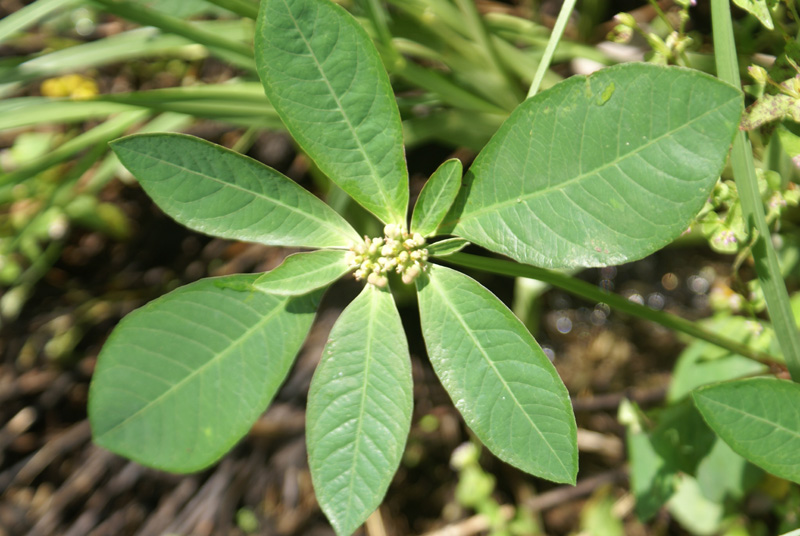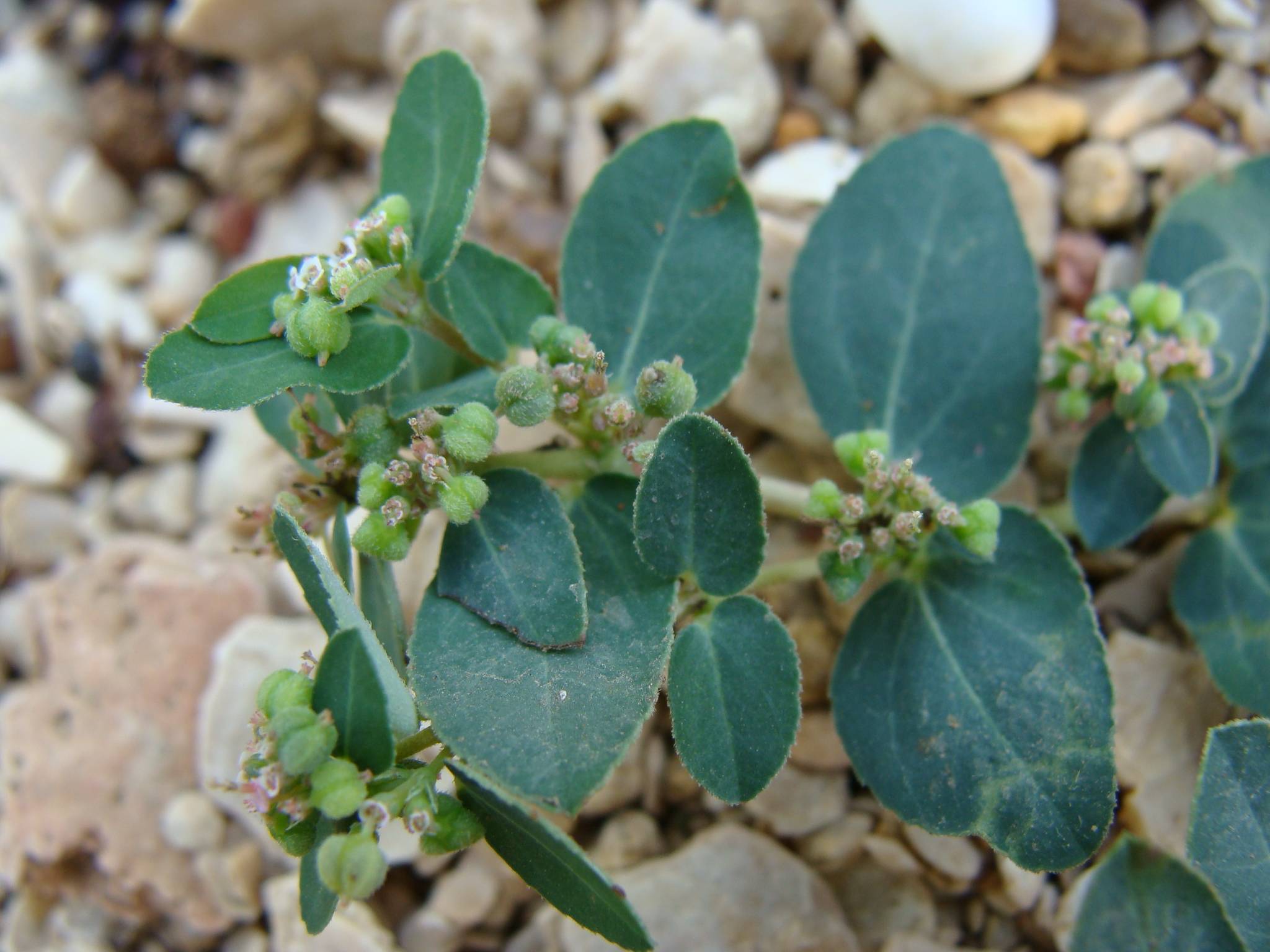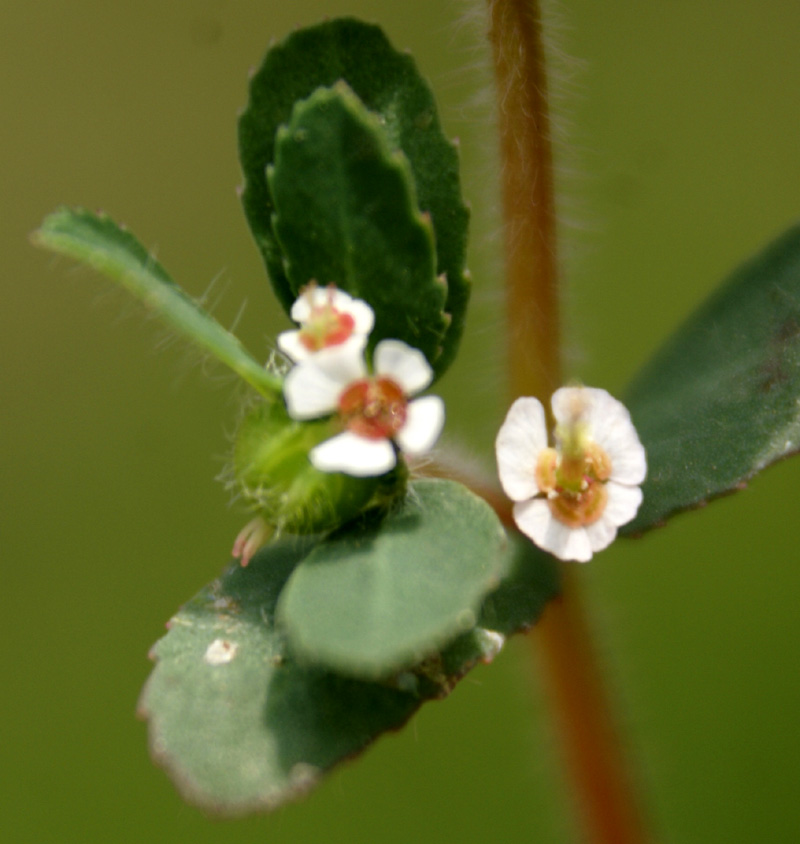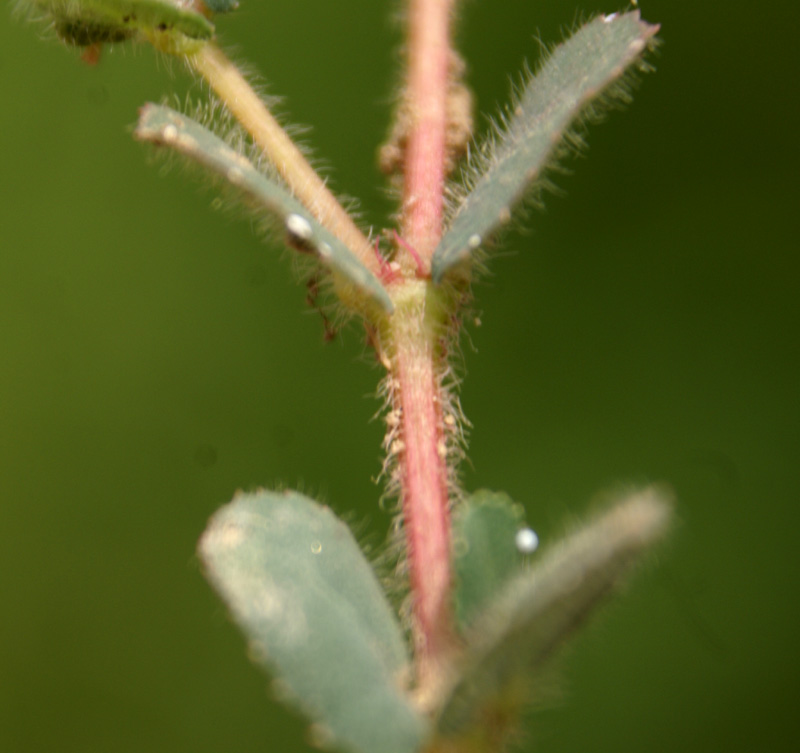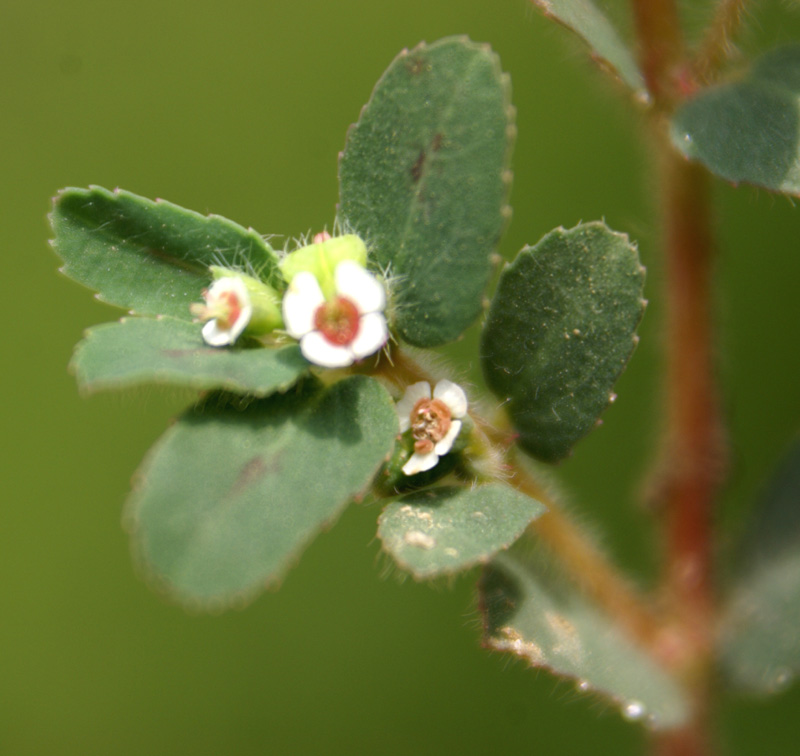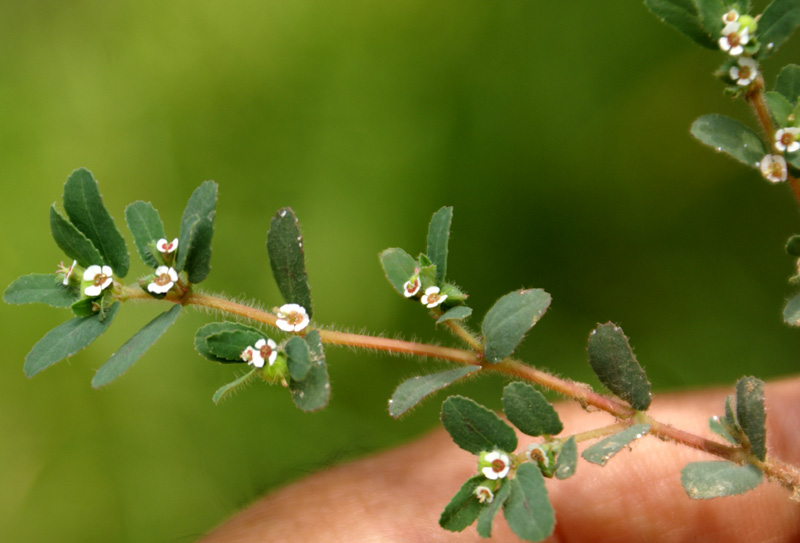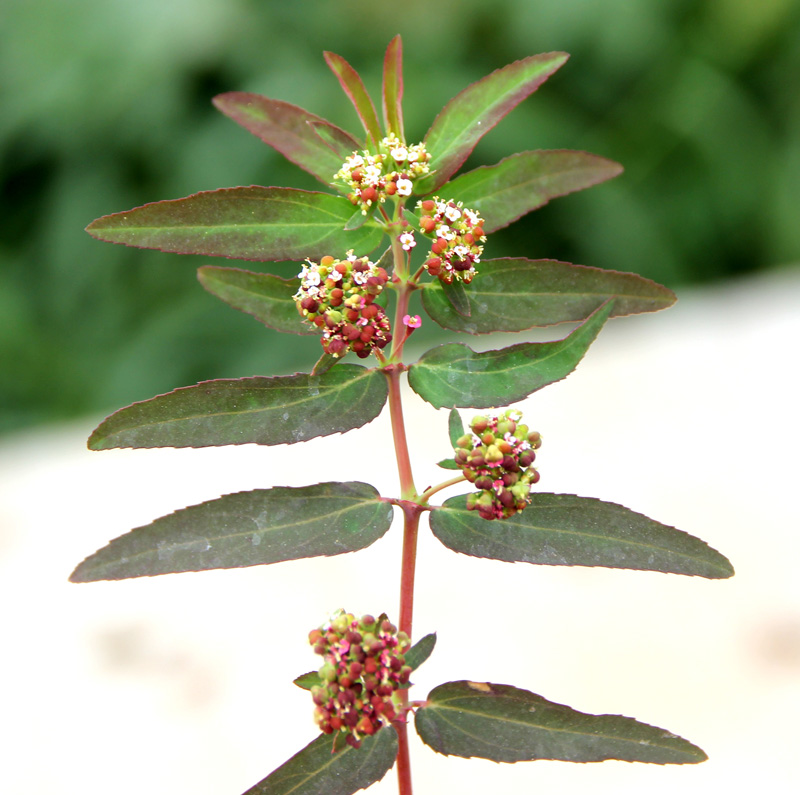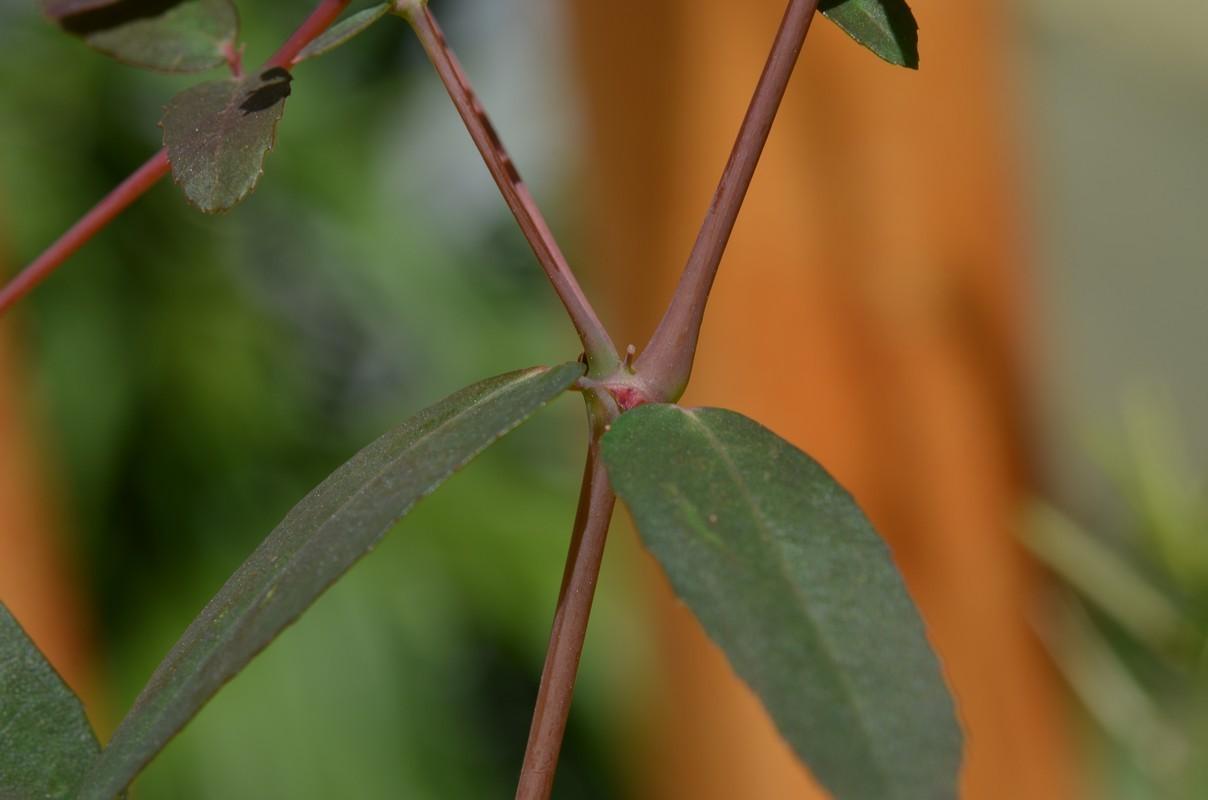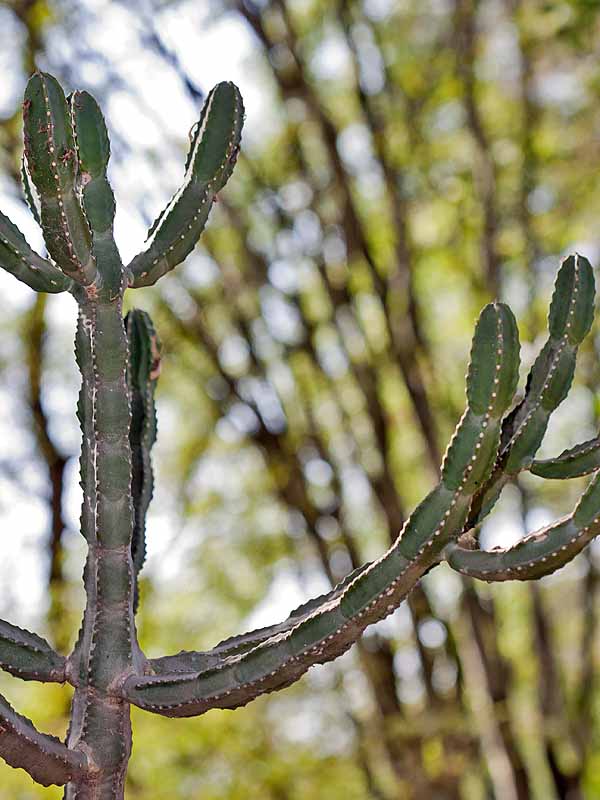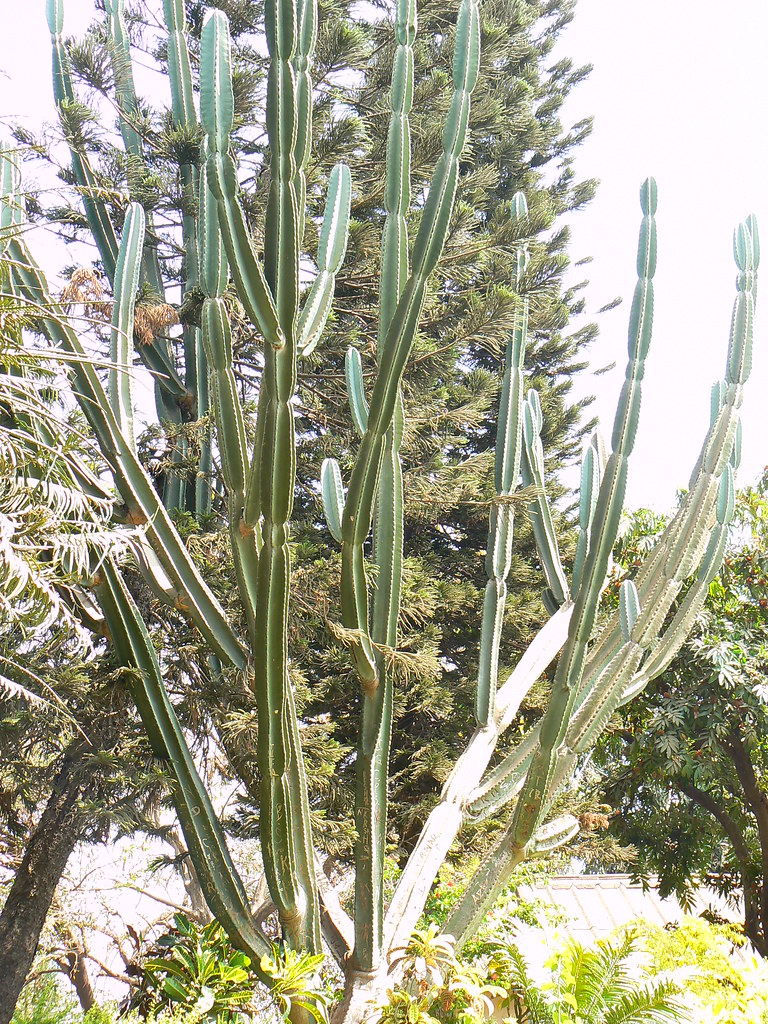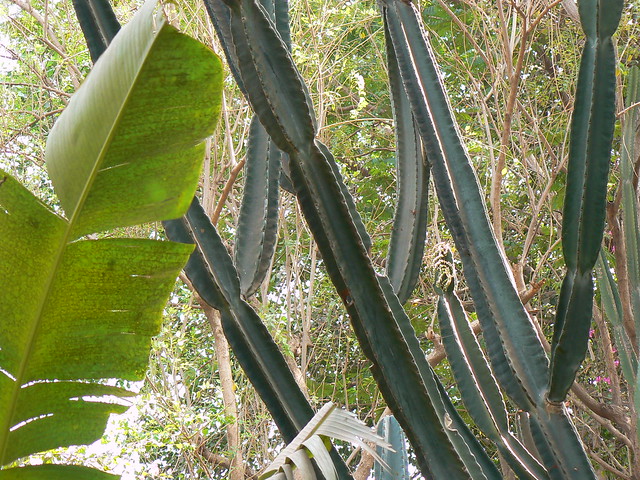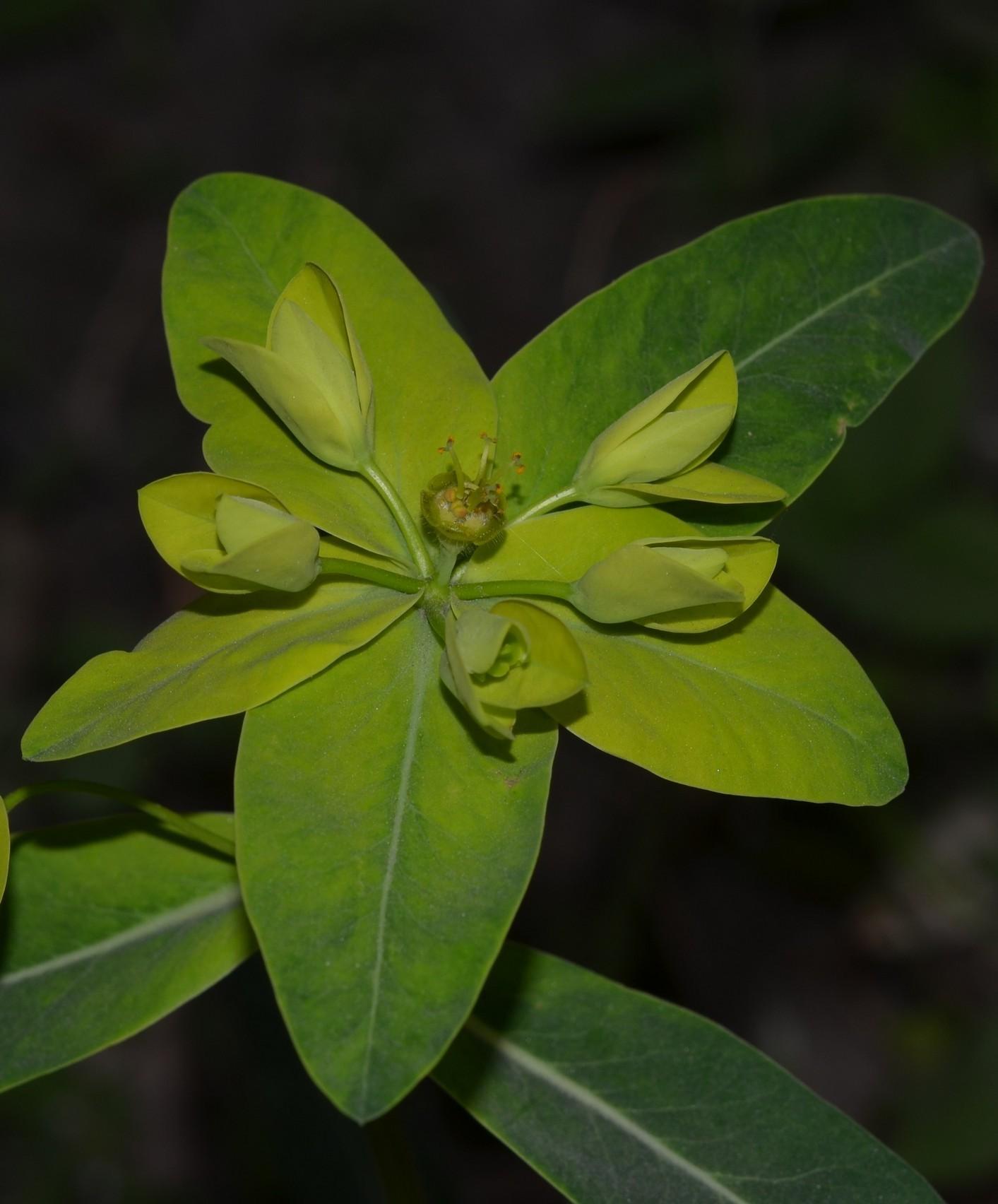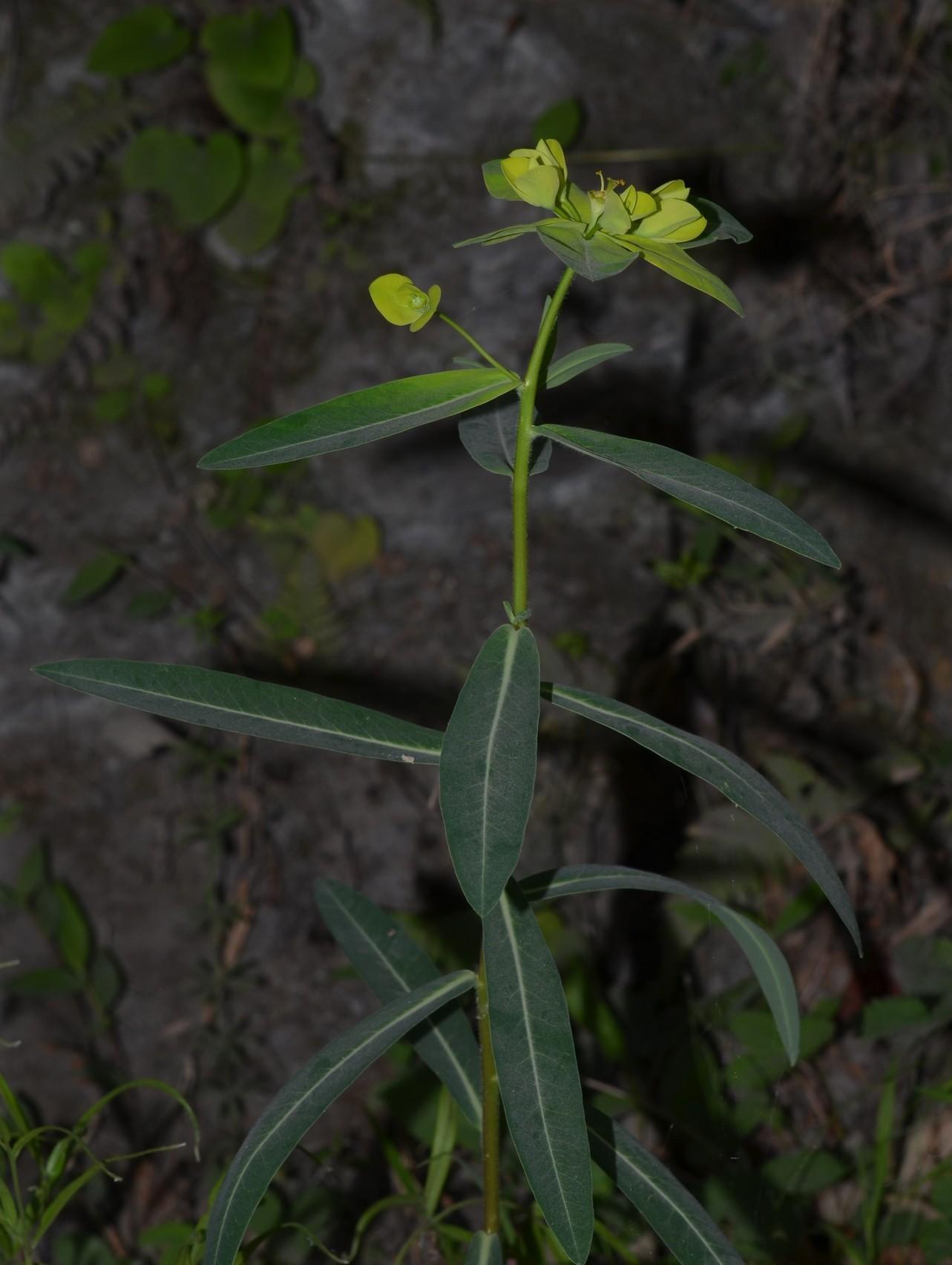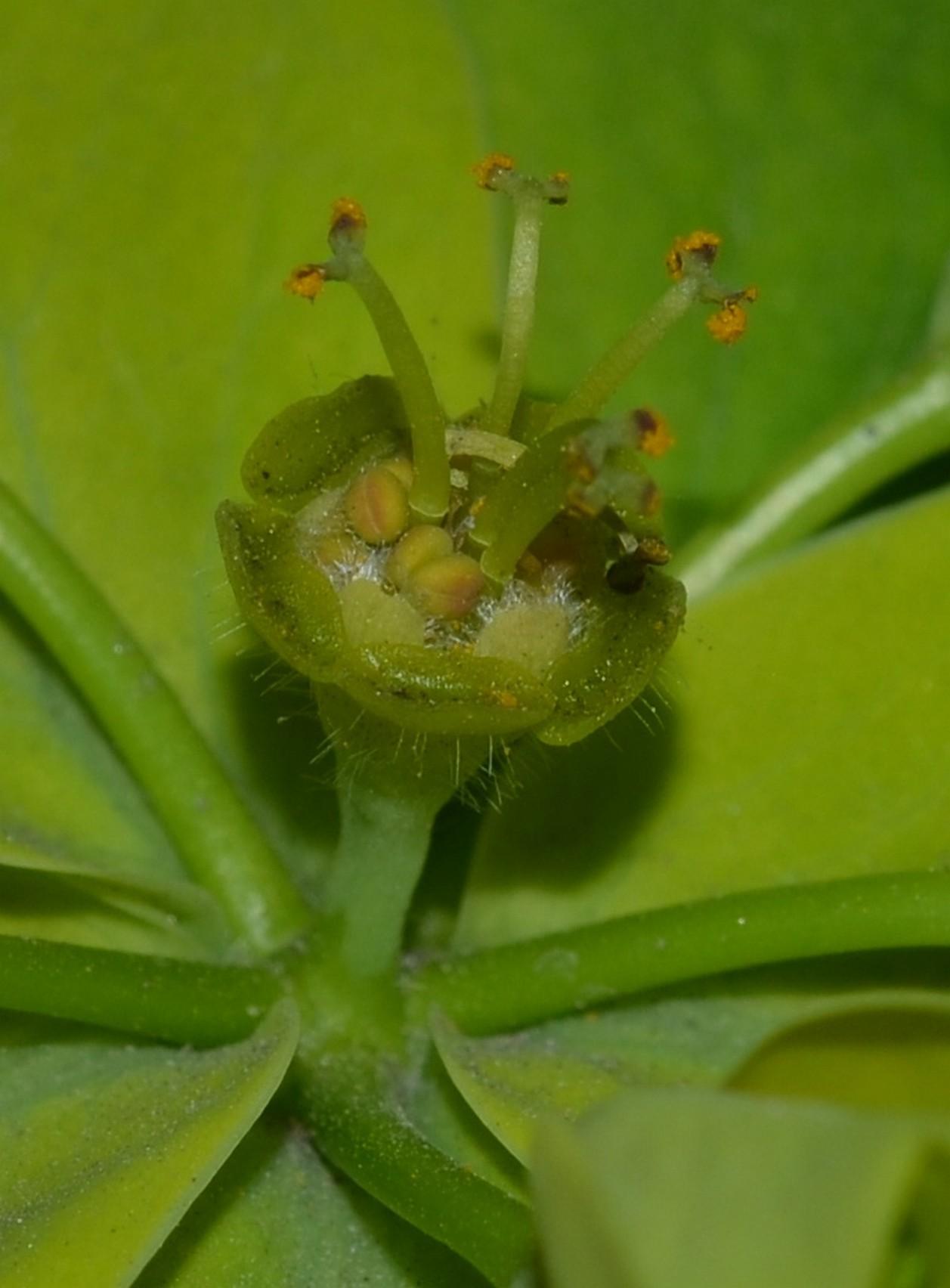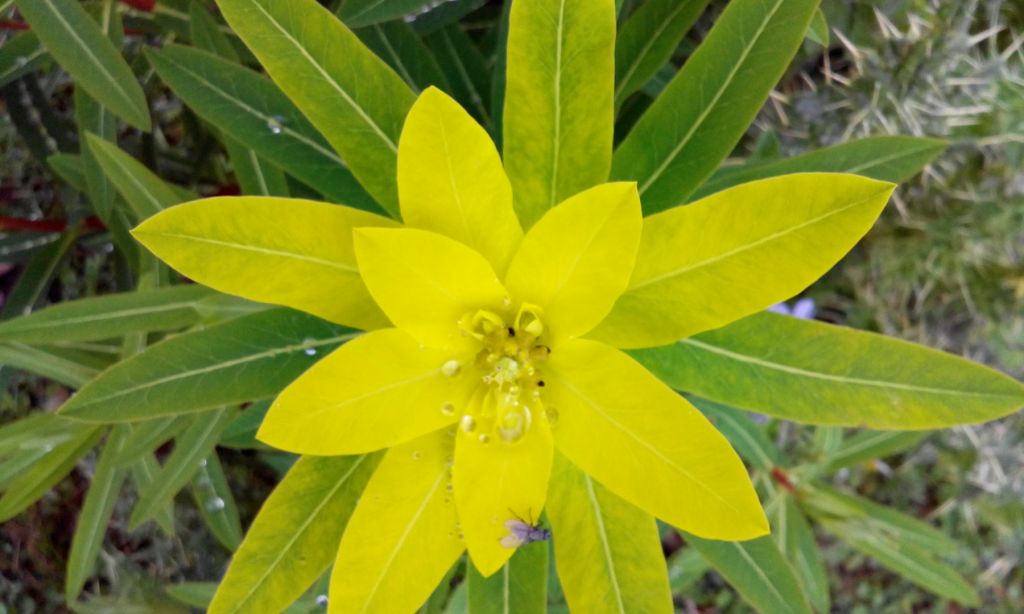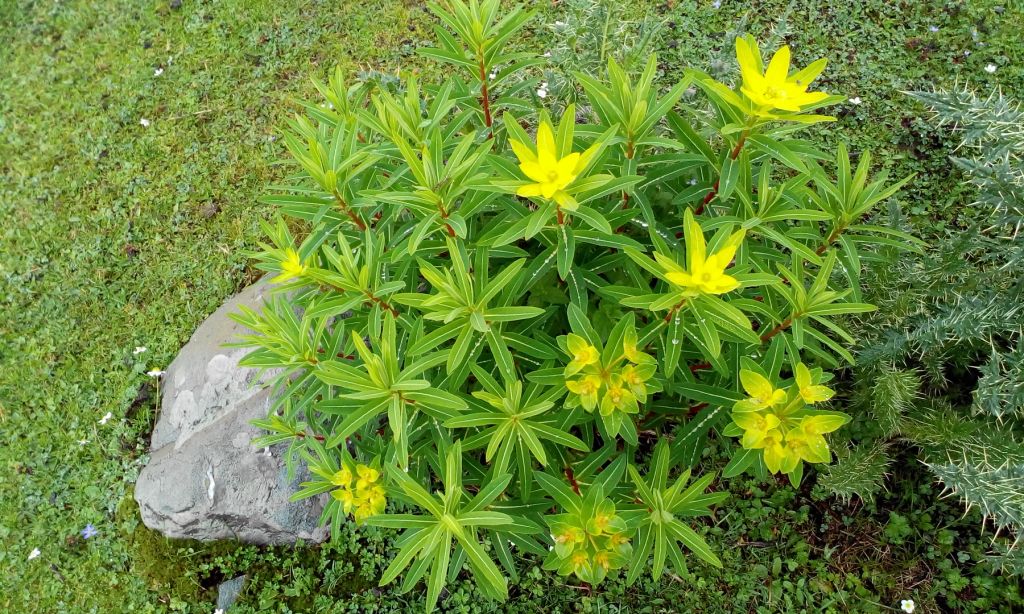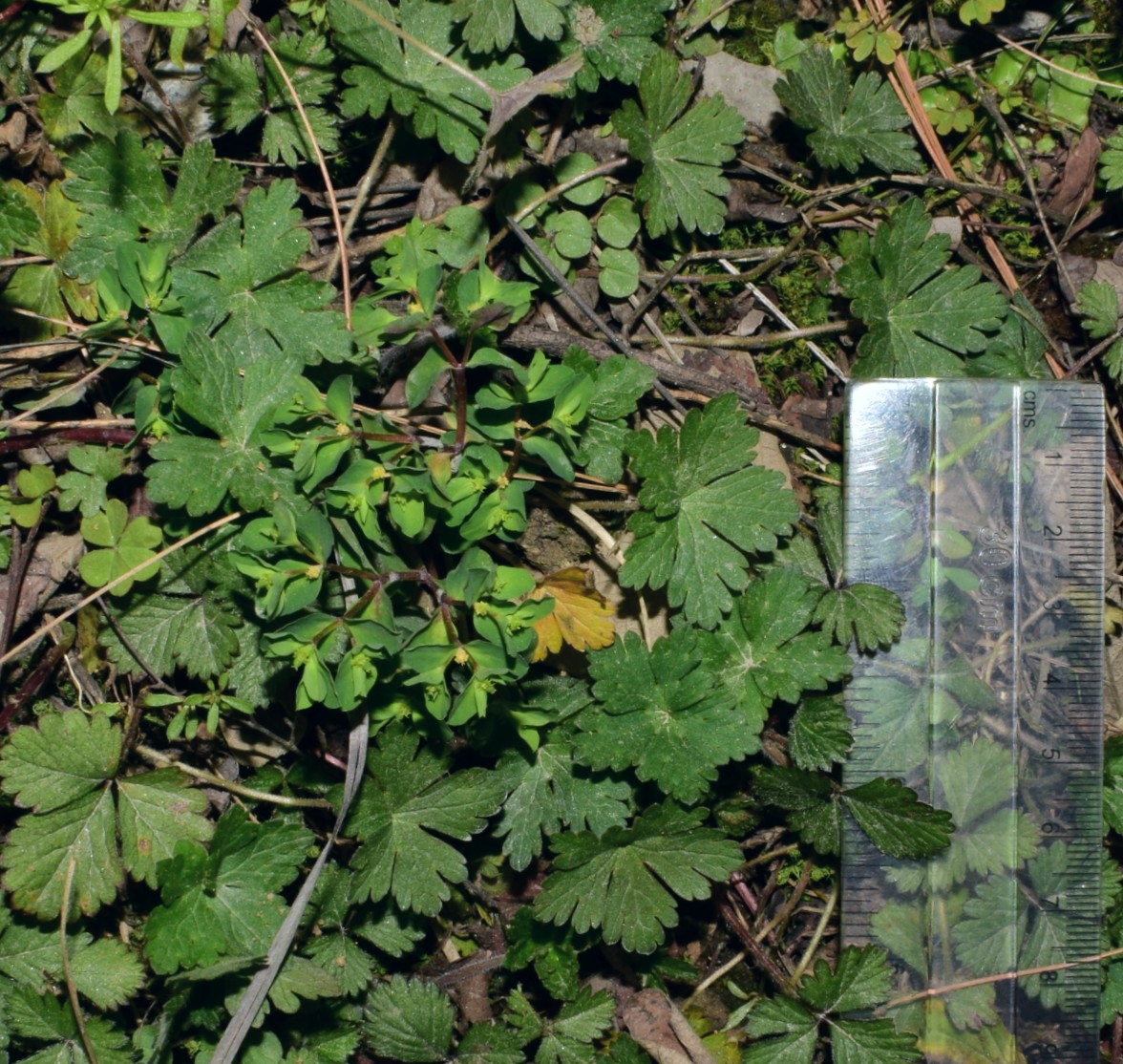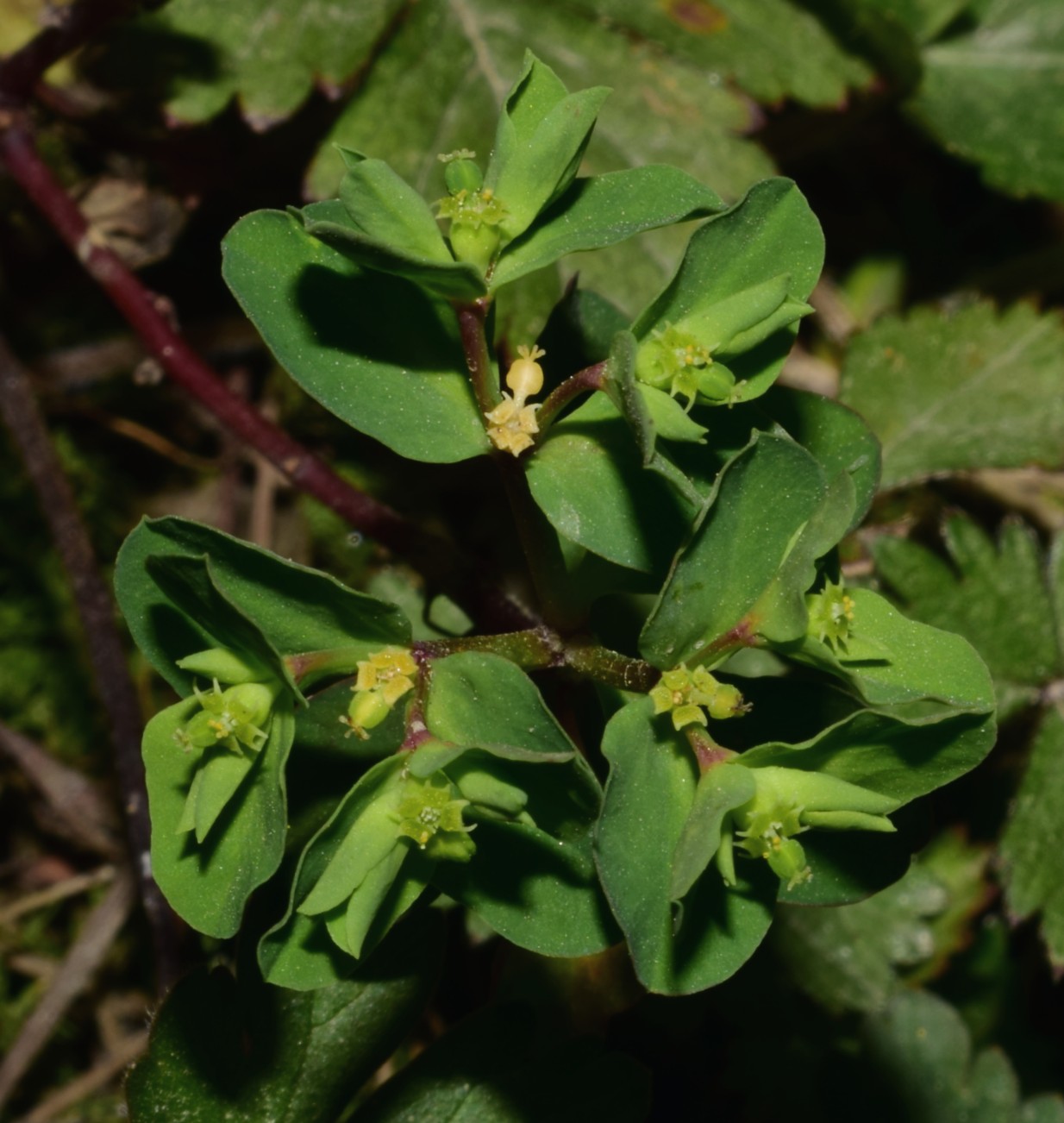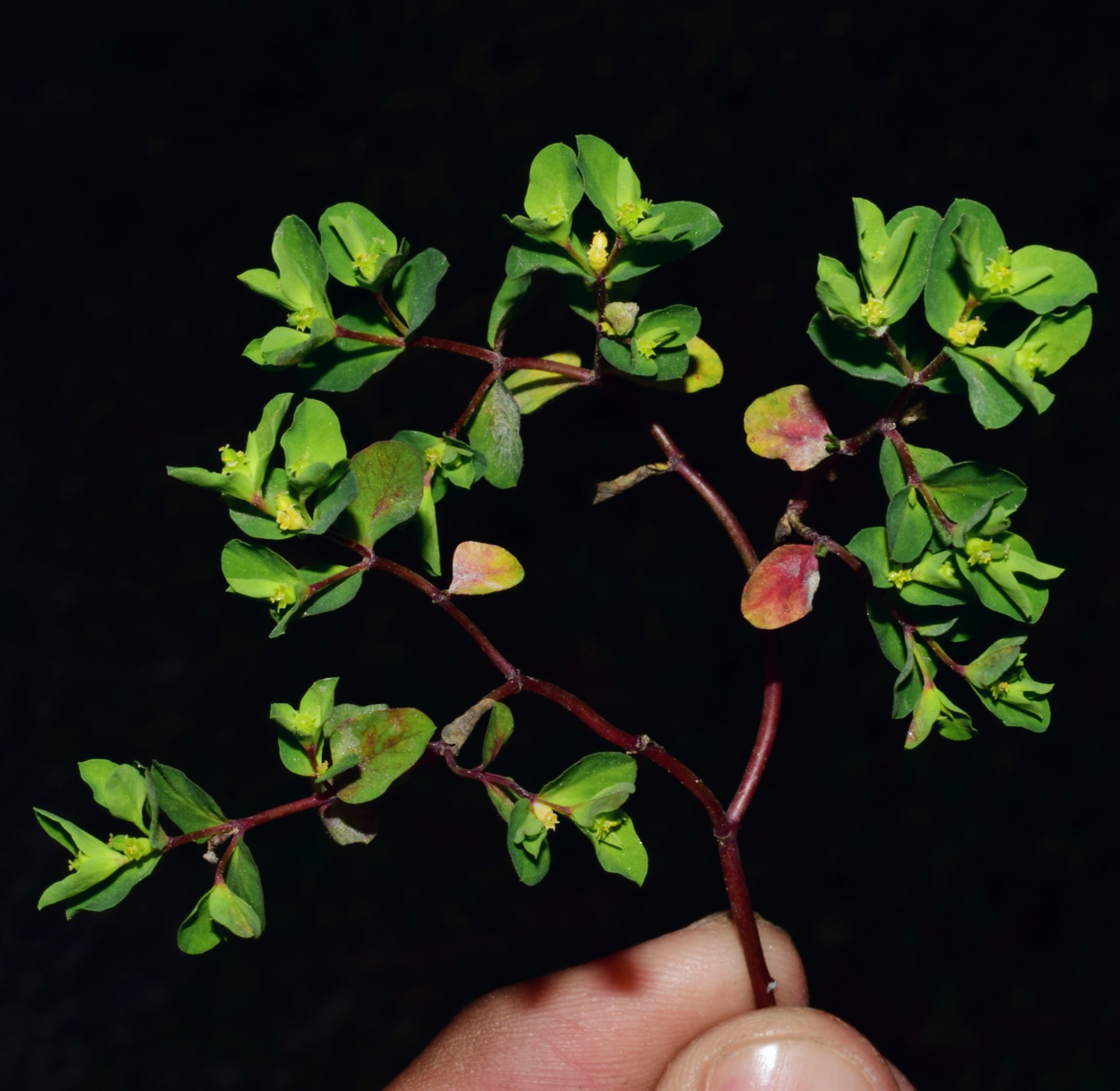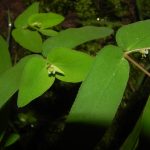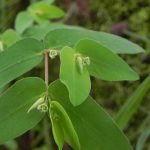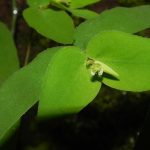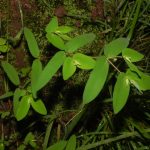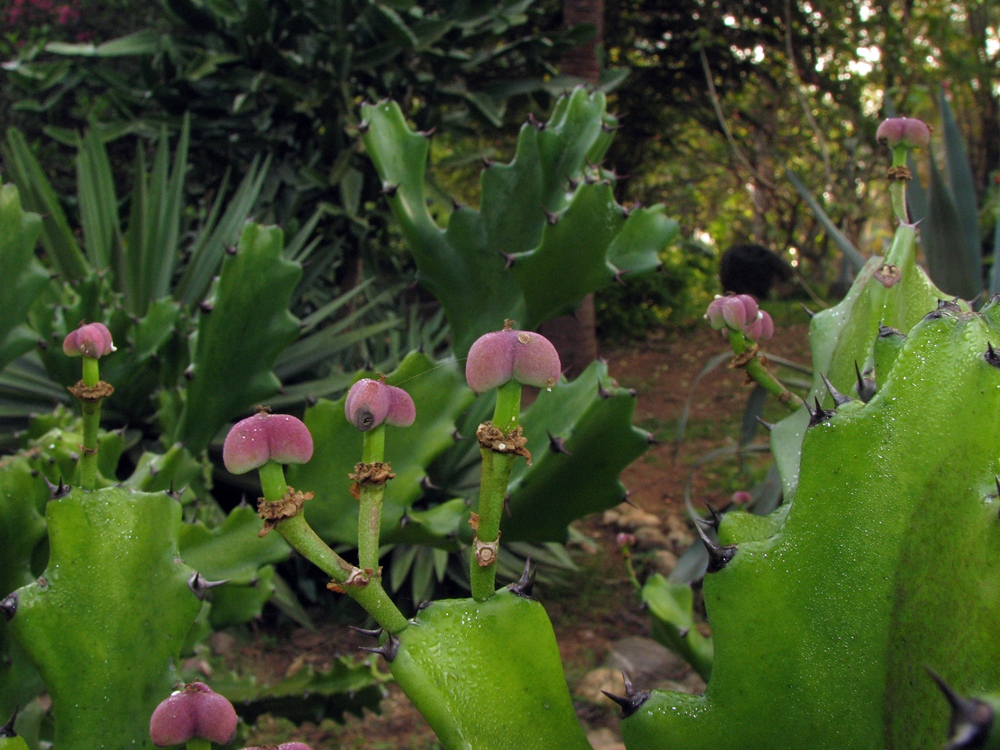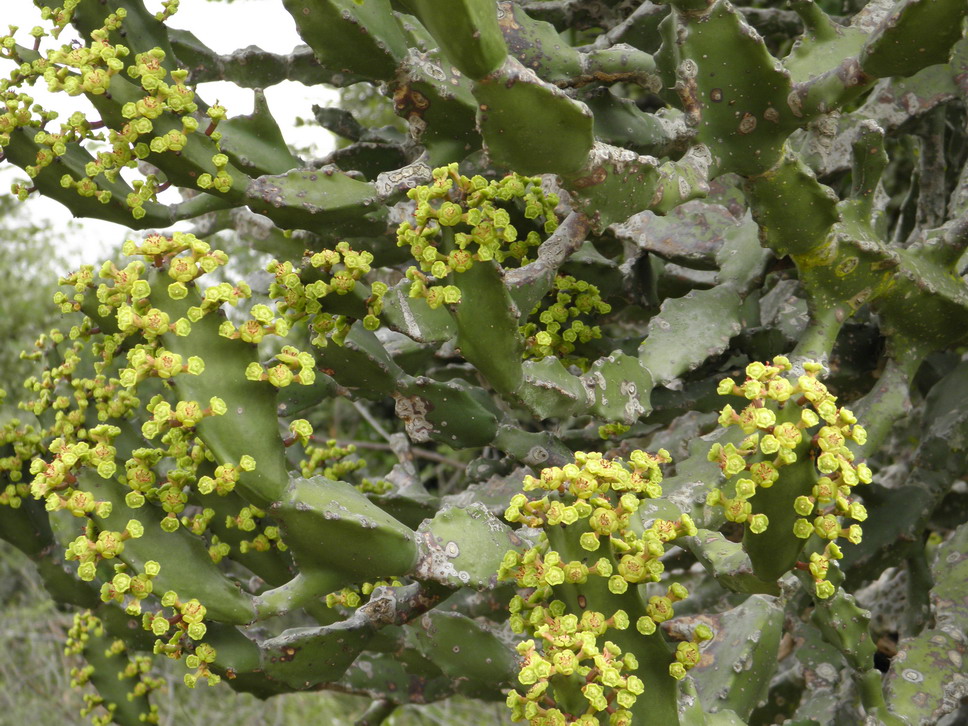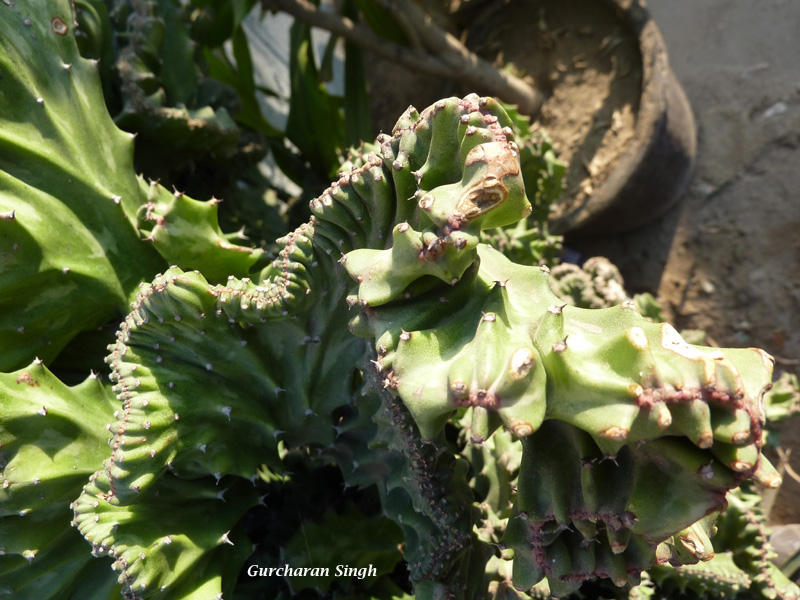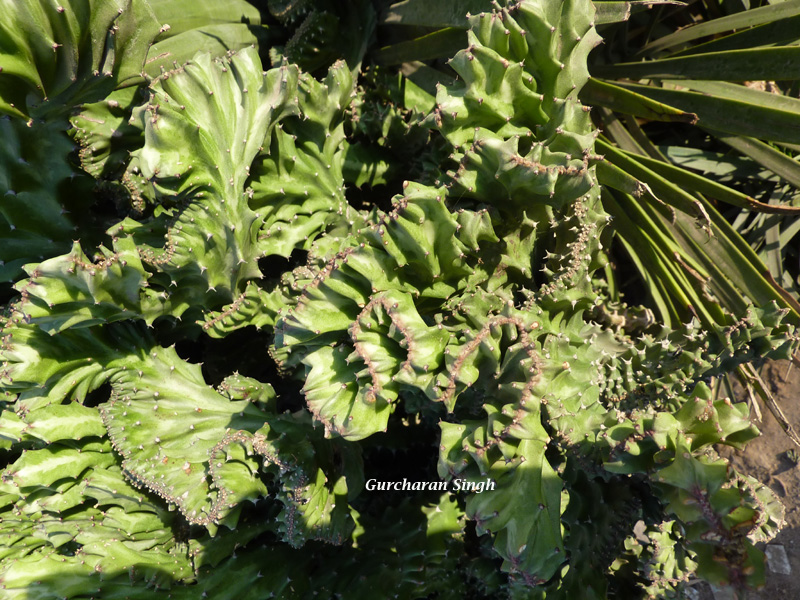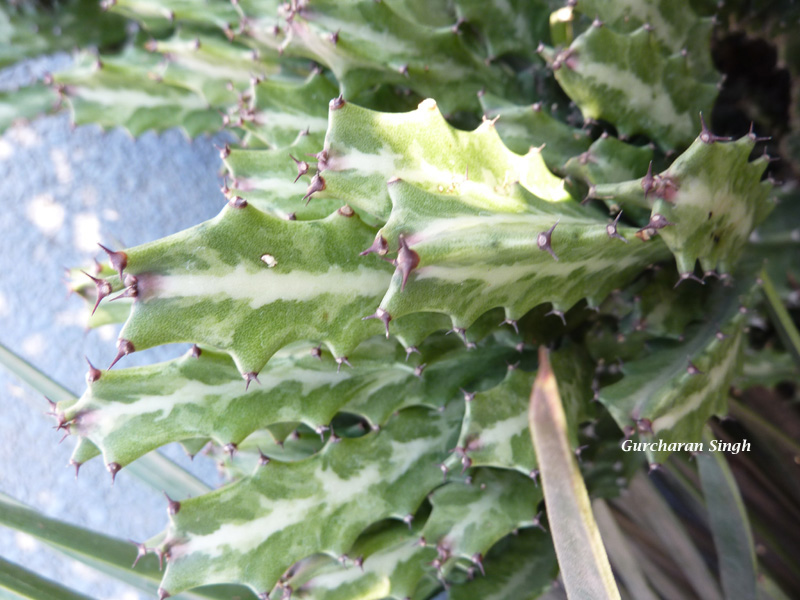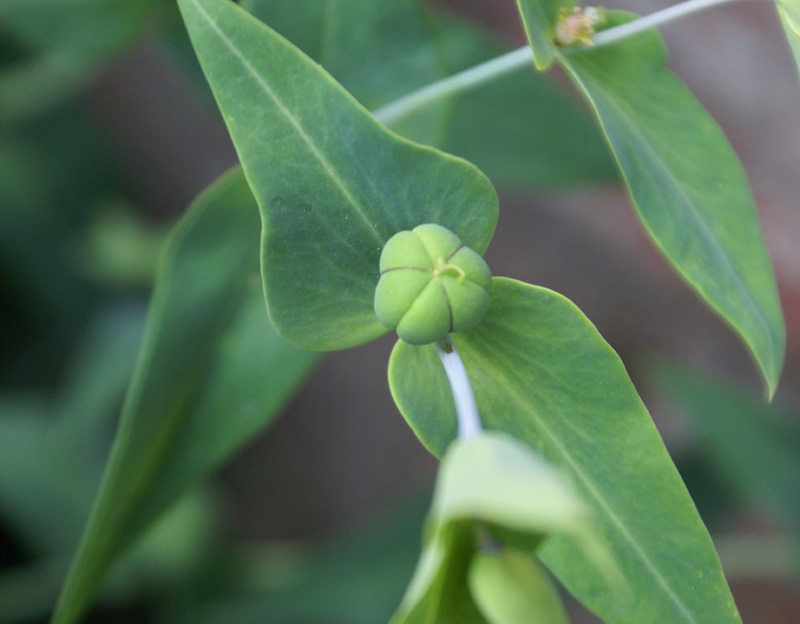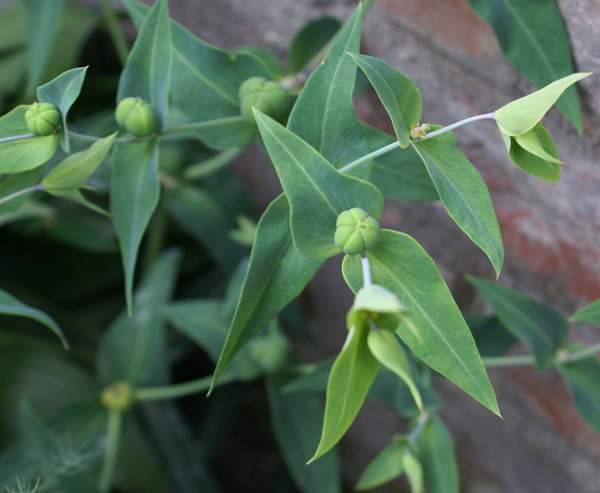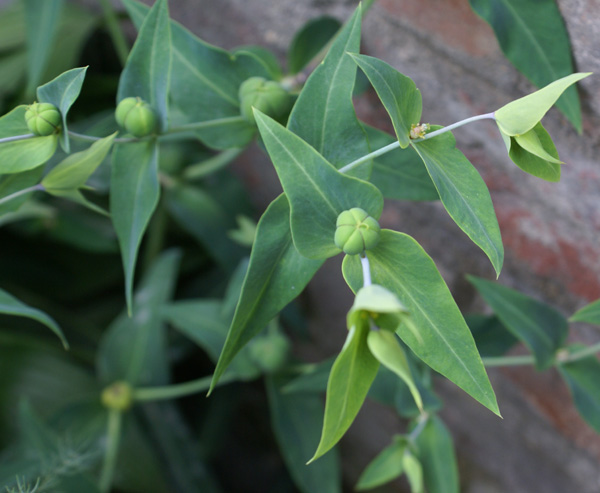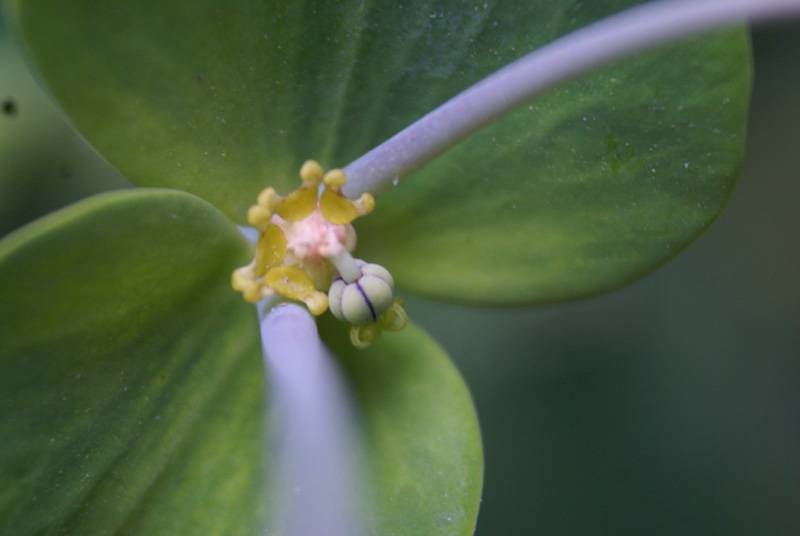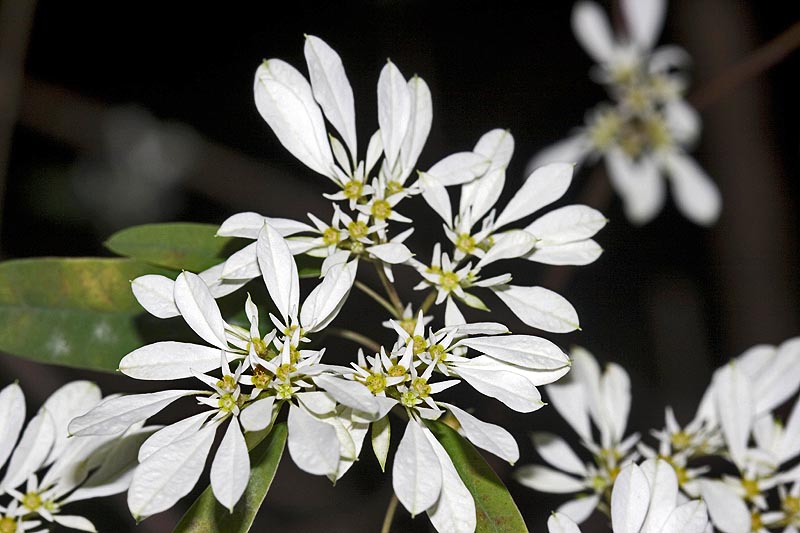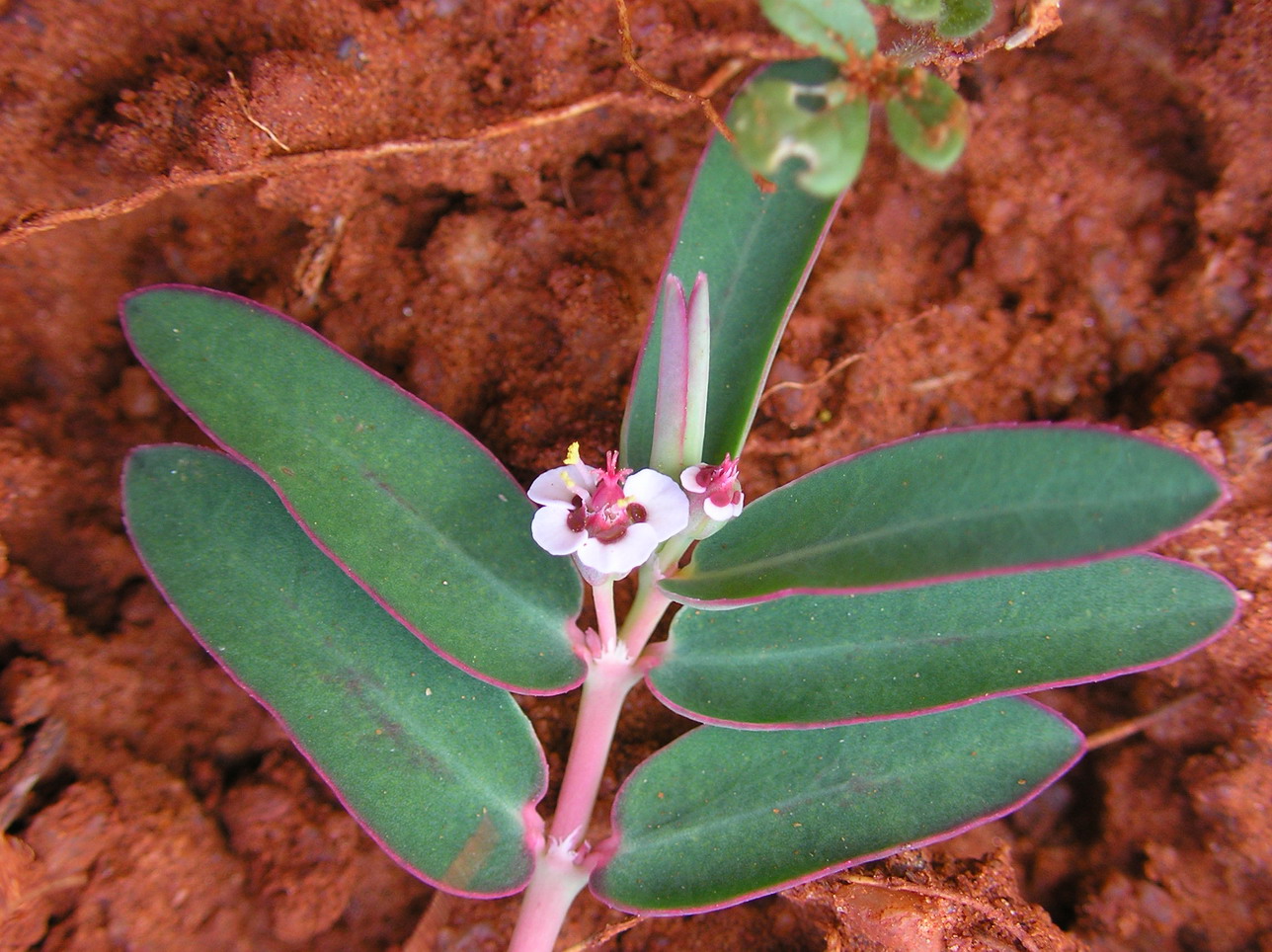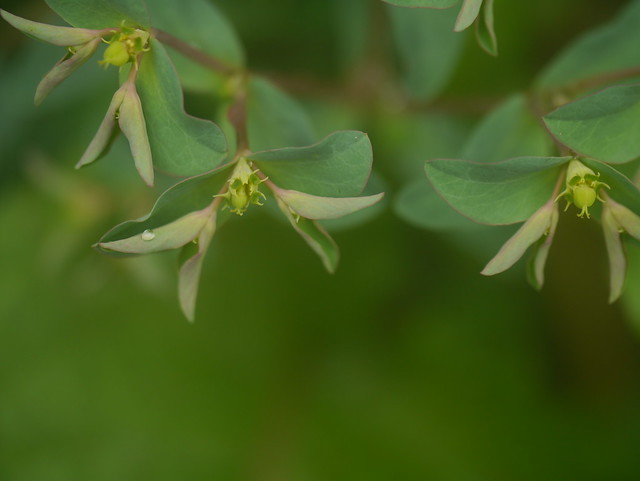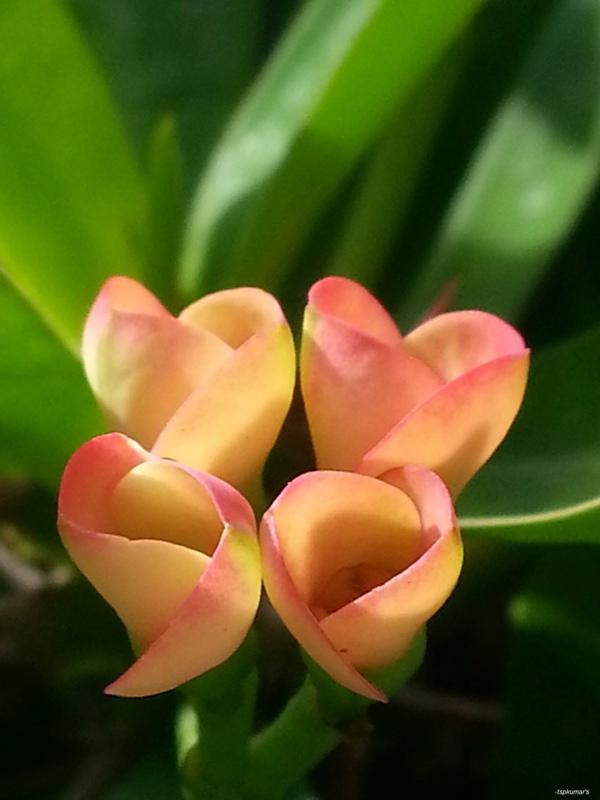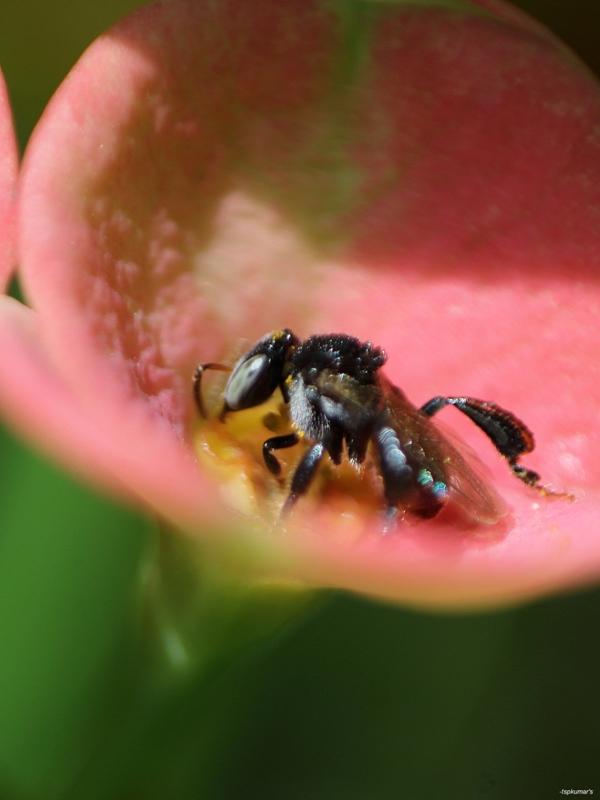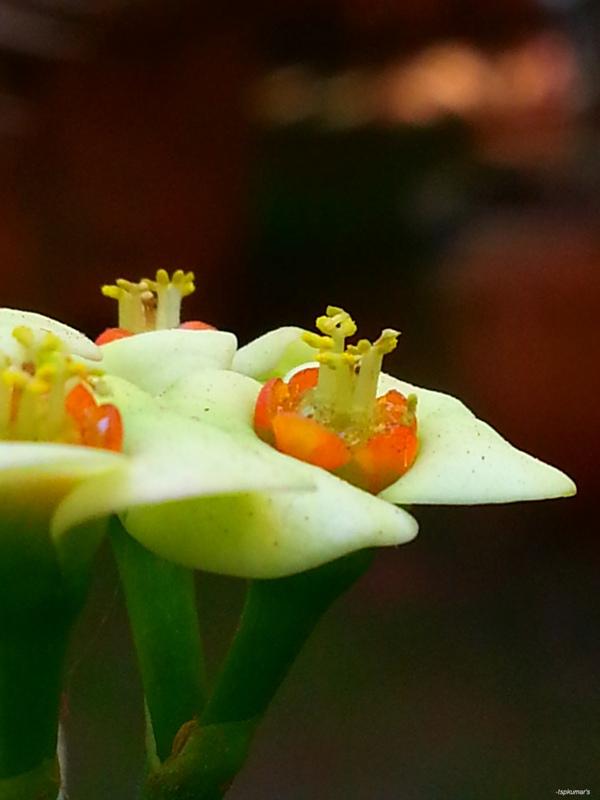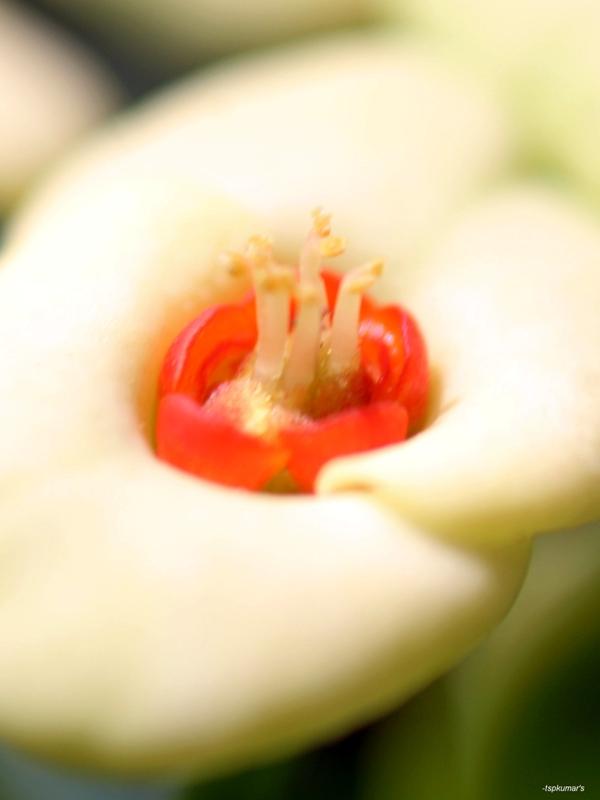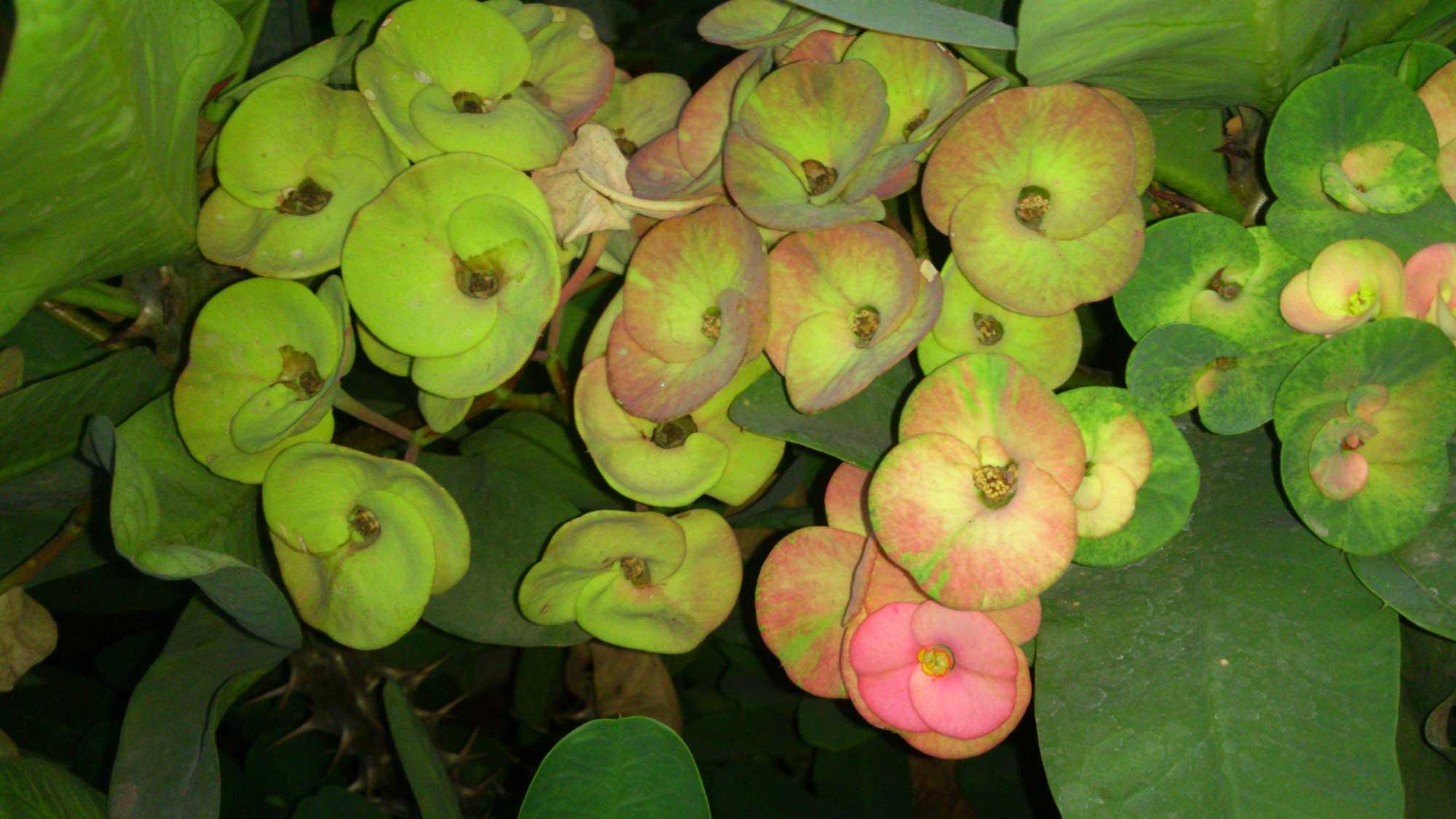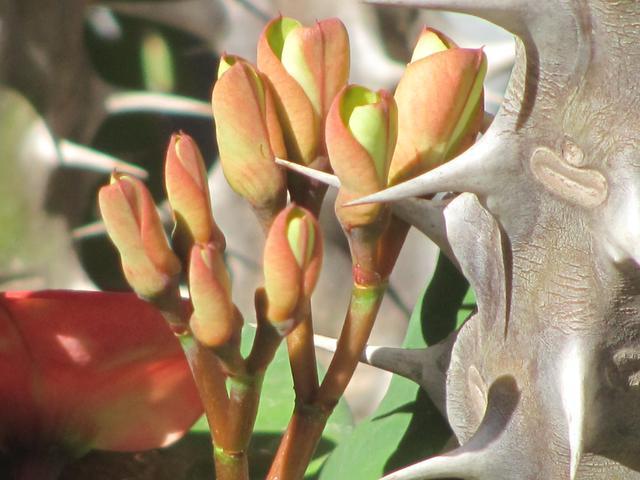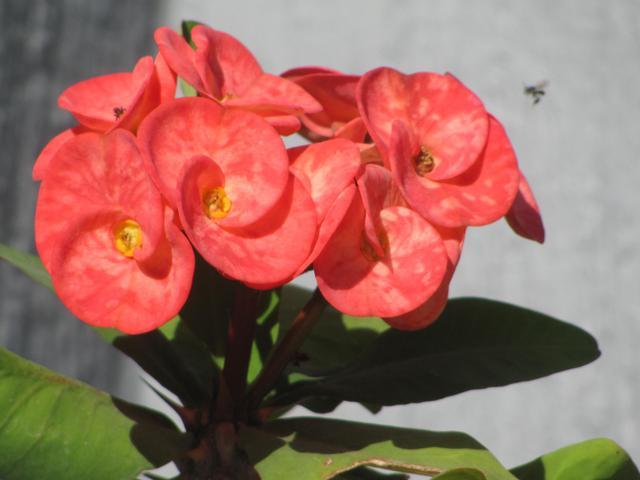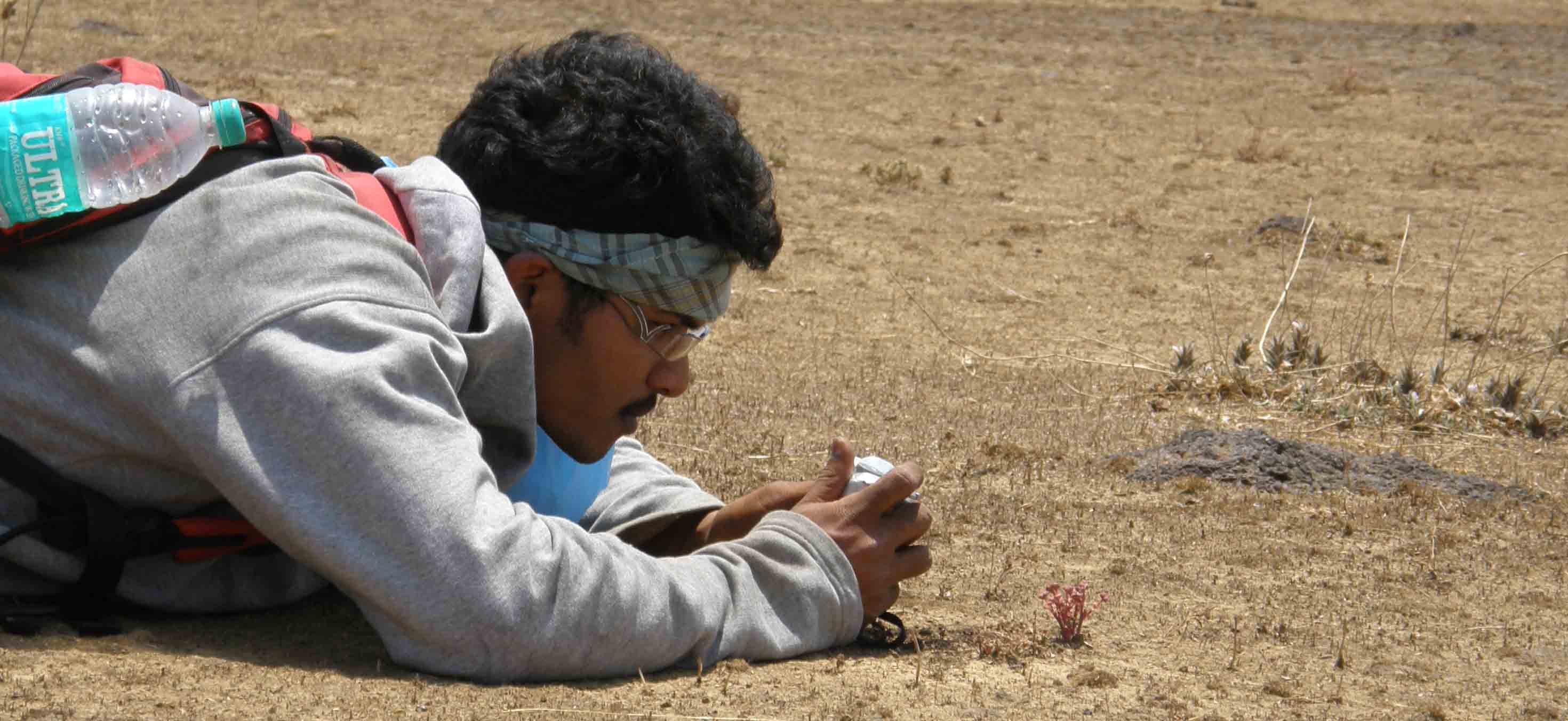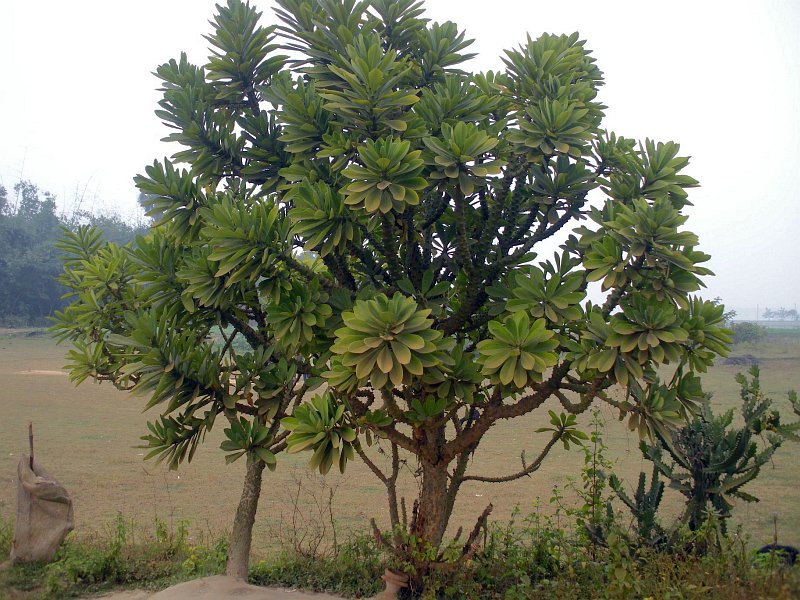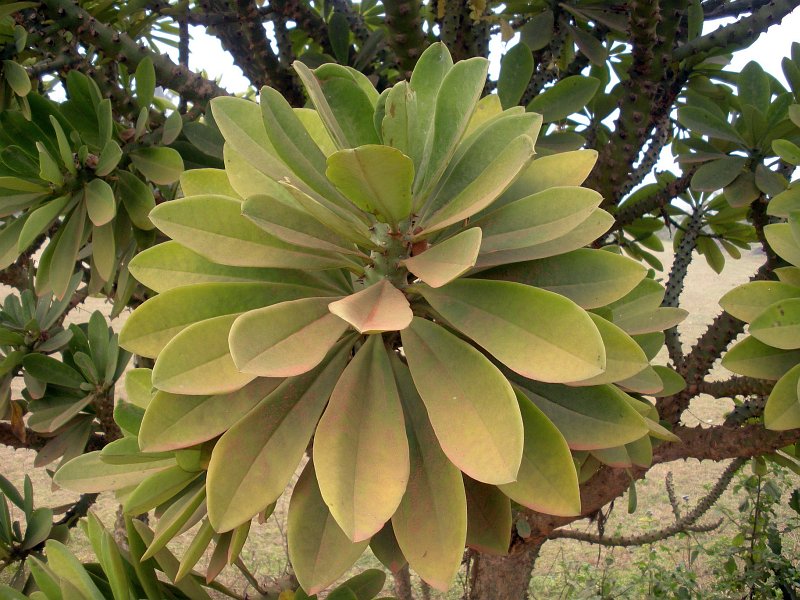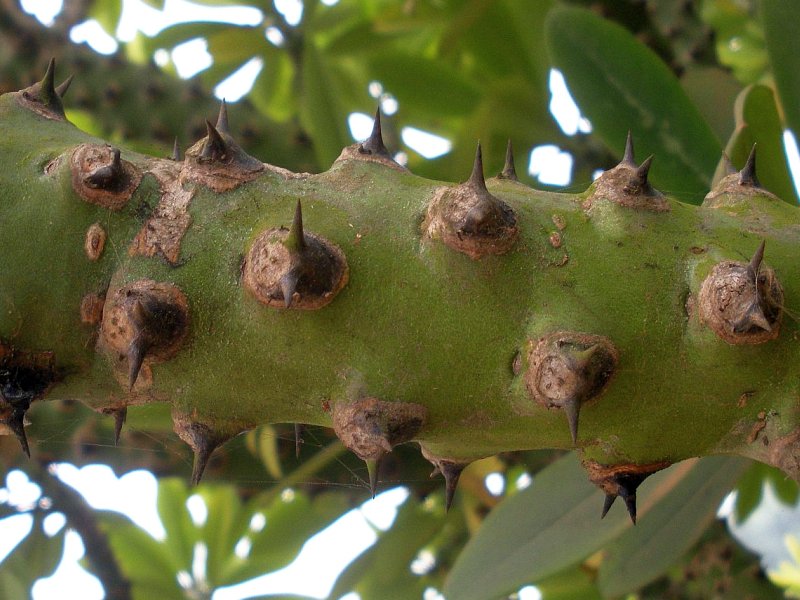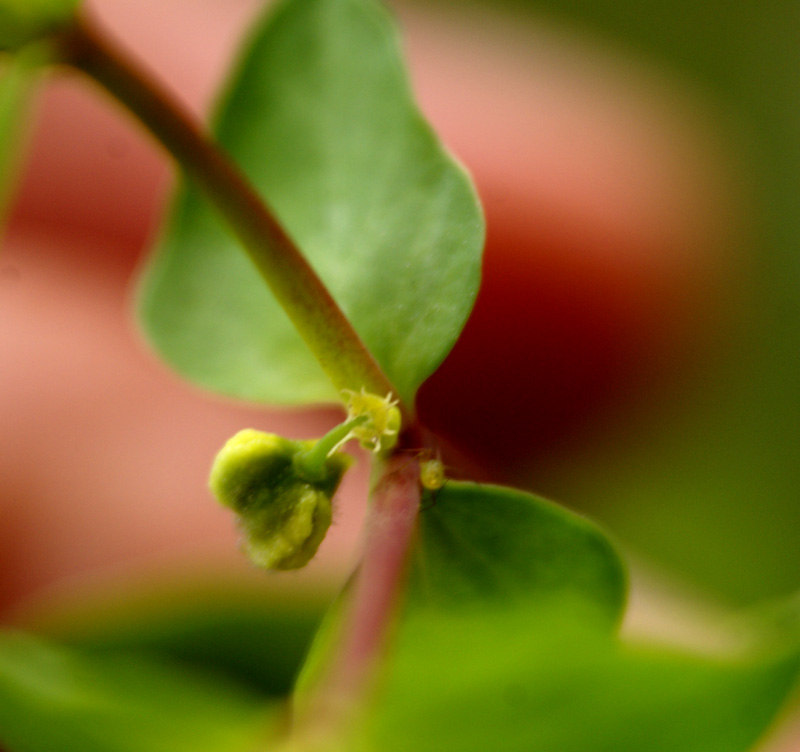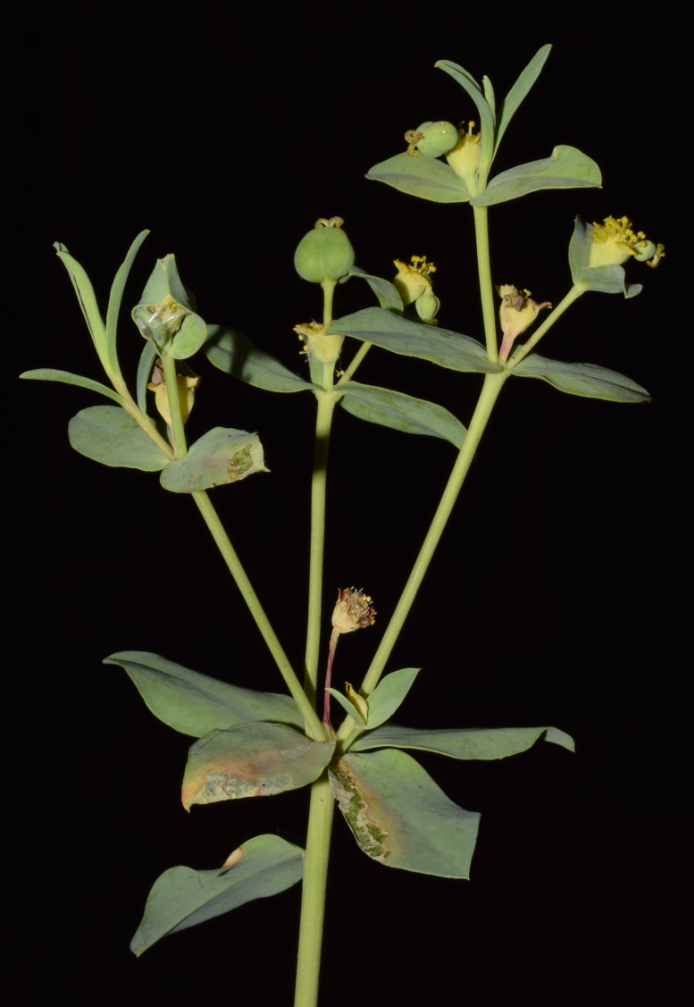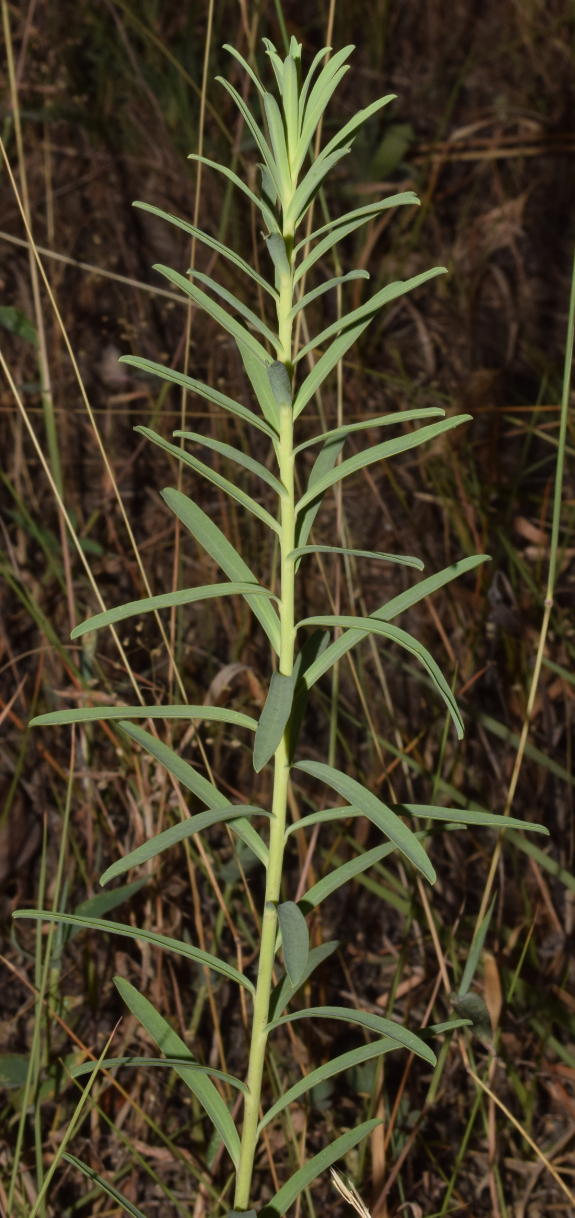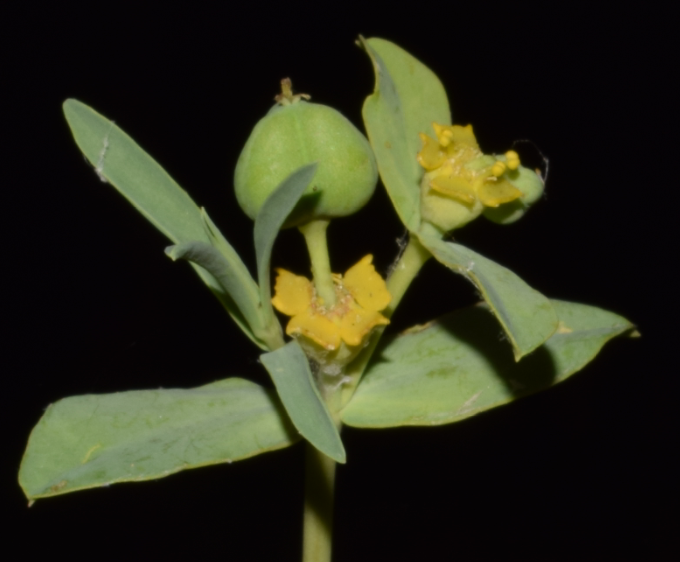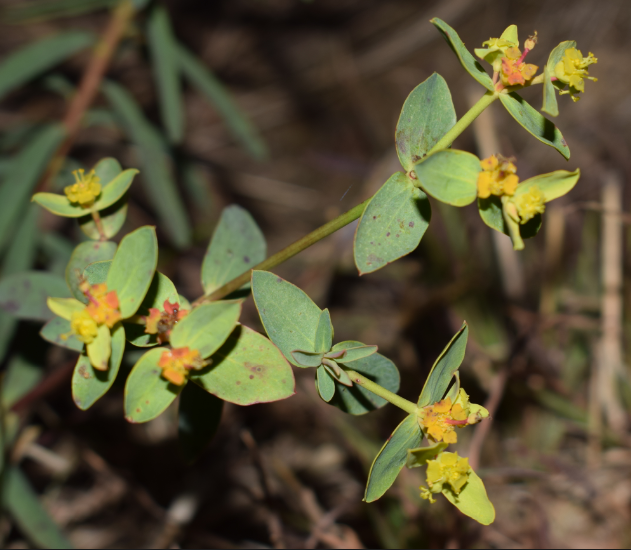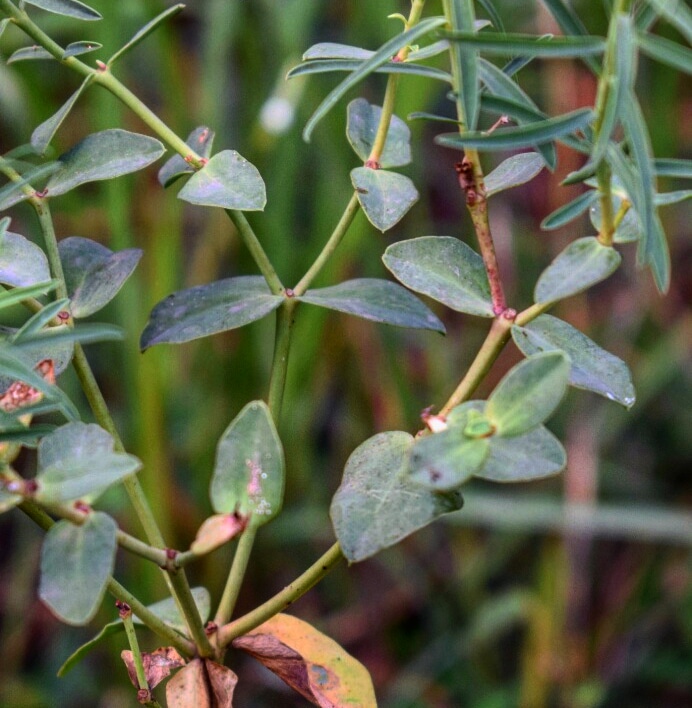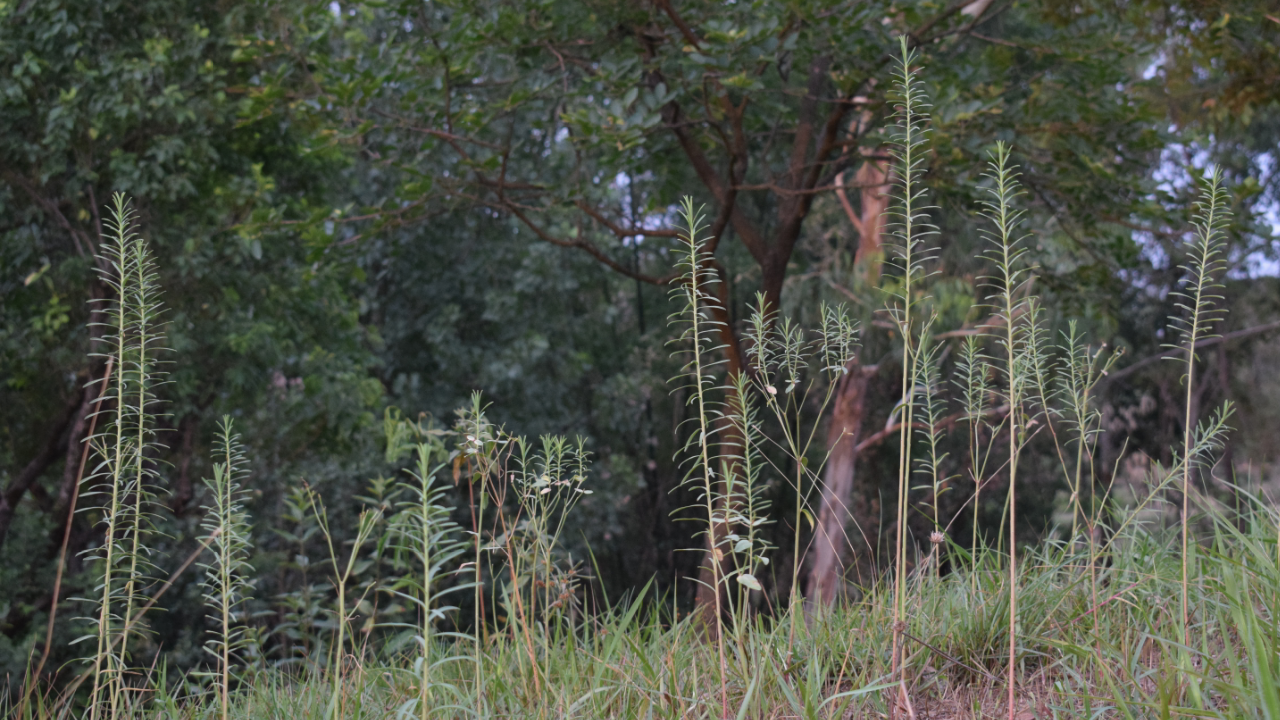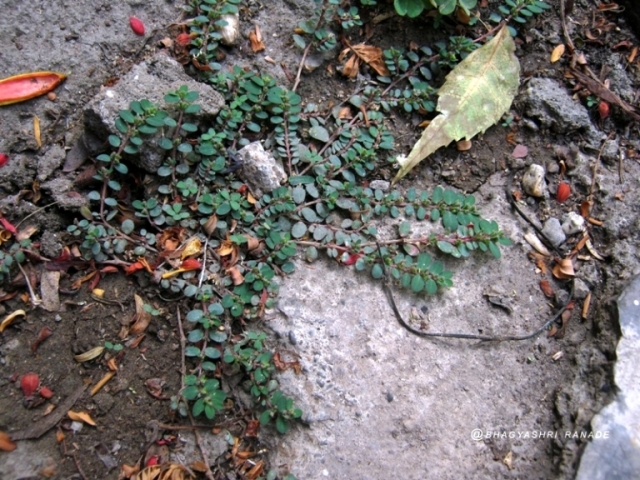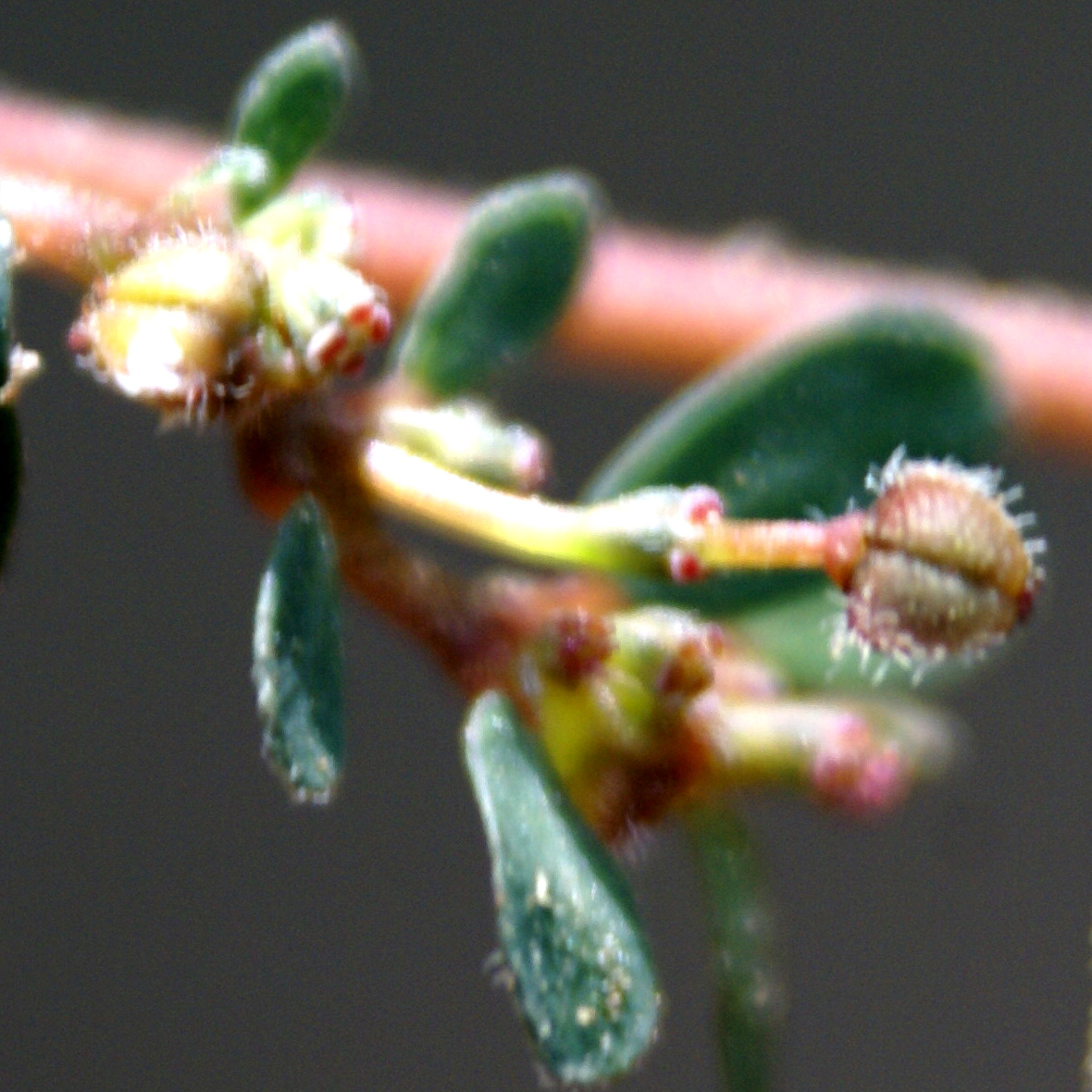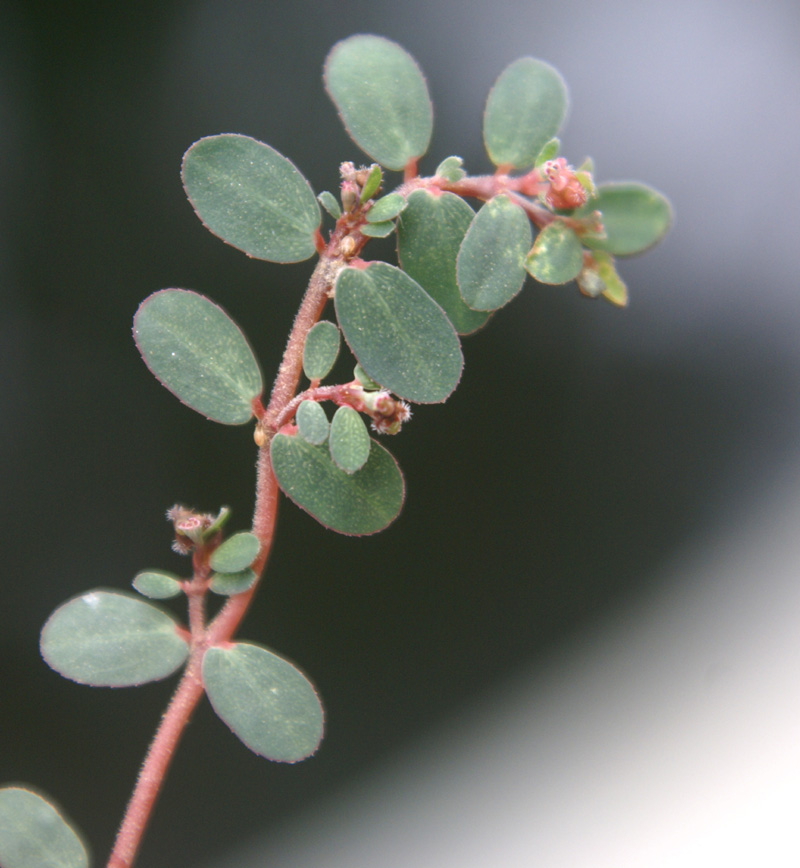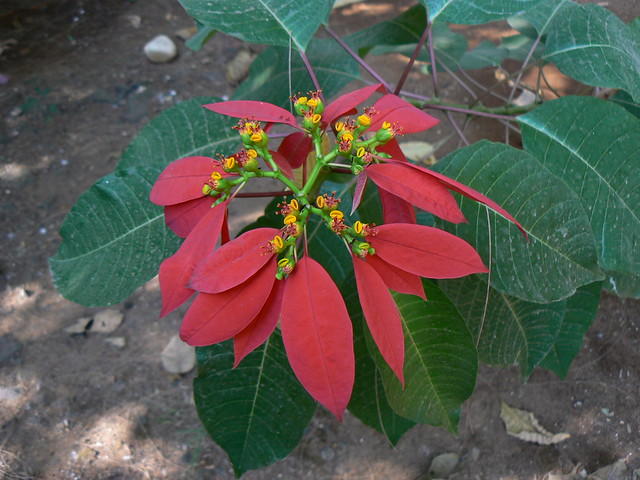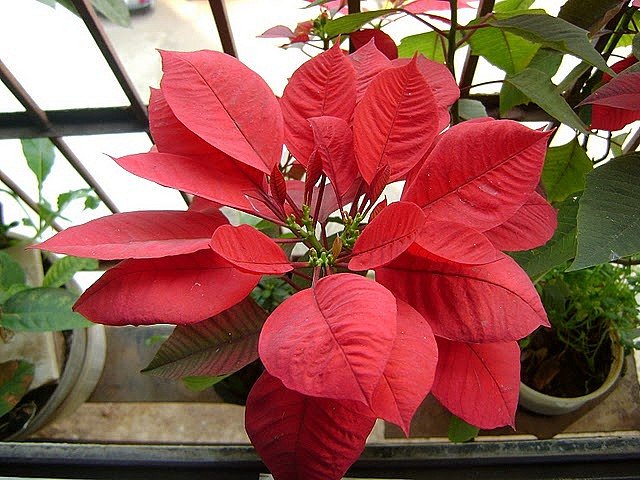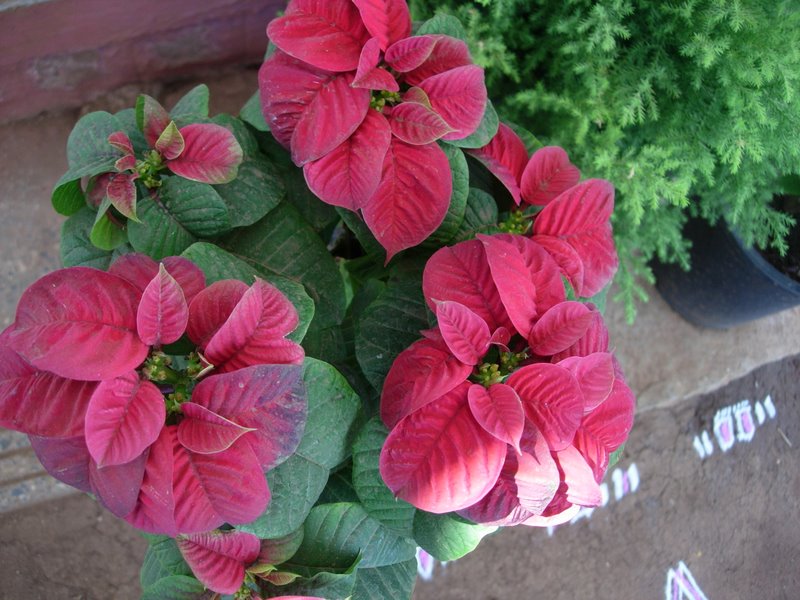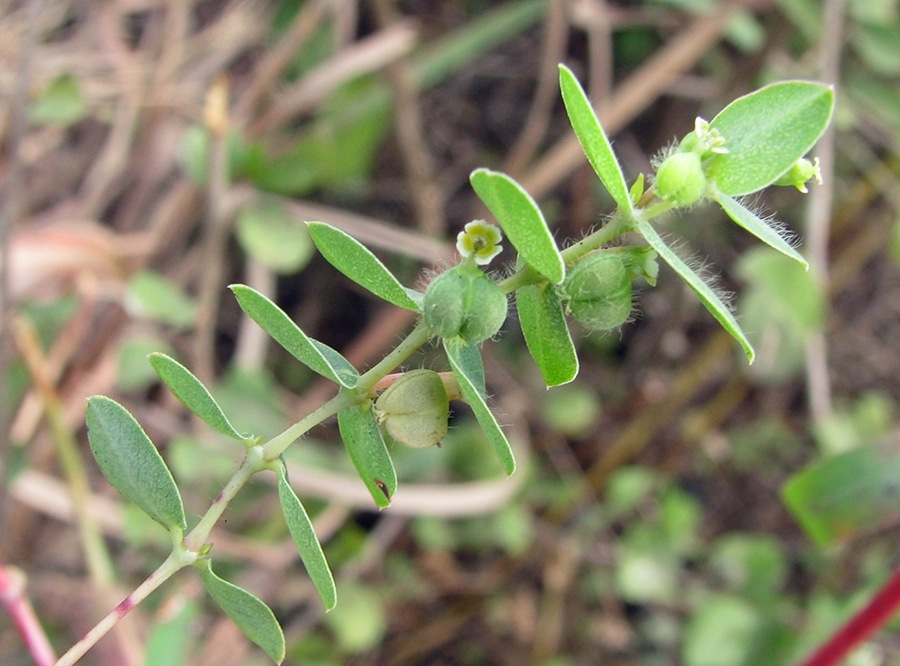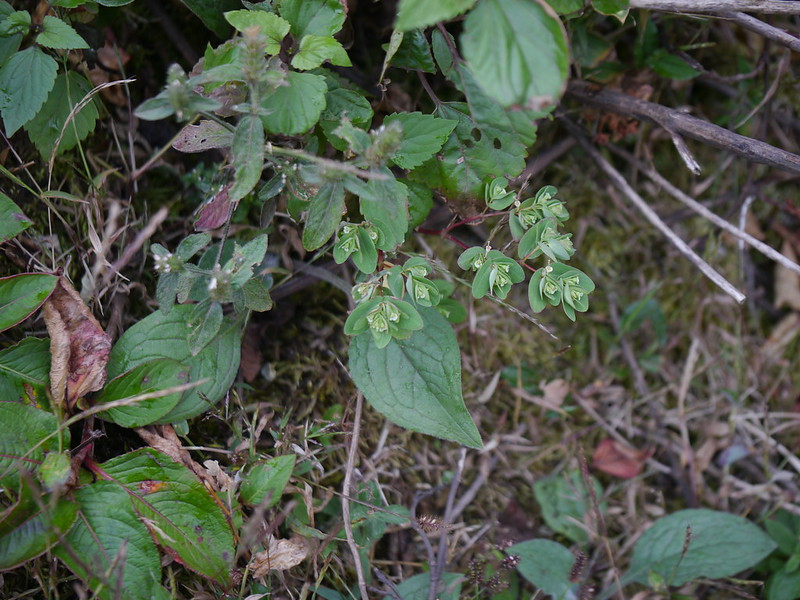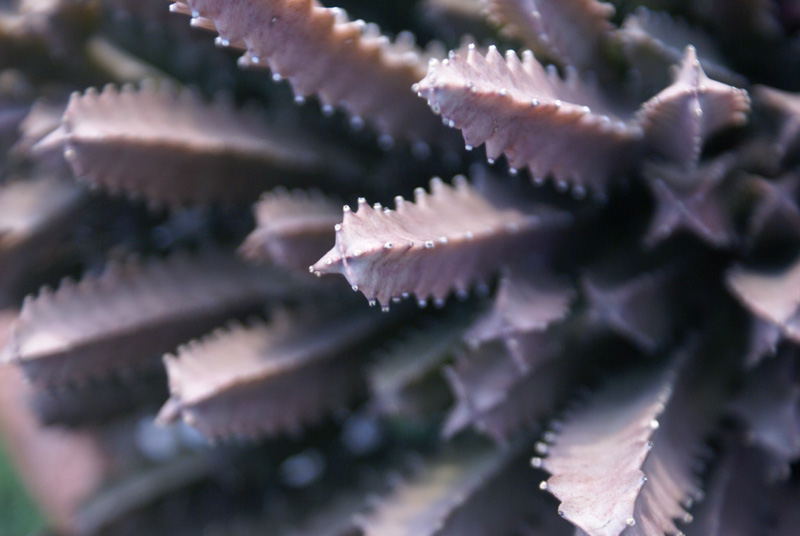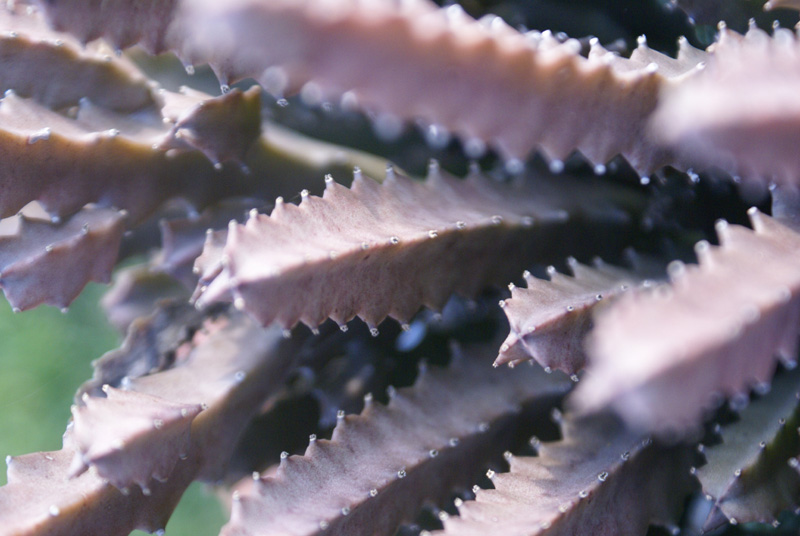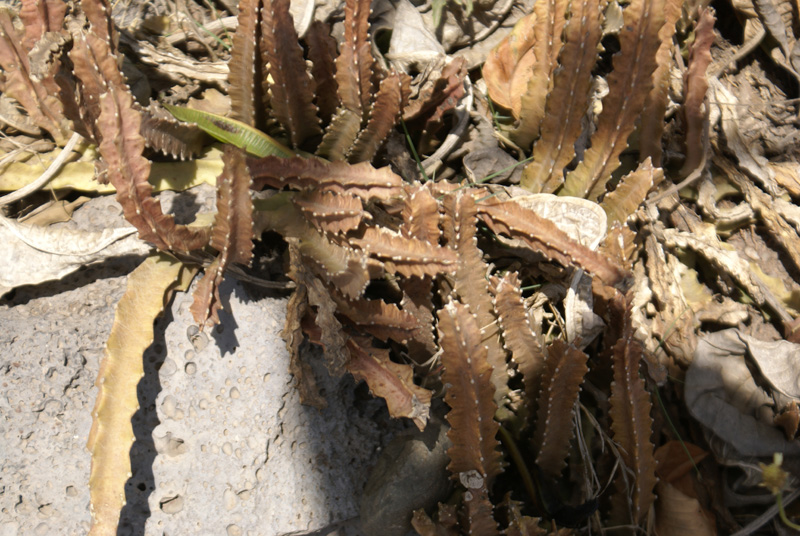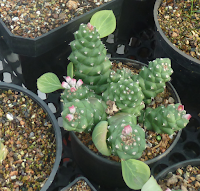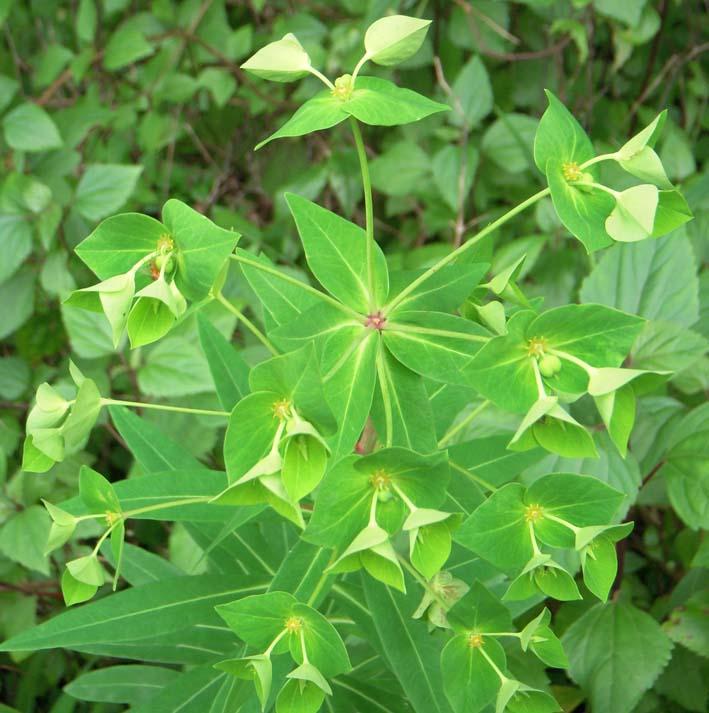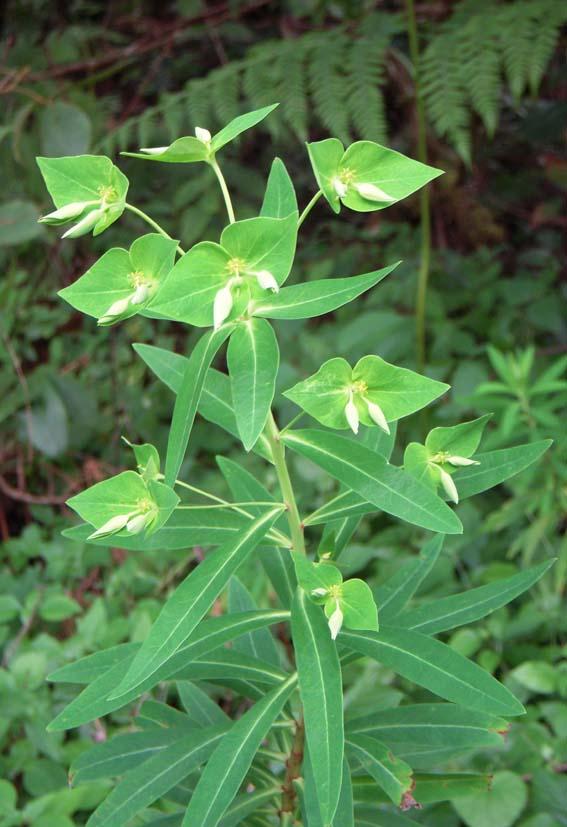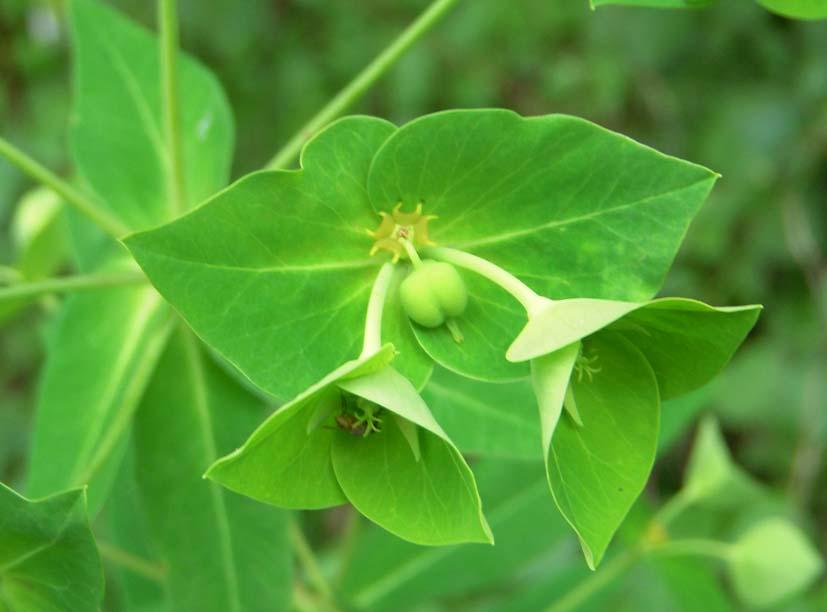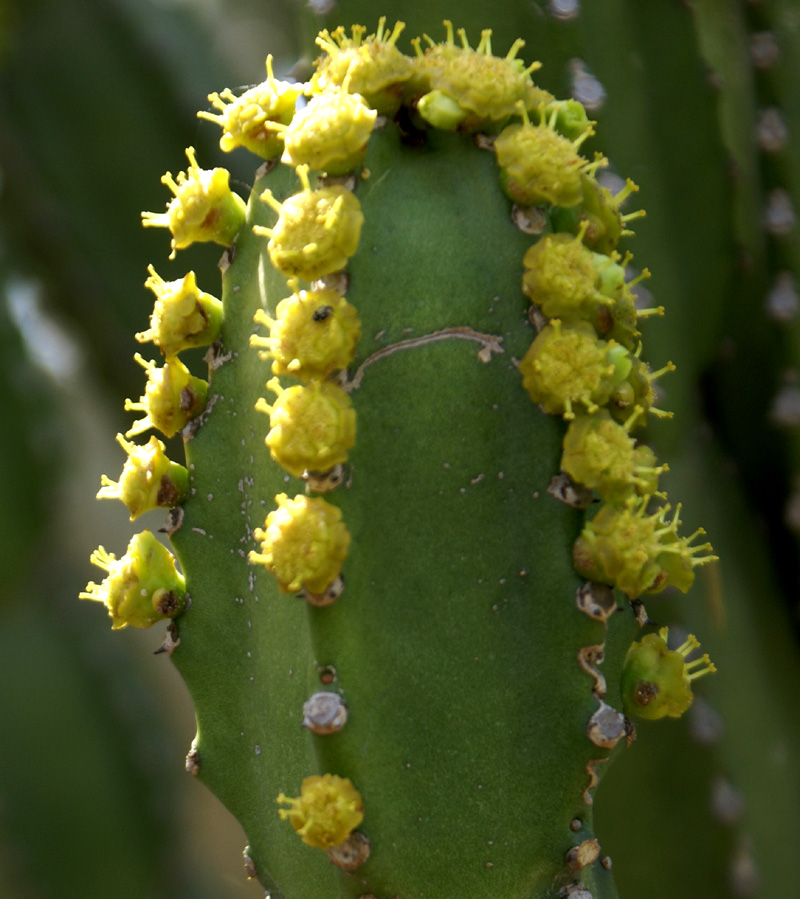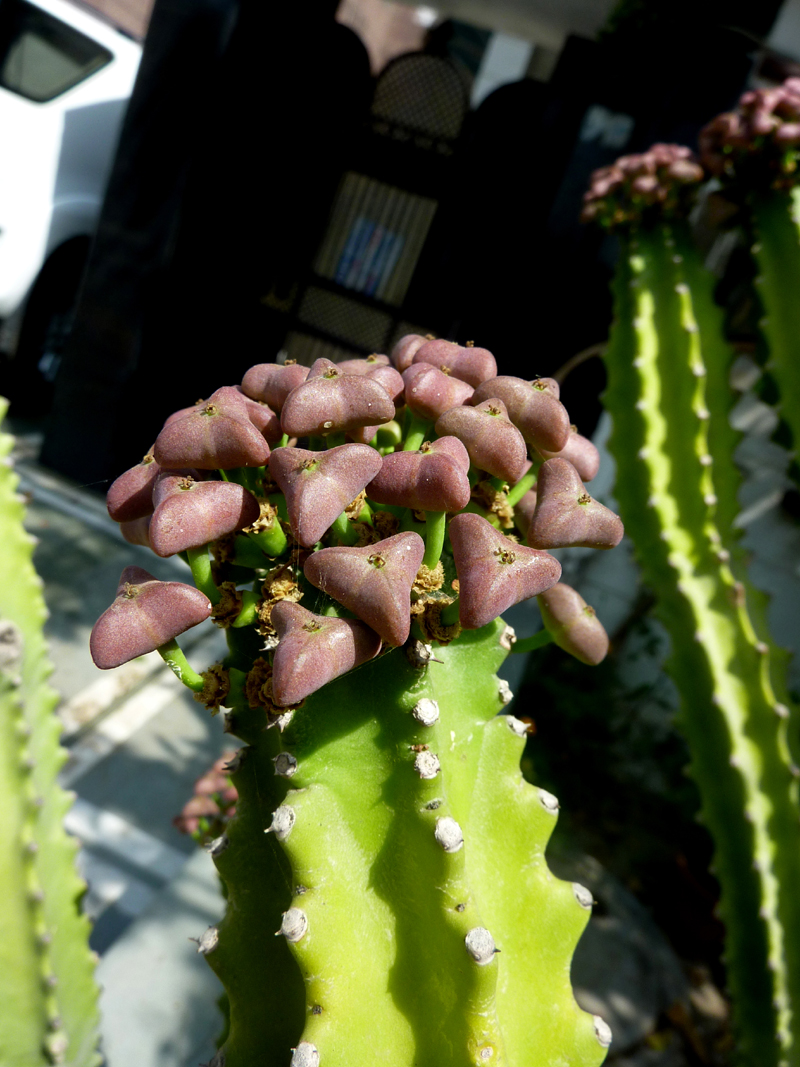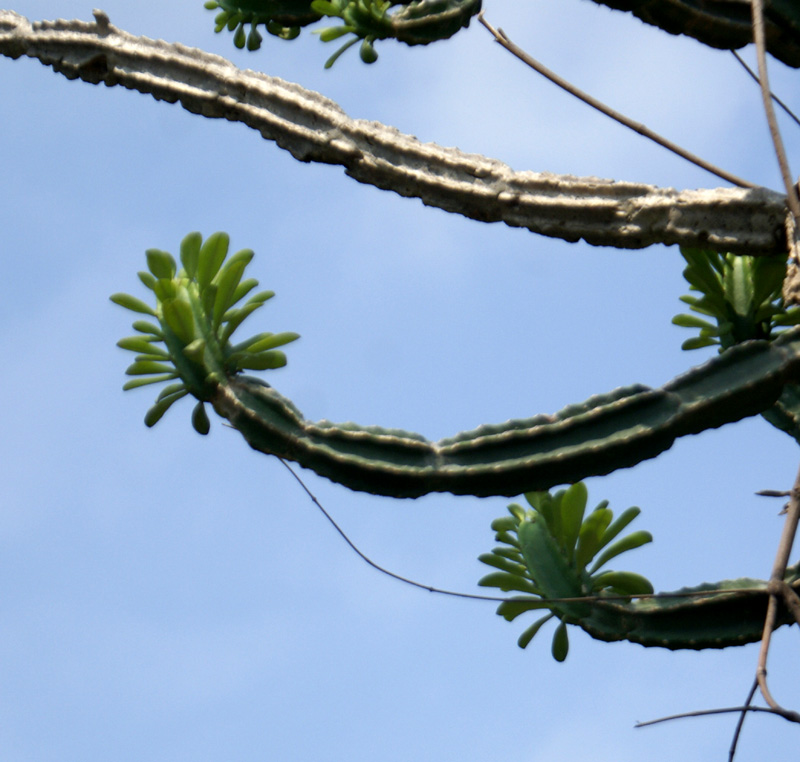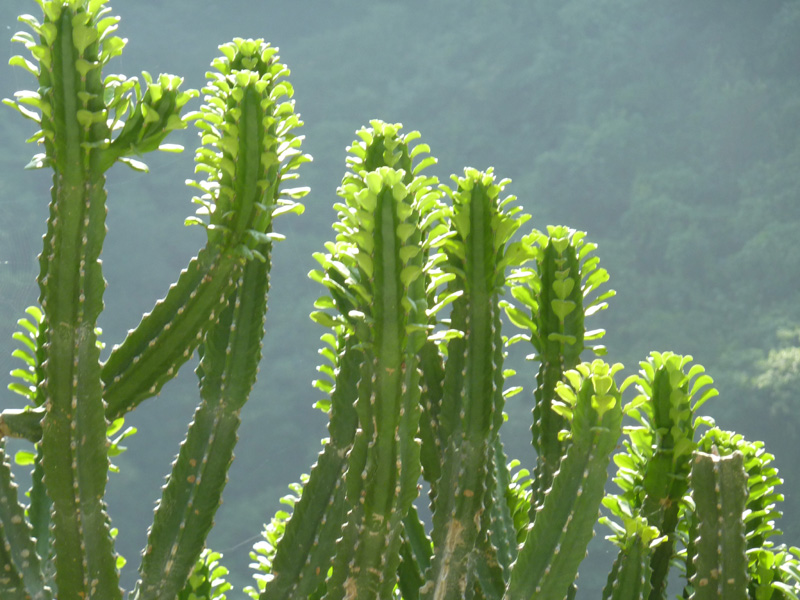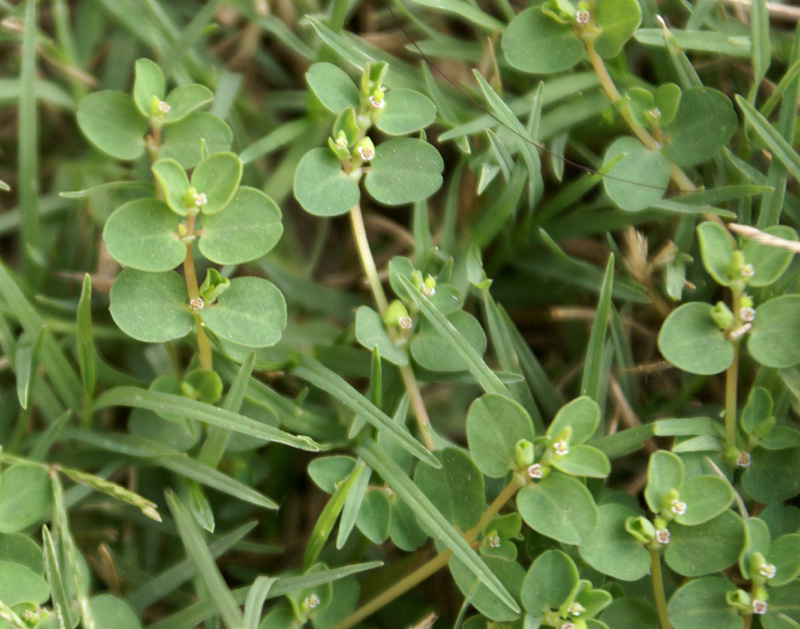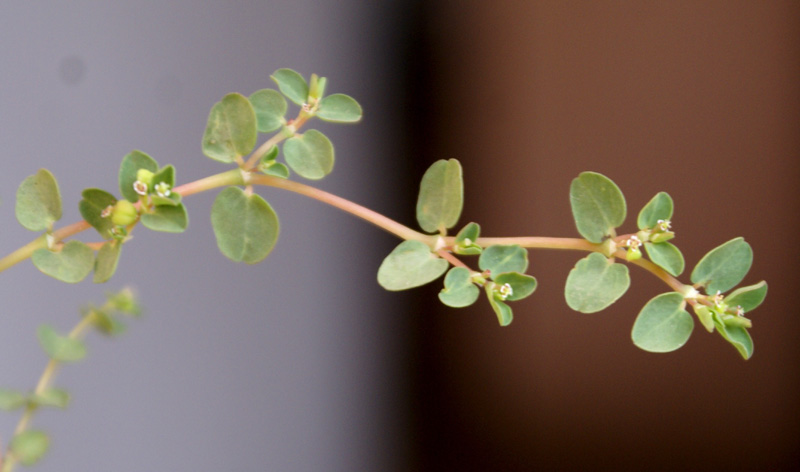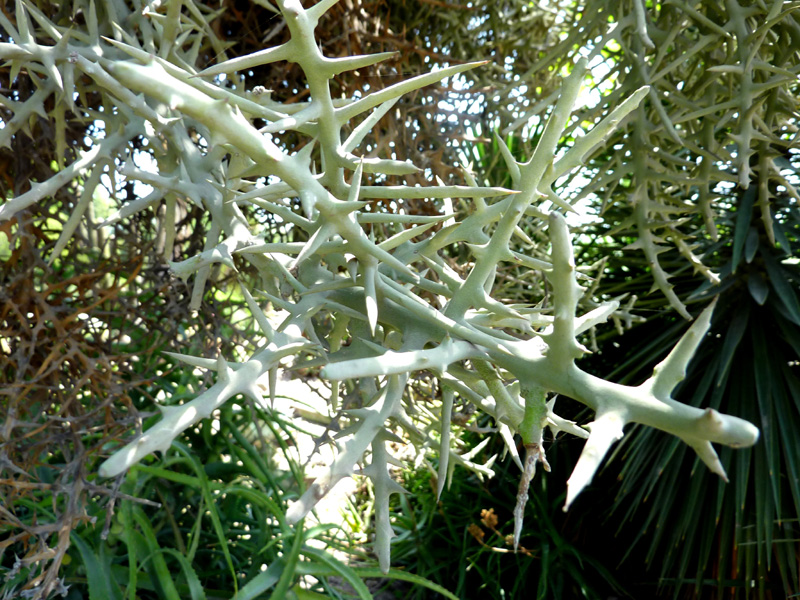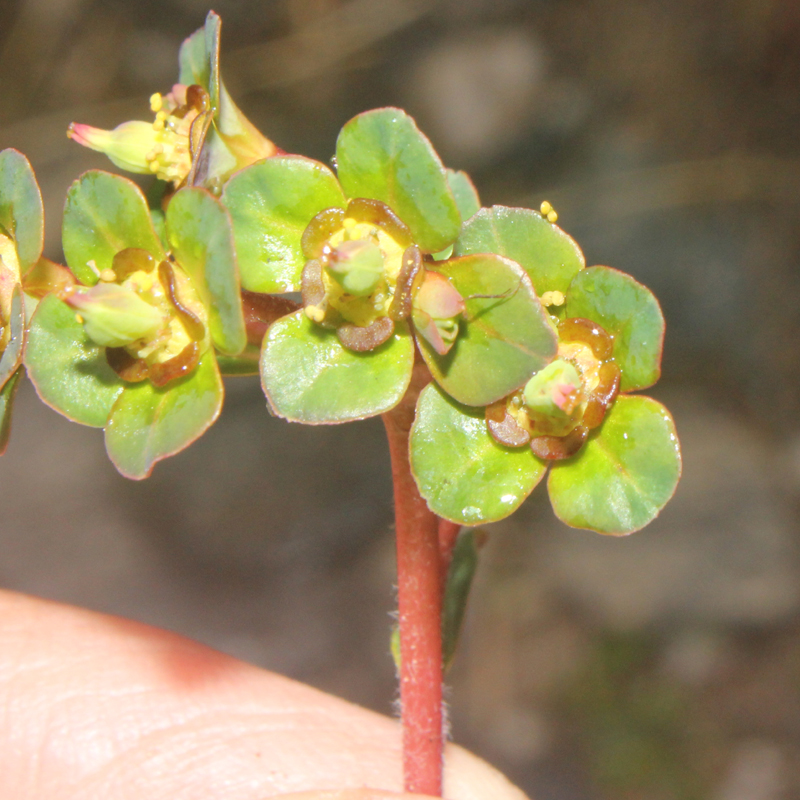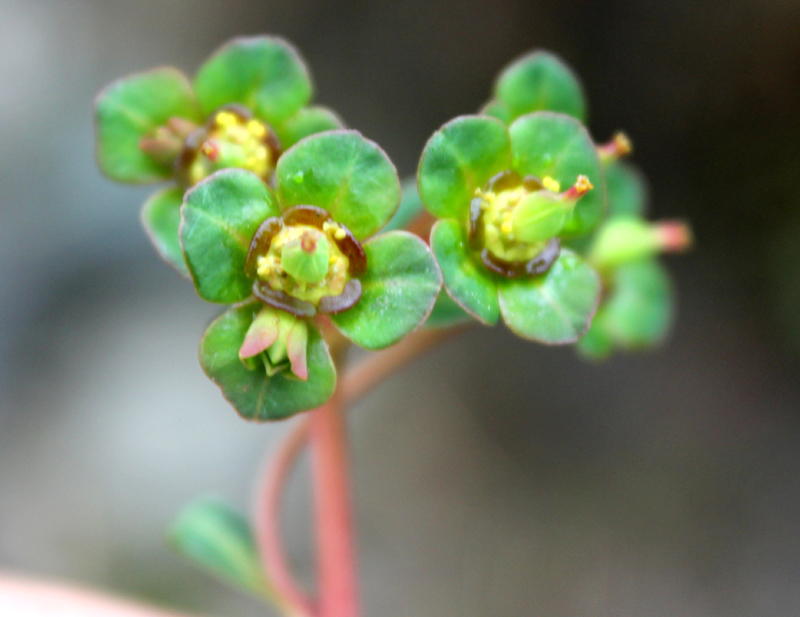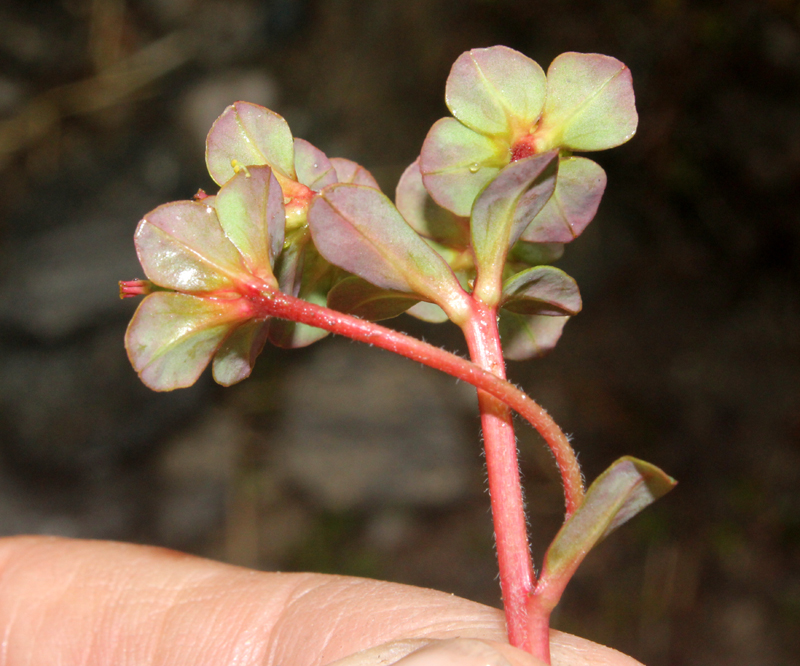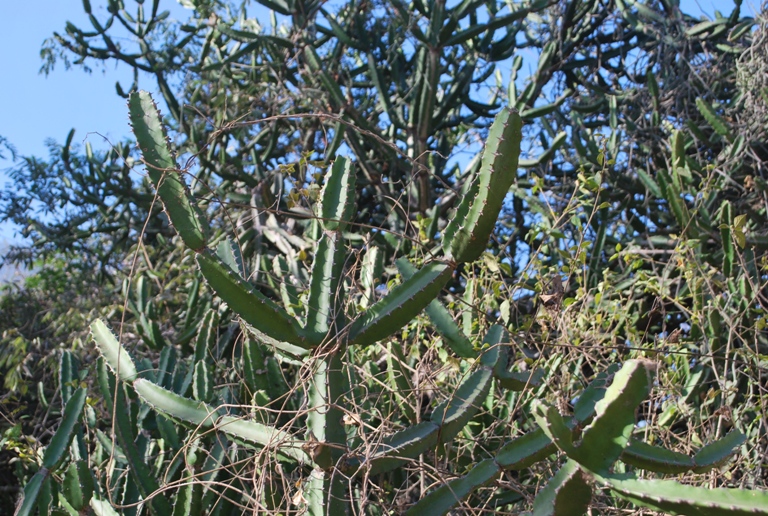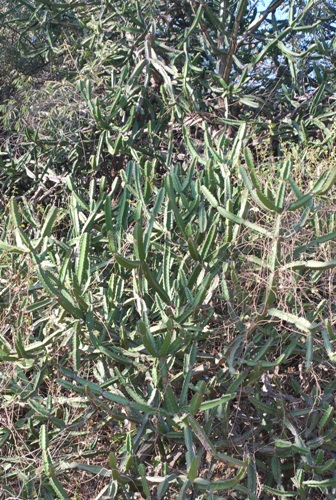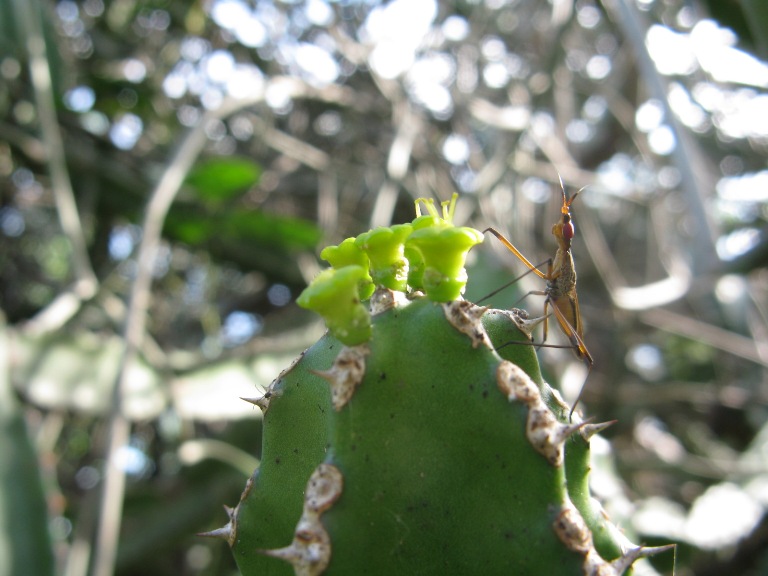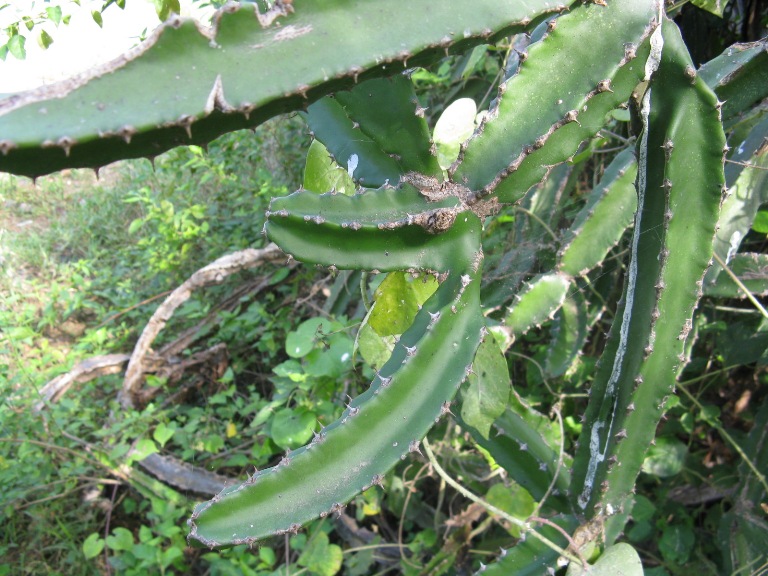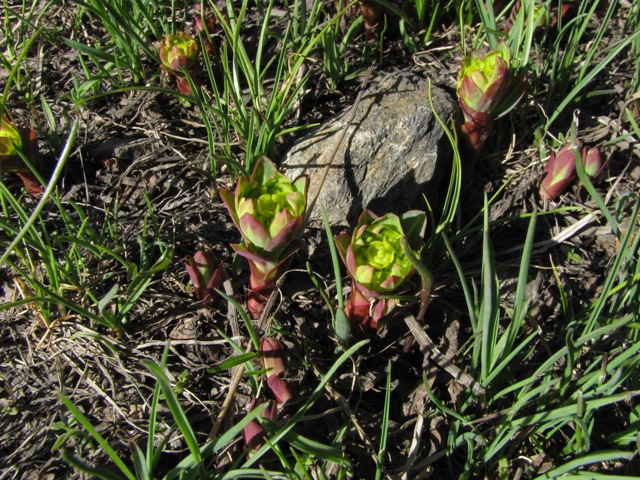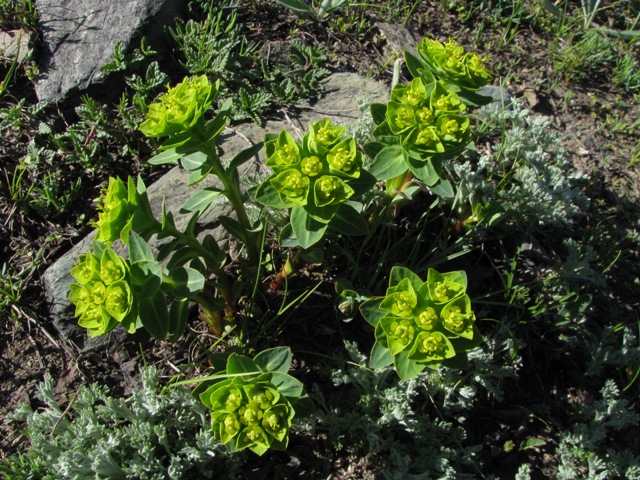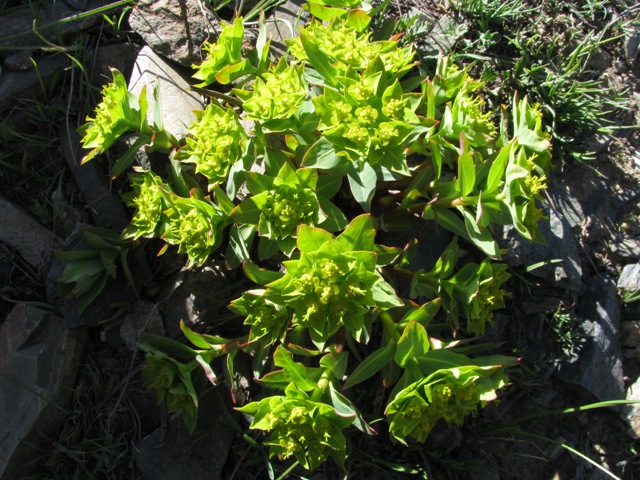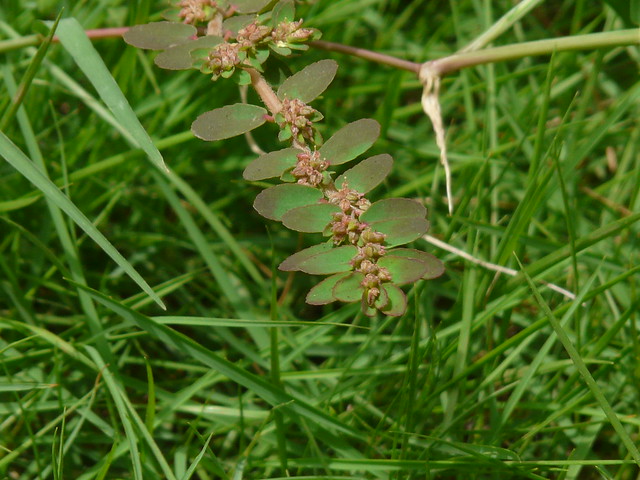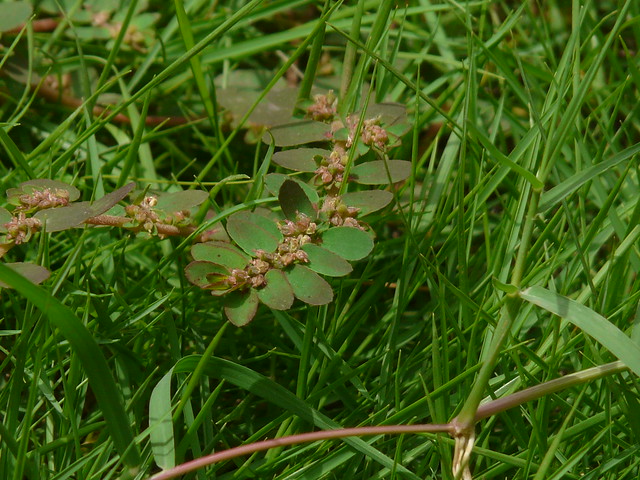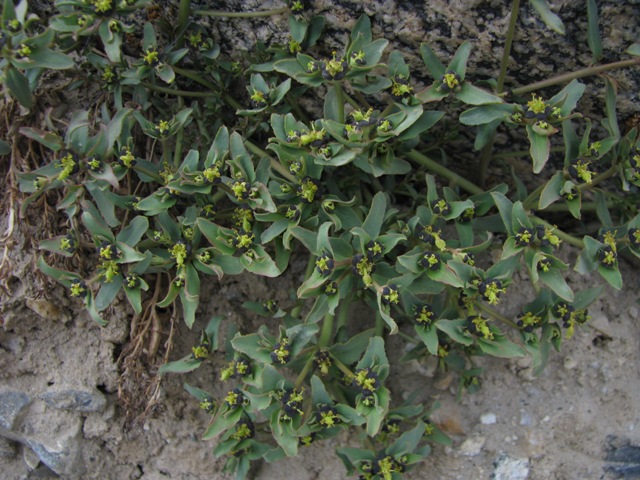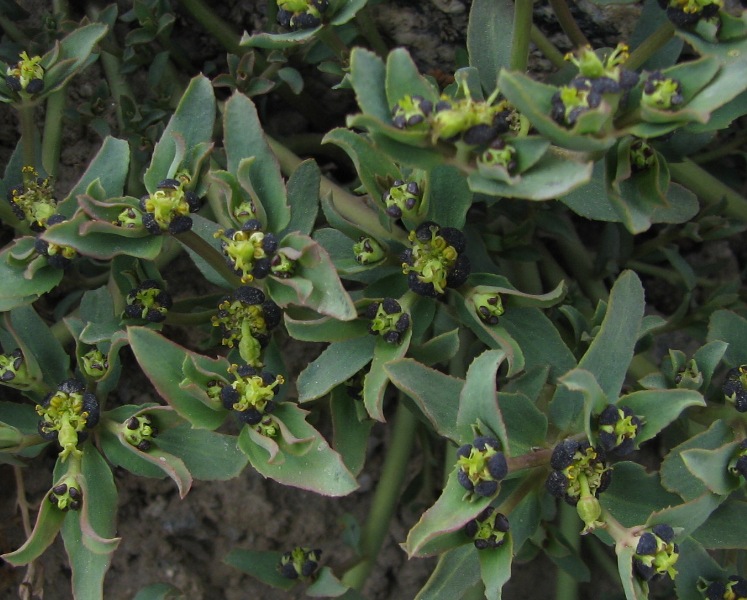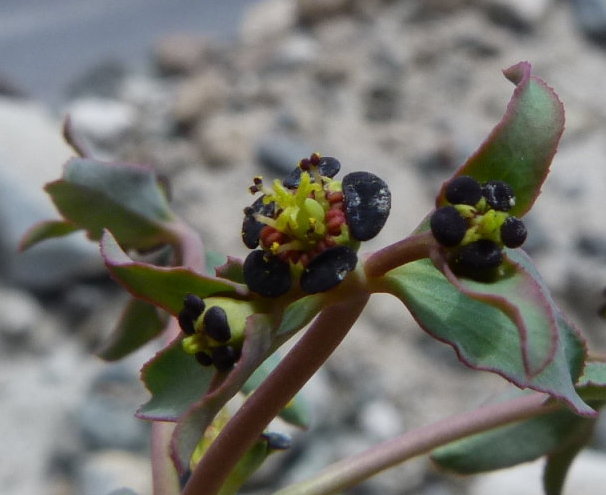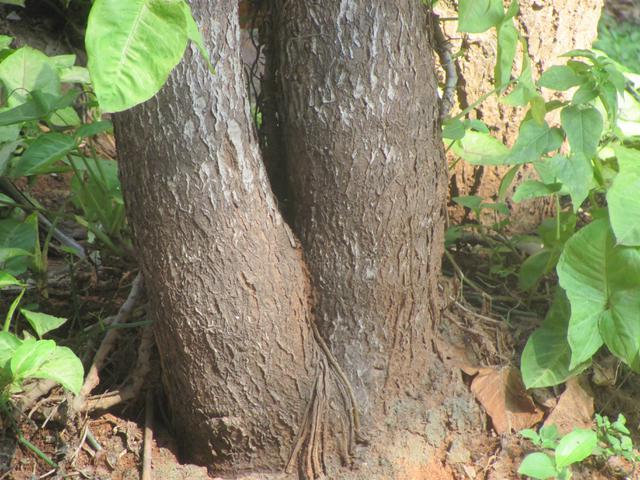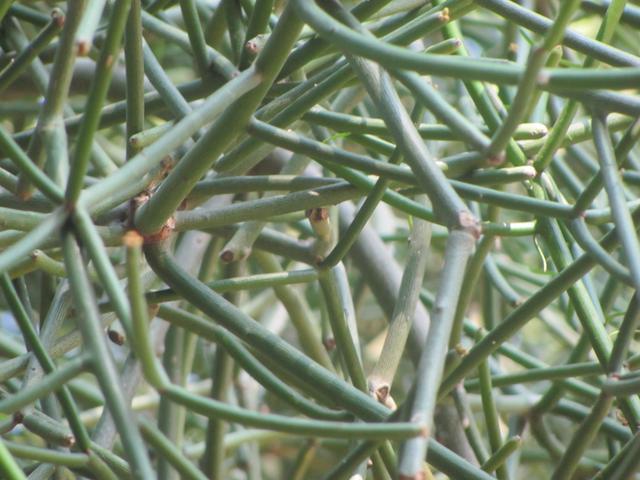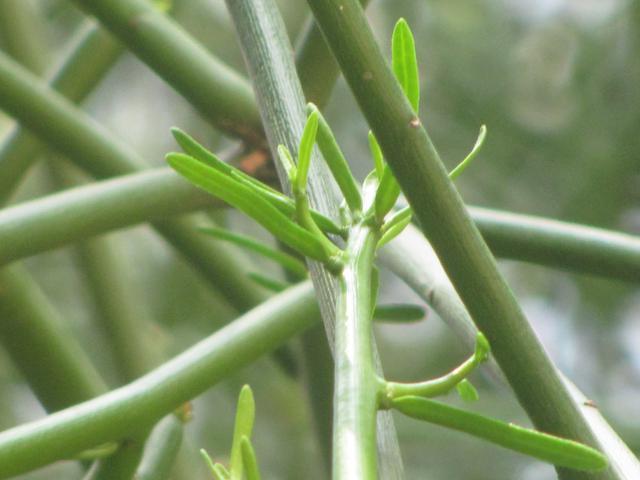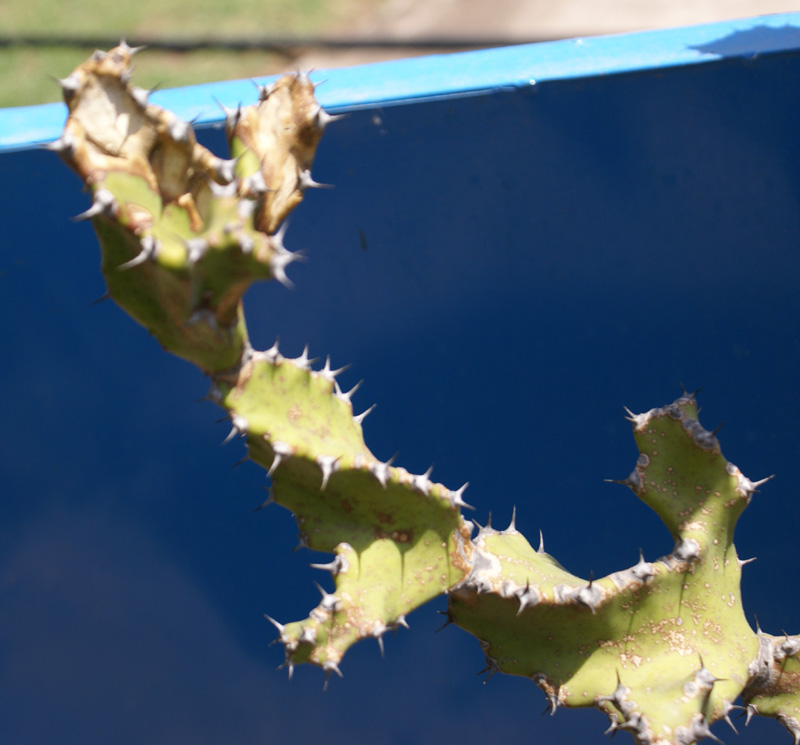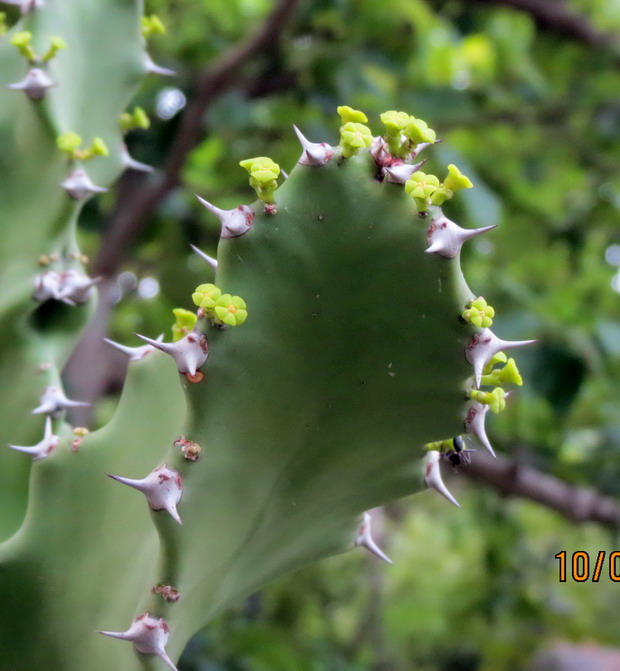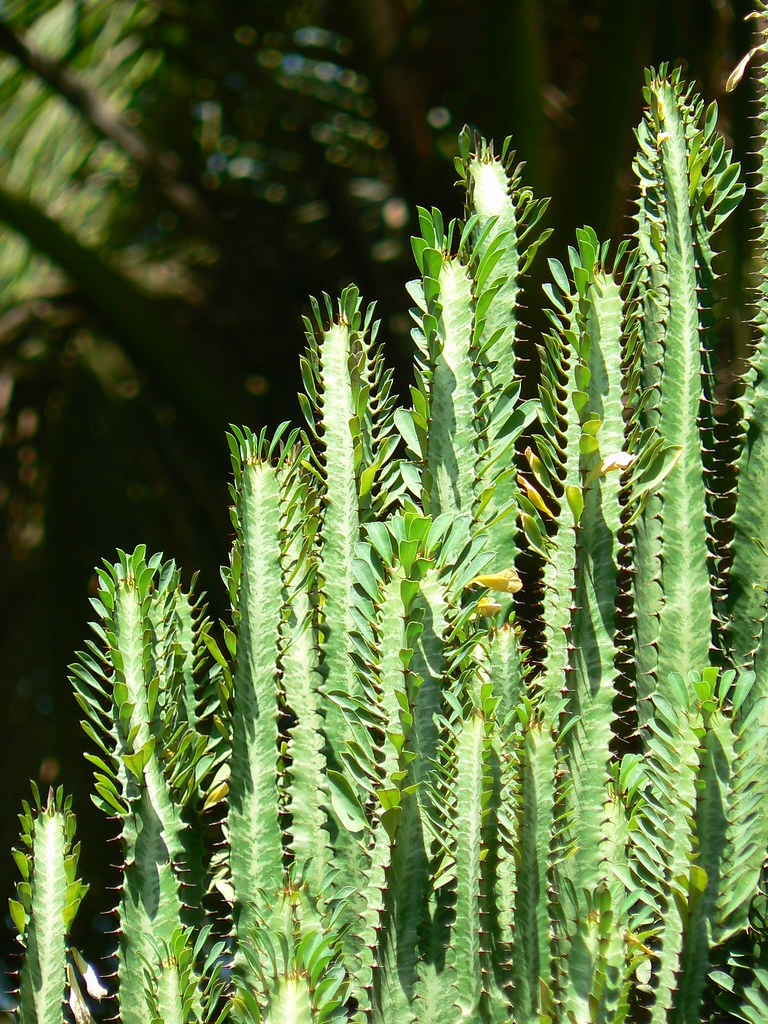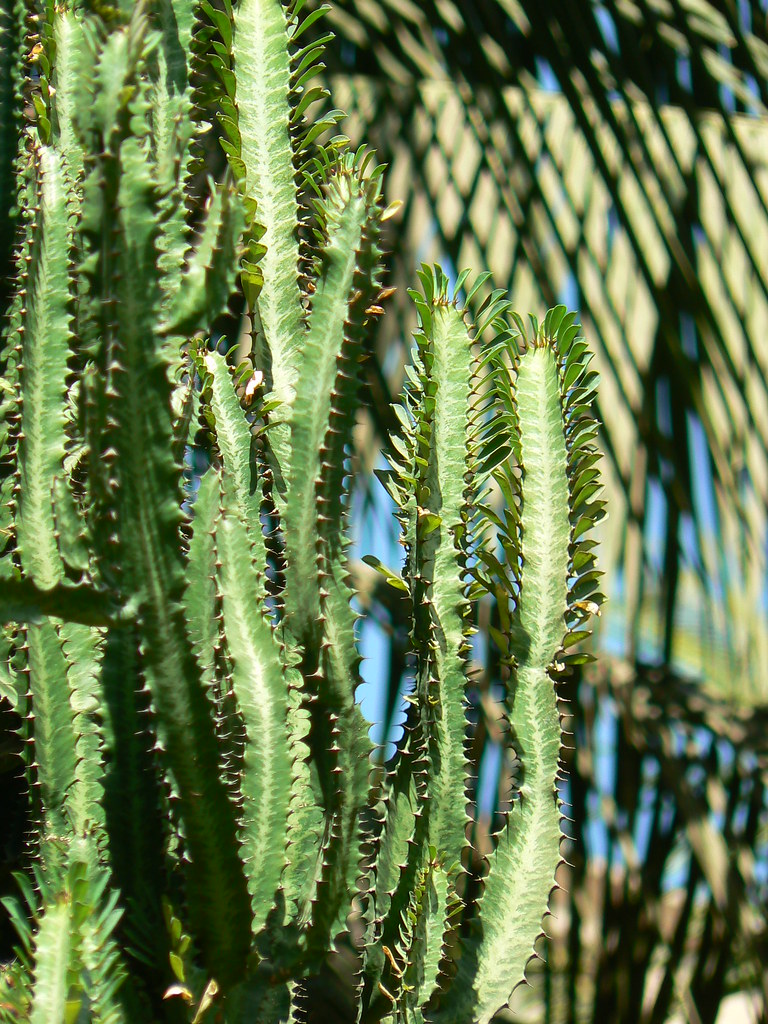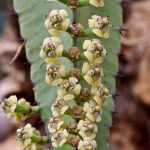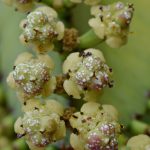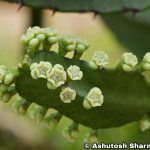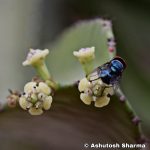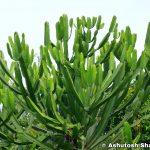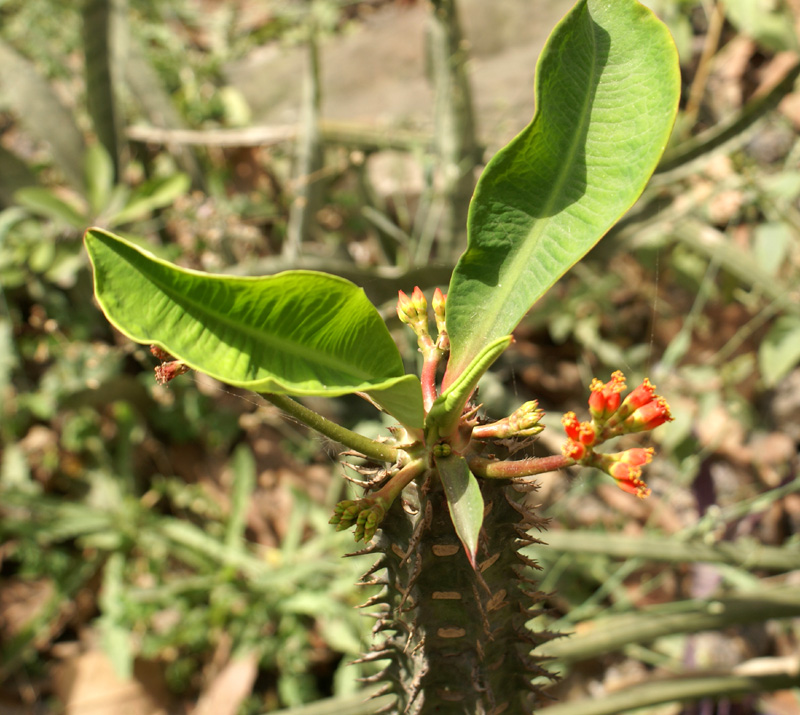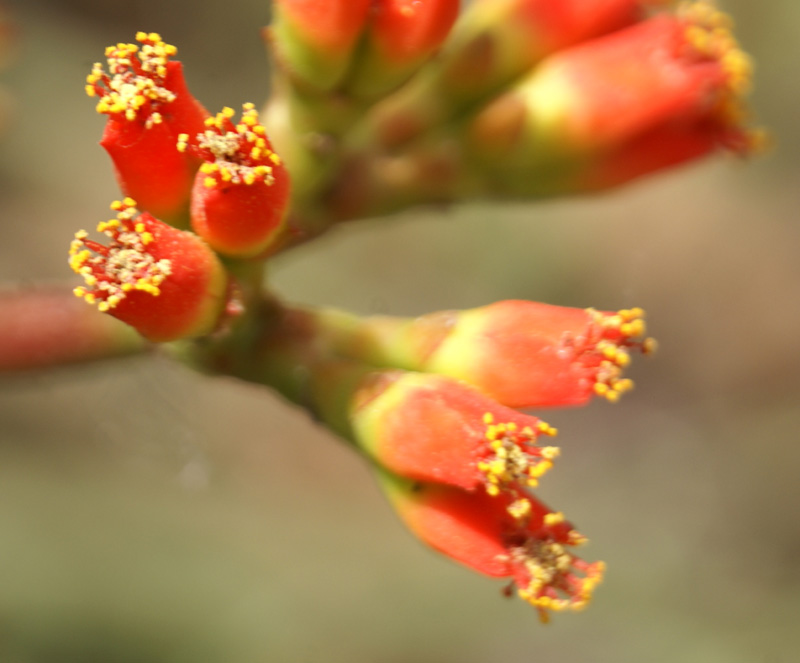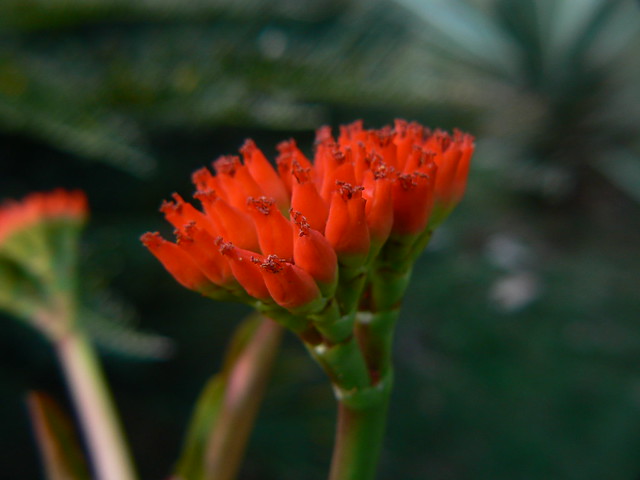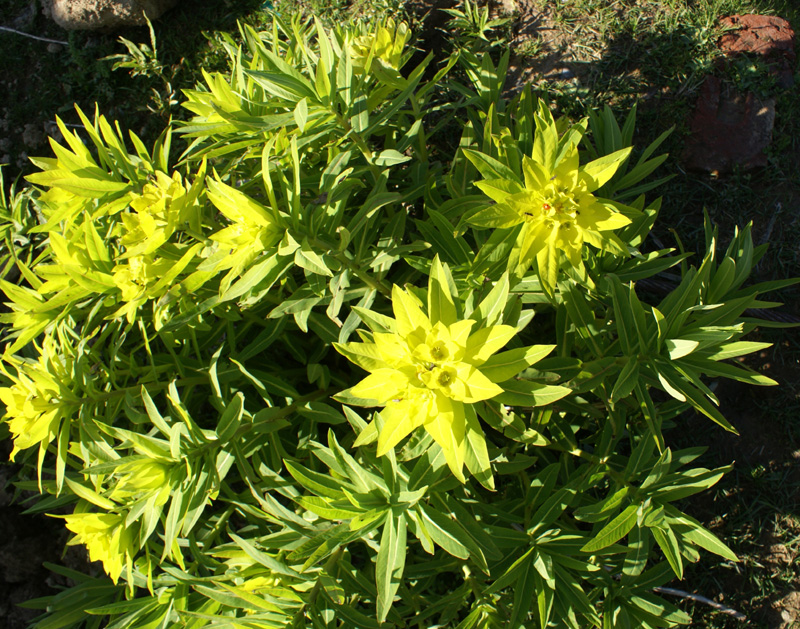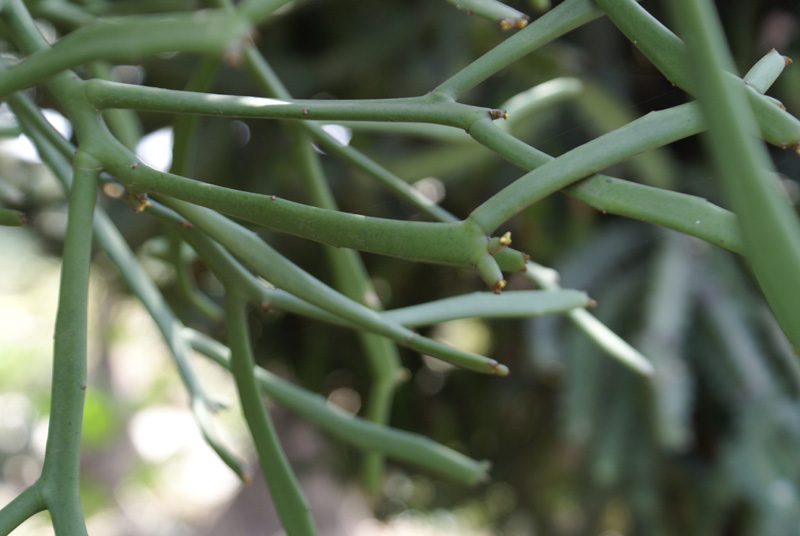Euphorbia cashmeriana Royle
Euphorbia clarkeana Hook.f. (Afghanistan to India, Maldives: Afghanistan, India, Maldives, Pakistan, West Himalaya as per POWO)
Euphorbia cristata B.Heyne ex Roth (Indian subcontinent to Thailand: Bangladesh, India, Myanmar, Sri Lanka, Thailand, West Himalaya as per POWO)
Euphorbia gottlebei Rauh (Cultivated)
Euphorbia katrajensis Gage (India (Maharashtra) as per POWO)
Euphorbia lakshminarasimhanii Nilesh V. Malpure, Prashant S. Raut, Arun N. Chandore, Bruce E. De Jong (Maharashtra)
Euphorbia meloformis Aiton (Introduced)
Euphorbia procumbens Mill. (Cultivated)
Euphorbia pseudosikkimensis (Hurus. & Yu.Tanaka) Radcl.-Sm. (Himalaya to S. Tibet: East Himalaya, Nepal, Tibet, West Himalaya as per POWO)
Euphorbia vajravelui Binojk. & N.P.Balakr. (SW. India as per POWO)
.
Revised identification key for woody species of Euphorbia: by Dr. Gurcharan Singh
Stems unarmed; without stipular spines
All leaves of same colour Leaves longer than 8 cm, green…….E. umbellata Leaves up to 8 cm long Stem and leaves uniformly red, leaves in whorls of three, petiole almost as long as blade, leaves ovate, apex acute to obtuse……E. cotinifolia subsp. cotinoides
Stem and leaves green, leaves alternate, petiole much shorter than blade Leaves shorter than 2 cm, less than 2 mm broad, branches straight, mostly leafless (leaves early deciduous) Branches flattened……….E. xylophylloides
Branches not flattened……….E. tirucalli
Leaves longer than 3 cm, more than 2 cm broad, branches zigzag, mostly with leaves…… E. tithymaloides All leaves not of same colour; lower leaves green, upper partly or uniformally coloured; leaves longer than 8 cm Leaves below the inflorescence uniformally coloured (red, white or yellow); leaves not lobed.E. pulcherrima Leaves below the inflorescence coloured only at base; leaves lobed or not Base of upper leaves pale green or pale white; leaves lobed or not……….E. heterophylla Base of upper leaves red; leaves lobed………E. cyathophora Stems armed with spines Branches spine-tipped………E. stenoclada
Branches not spine-tipped Spines borne singly on stem or wings
Spines on stem , not flattened, usually longer than 1 cm; two showy bracts around cyathium……..E. milii
Spines on wings, somewhat flattened, showy bracts absent
Leaf scars semilunar with distinct gap from wings, sparsely distributed, peduncle longer,
spines often projecting and longer than 1 cm………E. viguieri
Leaf scars transversely oblong, almost touching wings, closely placed, peduncle shorter.
spines mostly shorter than 1 cm……….E. neohumbertii
Spines borne on raised shield, usually shorter than 1 cm, two showy bracts lacking Stem rounded, not angled or winged Shrub without trunk with branches arising from base, smaller leaves (3-8 cm long) and longer spines 0.5-1 cm………….E caducifolia Tree with distinct trunk, leaves 10-25 cm long, spines shorter than 0.5 cm……….E. nivulia Stem angled or winged Angles not produced into wing, spirally arranged:……..E. neriifolia Angles produced into wings Wings 3-4 The wings running straight, sinuate, regularly dentate Trees taller than 4 m; stems usually 4-angled; spines absent or minute…….E. ingens
Shrubs or small trees less than 4 m tall, usually 3-angled; spines longer than 4 mm
Stems green without white bands
Leaves usually clustered, rarely seen; spines black………E. antiquorum
Leaves spaced, mostly present; spines grey-brown ……….E. trigona
Stems white wholly or partially The stems with white bands on faces Branches ascending, parallel to and close to the main stem
leaves obovate-elliptic, 10-30 mm long……..E. trigona.
Branches ascending but not parallel to and close to the main
stem. Leaves scale-like, c. 4 mm long.
Apex of stem not cristate (without crowns at tips)………..E. lactea
Apex of stem cristate (with crowns at tips)….E lactea cv. ‘Cristata’ The stems uniformly greyish white………………..E. lactea cv. ‘White Ghost’ The wings running spirally, …………E. tortilis Wings 5-6, undulate………..E. royleana Key in Bracketed Format Revised identification key for woody species of “Euphorbia: by Dr. N. Balakrishnan
1a. Stems unarmed, without stipular spines 2 b. Stems armed with spines 9 2a. All leaves not of the same colour; lower leaves green, upper partly or uniformly coloured 3 b. All leaves all of the same colour 5 3a. Leaves below the inflorescences red, yellow, cream-coloured or white; leaves not lobed E. pulcherrima b. Leaves below the inflorescences coloured only at base; leaves lobed or not 4 4a. Bases of upper leaves red; leaves lobed E. cyathophora b. Bases of upper leaves pale green or pale white; leaves lobed or not E. heterophylla 5a. Leaves more than 8 cm long E. umbellata b. Leaves less than 8 cm long 6 6a. Stem and leaves uniformly purplish red when young to greenish pink when mature; leaves in whorls of three, petiole almost as b. Stem and leaves always green; leaves alternate; petioles much shorter than leaf-blade 7 7a. Leaves longer than 3 cm, more than 2 cm broad; branches zigzag, usually with leaves E. tithymaloides b. Leaves shorter than 2 cm, less than 7 mm broad, early caducous; branches straight, usually leafless 8 8a. Branches flattened E. xylophylloides b. Branches cylindrical E. tirucalli 9a. Branches spine-tipped E. stenoclada b. Branches not spine-tipped 10 10a. Spines borne singly on stem or wings 11 b. Spines borne on raised shield, usually shorter than 1 cm 13 11a. Spines on stem not flattened, showy bracts present below cyathia E. milii b. Spines on wings of branches somewhat flattened, showy bracts absent 12 12a. Leaf-scars semilunar, with distinct gap from wing-margins, sparsely distributed; peduncle longer; spines often projecting b. Leaf-scars transversely oblong, extending from one wing-margin to the other, closely placed; peduncles shorter, spines mostly shorter than 1 cm E. neohumbertii 13a. Stem rounded, not angled or winged 14 b.. Stem angled or winged 15 14a. Shrubs without trunk; branchlets arising from base; leaves small, 3 – 8 cm long; spines long, 0.5 – 1 cm long E.caducifolia b. Trees with distinct trunk; leaves large, 10 – 25 cm long; spines short, up to 5 mm long E. nivulia 15a. Angles not produced into wings, spirally arranged E. neriifolia b. Angles produced into wings 16 16a. Wings of branches 5 – 6, undulate E. royleana b. Wings of branches 3 – 4 17 17a. Wings of branches running spirally E. tortilis b. Wings of branches running straight, sinuate, regularly dentate 18 18a Trees taller than 4 m; stems usually 4-angled; spines absent or minute E. ingens b. Shrubs or small trees less than 4 m tall, usually 3-angled; spines longer than 4 mm 19 19a. Branches green, without white bands 20 b. Branches white, wholly or partially 21 20a. Leaves usually clustered, rarely seen; spines black E.antiquorum b. Leaves spaced, usually present; spines grey-brown E. trigona 21a. Branches uniformly greyish white E. lactea cv. White Ghost b. Branches not uniformly greyish white, but with patches of white bands in valleys between wings 22 22a. Branches ascending, parallel to and close to the main stem; leaves obovate-elliptic, 10 – 30 mm long E.trigona b. Branches ascending but not parallel to and close to the main stem; leaves scale-like, ca 4 mm long 23 23a. Apex of stem not cristate (without crowns at tips) E.lactea b. Apex of stem cristate (with crowns of tips E. lactea cv. Cristata
.
Euphorbiaceae Fortnight: An updated key to Woody species of Euphorbia in India : 1 post by 1 author.
A key to the identification of woody species of Euphorbia occurring in India and introduced species in Gardens was prepared by me in 2011 and underwent alot of discussion in which …, … and others participated actively
The discovery of several more species in two years made it necessary to further revise the key. This has been uploaded on our website in indented key format.
Dr. N. Balakrishnan has been kind enough to revise and set the key in bracketed key format. Both versions are available on our website. Members can make use of the format which suits them.
.
Species as per Flora of India Vol 23 (Editors N. P. Balakrishnan, T. Chakrabarty, M. Sanjappa, P. Lakshminarsimhan & P. Singh- by Botanical Survey of India (2012)):
Euphorbia agowensis Hochst ex Boiss. var. agowensis 301 var. pseudoholstii (Pax) Bally & S.Carter Euphorbia antiquorum L. Euphorbia balakrishnanii Binojk. & R.Gopalan
Euphorbia boissieriana (Woronow) Prokh. Euphorbia caducifolia Haines Euphorbia cashmeriana Royle Euphorbia cattimandoo Elliot ex Wight
Euphorbia clarkeana Hook.f. Euphorbia coccinea B.Heyne ex Roth Euphorbia concanensis Janarth. & S.R.Yadav 281agowensis Hochst ex Boiss.
Euphorbia cornigera Boiss.
var. cornigera var. cognata (Klotzsch ex Klotzsch & Garcke) Binojk. & N.P.Balakr. Euphorbia corrigioloides Boiss. Euphorbia cotinifolia L. ssp. cotinoides (Miq.) Christenh.
Euphorbia cristata B.Heyne ex Roth Euphorbia cyathophora J.Murr. Euphorbia deccanensis V.S.Raju var. deccanensis var. nallamalayana (J.L.Ellis) V.S.Raju Euphorbia donii Oudejans Euphorbia dracunculoides Lam.
Euphorbia elegans Spreng. Euphorbia epiphylloides Kurz
Euphorbia erythroclada Boiss.
Euphorbia falcata L. Euphorbia fulgens Karw. ex Klotzsch (Cultivated) Euphorbia fusiformis Buch.-Ham. ex D.Don var. fusiformis 332 var. khandallensis (Blatt. & Hallb.) Binojk. & N.P.Balakr. Euphorbia grandicornis Goebel ex N.E.Br. (Cultivated) Euphorbia granulata Forssk. Euphorbia helioscopia L. Euphorbia heterophylla L.
Euphorbia heyneana Spreng. ssp. heyneana ssp. nilagirica (Miq.) Panigrahi Euphorbia hirta L.
Euphorbia hispida Boiss. Euphorbia hypericifolia L.
Euphorbia hyssopifolia L.
Euphorbia indica Lam.
Euphorbia jacquemontii Boiss. Euphorbia jodhpurensis Blatt. & Hallb. Euphorbia kanaorica Boiss. Euphorbia katrajensis Gage Euphorbia khasyana Boiss. Euphorbia lacei Craib Euphorbia laciniata Panigrahi Euphorbia lactea Haw. Euphorbia lathyris L. Euphorbia lawsonii Binojk. & Dwarakan Euphorbia leucocephala Lotsy Euphorbia longistyla Boiss. Euphorbia luteoviridis D.G.Long Euphorbia maddenii Boiss.
Euphorbia marginata Pursh (Cultivated)
Euphorbia mauritanica L. Euphorbia meenae S.Carter Euphorbia micractina Boiss. Euphorbia milii Des Moul. Euphorbia nana Royle Euphorbia neriifolia L. Euphorbia nivulia Buch.-Ham. Euphorbia notoptera Boiss.
Euphorbia osyridea Boiss. Euphorbia pallens Dillwyn Euphorbia pamirica (Prokh.) Prokh.
Euphorbia peltata Roxb. Euphorbia peplus L.
Euphorbia perbracteata Gage
Euphorbia prolifera Buch.-Ham. ex D.Don Euphorbia prostrata Aiton
Euphorbia pulcherrima Willd. ex Klotzsch
Euphorbia pycnostegia Boiss.
var. pycnostegia var. zornioides (Boiss.) Santapau Euphorbia rosea Retz. Euphorbia rothiana Spreng. Euphorbia royleana Boiss. Euphorbia santapaui A.N.Henry Euphorbia sebastinei Binojk. & N.P.Balakr. Euphorbia senguptae N.P.Balakr. & Subr. Euphorbia serpens Kunth Euphorbia sharmae U.C.Bhattach. Euphorbia sikkimensis Boiss. Euphorbia stracheyi Boiss. Euphorbia susan-holmesiae Binojk. & R.Gopalan Euphorbia thomsoniana Boiss. Euphorbia thymifolia L. Euphorbia thyrsoidea Boiss. Euphorbia tibetica Boiss. Euphorbia tirucalli L. Euphorbia tortilis Rottler ex Ainslie Euphorbia trigona Mill. Euphorbia vajravelui Binojk. & N.P.Balakr.
Euphorbia wallichii Hook.f. .
.
. Species with description & pictures in Flowers of India as on 22.4.14:
.
. Euphorbia griffithii (Not mentioned in Flora of India Vol. 23 (2013)).
Euphorbia parviflora (Euphorbia indica Lam. Syn: E. parviflora auct. non L. 1759: Roxb. as per Flora of India Vol. 23 (2013)).
Euphorbia pseudo-sikkimens (Not mentioned in Flora of India Vol. 23 (2013)).
Euphorbia pseudosikkimensis (Not mentioned in Flora of India Vol. 23 (2013)).
. Euphorbia atoto ( ? Euphorbia pallens Dillwyn syn: E. articulata Dennst.; E. atoto auct. non G. Forst., 1786: Hook.f.; E. halophila Miq.; Chamaesyce pallens (Dillwyn) V.S.Raju as per Flora of India Vol. 23 (2013)).
Euphorbia bifida (Not mentioned in Flora of India Vol. 23 (2013)).
Euphorbia griffithii (Not mentioned in Flora of India Vol. 23 (2013)).
.
Euphorbia floral morphology Diagram: Attaching a genral Euphorbia sp. floral morphology diagram from the classic book of Botany By D. H. Lawrence. We have had a very rich contribution of the various species of Euphorbia and this thought would add to the understanding. Besides we have already had the simple keys developed and under further construction?! by … yesterday. .
A revision of geophytic Euphorbia species from India – International … (pdf) by Soumen Aditya- Euphorbia World Vol. 6 n. 1 – April 2010 .
(With Keys of
Euphorbia chamaesyce L. (? Euphorbia prostrata Aiton syn: E. chamaesyce auct. non L. 1753 as per Flora of India Vol. 23)
Euphorbia heyneana Spreng. as per Flora of India Vol. 23 (2013).
Euphorbia hypericifolia L. as per Flora of India Vol. 23 (2013).
.
Euphorbia antiquorum and its Allies – FGaS by Meena Singh (Comparision of
Euphorbia santapaui A.N.Henry,
Euphorbia susan-holmesiae Binojk. & Gopalan
. I have updated eFI (efloraofindia) page on Euphorbia in line with Flora of India Vol. 23 (2012). Species discussed so far in efloraofindia are given at the bottom of the page in the form of links against Subpages. On clicking them one can see all the details. Any comments are welcome. A great job done which will serve our nation and our purpose. .
An Excursion Flora of Central Tamilnadu, India By K. M. Matthew (1995)- Details with keys–
Euphorbia corrigioloides Boiss.
.
Indian Herbal Remedies: Rational Western Therapy, Ayurvedic, and Other … edited by C.P. Khare (2004)- Details- . Flora of Guntur District, Andhra Pradesh, India (2000)- Details with keys-
.
Flora of Ranga Reddi District Andhra Pradesh, India By T. Pullaiah, M. Silar Mohammed (2000)- Details with keys- Euphorbia chamaesyce L. (? Euphorbia prostrata Aiton syn: E. chamaesyce auct. non L. 1753 as per Flora of India Vol. 23)
. Encyclopaedia of world medicinal plants, Volume 1 By T. Pullaiah (2006)- Details-
Euphorbia chamaesyce L. (? Euphorbia prostrata Aiton syn: E. chamaesyce auct. non L. 1753 as per Flora of India Vol. 23 (2013))
Euphorbia pilosa L. (? Euphorbia cornigera Boiss. syn: E. pilosa L. var. cornigera (Boiss.) Hook.f.; E. pilosa auct. non L. as per Flora of India Vol. 23 (2013))
.
Flora of Medak District, Andhra Pradesh, India By T. Pullaiah, Chintala Prabhakar, B. Ravi Prasad Rao (1998)- Details with keys- . 1997 IUCN Red List of Threatened Plants edited by Kerry Scott Walter, Harriet J. Gillett
I have updated eFI (efloraofindia) page on Euphorbia Attempts have been made to incorporate most of the species available in India & nearby areas with details & keys directly or through links as far as possible. It’s quite possible that there may be some discrepancy in the accepted names & synonyms taken from other links. Species discussed so far in efloraofindia are given at the bottom of the page in the form of links against Subpages. On clicking them one can see all the details. Any comments/ corrections are welcome.
Thanks to Dr. N. P. Balakrishnan & Dr. Tapas Chakrabarty for the wonderful work on Euphorbiaceae. .
Re: completed insertion of images of identified species of Euphorbia : 1 post by 1 author.
Some species were done by other members / Euphorbia page (Euphorbiaceae) with images of species in efloraofindia : 6 posts by 2 authors.
Pl. go through Euphorbia page (Euphorbiaceae) with images of species in efloraofindia (done mainly by …). If you find any mis-identification, pl. let us know. . Euphorbia, Kalli: Some postings were referring to “Kalli” a while back, stating that it is a name used for many plants including several genera. I have tried to sort one genus: Euphorbia. “Kalli” is indeed part of the names for most species but as I have pointed out before the significant word is not “Kalli” but what is attached to it: the epithet. I have tried to provide Tamil transcriptions for some of the existing names: Euphorbia antisyphilitica Zucc. TAMIL : Meḻuku kaḷḷi = மெழுகு கள்ளி Kalli is a word in tamil generally used for plants that are cacti or more Xerophytes. Discussing: “Finally if you know how to quote the string of postings related to this topic, please let me know.”
At 4th point, if you were to select your own (original) post, the link associated would be for the entire thread. Thank you to all respondents. I have made all the corrections and additions. We still need some Gujarati, Malayalam, Oriya and Telugu names. Any volunteer? It is already very good as it stands but some added scripted names in those languages would make it great. . |
Euphorbia
Updated on December 24, 2024


